S[æ]itenanschläge (String/Site stops)
The KKI's Online Magazine
(since 2022)

[Volume 2024]
[Volume 2023]
[Volume 2022]
[Volume 2024]
Find of the month from the KKI archive _ June 2024

"Das Fußballmatch [The football match]" (Sheet music edition), Marschfox (for voice), Music: Hans Lang, Arrangement: Otto Tiersfeld, Words: Erich Meder, Schrammel Quartett Collection Nr. 326, Vienna: Ludwig Doblinger Verlag 1948 (no page reference).
The European Men's Football Championship kicks off in Germany in just a few days. From mid-June to mid-July, the major event will keep fans from all over the world on the edge of their seats. (Popular) music will once again play a major role, whether live or as playback at the opening and farewell ceremonies, at the start of each international match when the various national anthems are played, as canned music during breaks or in the form of fan chants in the stadium. But there will also be plenty of music in the streets and squares around the stadium, as the music industry offers many football songs for the public to party to. The search is on for the latest football hit for the "new summer fairytale".
You don't have to rely on the latest music productions. You can also help yourself to older hits if you like. For example, we have "Das Fußballmatch [The football match]" from 1948 on offer. This light-hearted piece is presented in Viennese dialect and was written by the composer Hans Lang (1908-1992), who wrote a lot of film music, entertaining pieces and Viennese songs. The lyricist was Erich Meder (1897-1966), also from Austria, who contributed the words to numerous hits and Viennese songs. The text deals with the suffering of a fan who has to watch his team lose.
Such cheerful songs about football are not uncommon. A long tradition of ironic and unintentionally comical pieces, some performed by football greats themselves, extends right up to the present day. Who doesn't fondly remember Franz Beckenbauer's "Gute Freunde kann niemand trennen" from 1966 or the "Mexico mi amor" sung by Peter Alexander and the German national team for the 1986 World Cup in Mexico? The "local" hit by Bremen's showpiece Brazilian Ailton is also unforgettable. With "Sensation" from 2012, Werder's ex-"Kugelblitz" achieved a similar feat when he told the green and white supporters about his own striker qualities, singing in a mix of Portuguese and German.
Find of the month from the KKI archive _ May 2024

Lieder zur Feier der Leipziger Schlacht, in der Nacht des 18. Octobers zu singen. Amorbach: Hofbuchdrucker Volkhardt (ca. 1814). [Songs to celebrate the Battle of Leipzig, to be sung on the night of October 18. Amorbach: Hofbuchdrucker Volkhardt (ca. 1814)].
It is a truism that history repeats itself or runs in cycles. Wars are always followed by periods of peace, which in turn are followed by wars. The current situation in Ukraine is a ruthless reminder of this universal historical phenomenon. The war there is having a direct impact on Germany and the city state of Bremen in the form of war refugees. We have also long been militarily involved in Vladimir Putin's Russian war of aggression, as we are sending weapons to the Ukrainians and offering them humanitarian support. The impression is that a world war has already begun, in which many nations are involved or are increasingly becoming involved. There may even be a showdown in the form of a major, all-decisive battle.
211 years ago, the so-called "Battle of the Nations" took place in Leipzig, more precisely from October 16-19, 1813. More than 20 European nations faced each other in this battle. The French, Germans, Poles, Italians, Dutch, Swiss and Croats fought on Napoleon's side. The army of his opponents included Germans, Austrians, Hungarians, Czechs, Slovaks, Slovenes, Great Russians, Belorussians, Ukrainians, Latvians, Bashkirs, Kalmyks, Kyrgyz, Tatars, Swedes and Englishmen. With half a million soldiers and more than 100,000 dead, the Battle of Leipzig in 1813 is considered the largest and most costly battle in human history to date.
Napoleon was pushed back and his allied army suffered heavy losses. But there were also numerous casualties on the side of the victors. In the years that followed, the bloody encounter was regularly commemorated, usually on the anniversary of the victory or decision, on the night of October 18/19. In addition to commemorative publications, songbooks with patriotic songs were also published to mark the occasion. One of these songbooks is in our collection. It is currently the oldest original that is archived at the KKI. We house a large number of songbooks, be they workers', peasants', children's, folk or war songs. Most of them were collected by our namesake Klaus Kuhnke, who also published songbooks himself.
The "Songs to Celebrate the Battle of Leipzig" is a small volume or rather a small collection of seven patriotic songs in which the "Germans" or the "Fatherland" are sung, even though Germany did not yet exist as a nation, but rather small states that had joined together to form alliances (e.g. the Confederation of the Rhine or the German Confederation). The seven (new) songs are presented in text form only, i.e. without sheet music. So that they could be sung, suggestions of (at the time) well-known songs or melodies are given in brackets. For example, the melody of "Vom hoh'n Olymp herab" is suggested for the "Lied zur Nachtfeier der Leipziger Schlacht" or the melody of "God save the king" for "Der Bund fürs deutsche Vaterland". The "Vaterlandslied der Teutschen" is to be sung to the melody of "Auf, auf Kameraden" and the "Teutsche Volkslied" on "Heil unserm Bunde, Heil". The specific publication date of the small work is not given. Instead, the song "Siegesfeyer. Zu singen bey der nächtlichen Feyer vom 18ten auf den 19ten October 1814" indicates that it is a collection of songs for the first anniversary of the Battle of the Nations.
It is astonishing that such anniversaries and jubilees of the Battle of Leipzig have even been celebrated in the Altes Gymnasium in Bremen, i.e. on the premises of today's Hochschule für Künste (Faculty of Music). The following picture shows the program for the 100th anniversary celebrations. It is taken from the publication "Kriegserziehung im Kaiserreich: Studien zur politischen Funktion von Schule und Schulmusik 1890-1918". The two-volume book by Heinz Lemmermann was published in 1984 by ERES-Verlag in Lilienthal near Bremen. The carefully compiled documentation clearly shows how our forefathers were already educated for war during their school years. Without this war-glorifying pedagogy, the two world wars would probably not have been possible.

Find of the month from the KKI archive _ April 2024

Schifkof: "Bild und Ton [Image and Sound]" (3 vinyl records), Nr.11/250, Schwerin: Verlag Der Laden 1991.
We recently received a package containing audio and graphic material from Schifkof. Schifkof was a group of artists that formed during the reunification period and lasted for about 10 years. The participants included visual artists and musicians, more specifically Udo Dettmann, Andrea Häfer, Andreas Hartrodt, Hans Hermann Hennig, Silke Hennig and Ulf Rickmann; Reinhard Lippert joined later. "As we came from Hamburg and Schwerin, i.e. from the GDR and the FRG, a so-called German-German group of artists was formed, with the aim of presenting acoustic and visual works on an equal footing. We described our works as optophonic installations," reads the accompanying letter. This indicates the genre of art: it is sound art or installations/performances with experimental music and sound elements. One could also speak of audio pieces that relate to images and texts or vice versa.
"Bild und Ton [Image and Sound]" is presented here as an example. The "sound document on three optophonic image installations by Udo Dettmann and the Schifkof group" consists of a limited edition box (250 copies) with three vinyl records and an accompanying booklet with black and white photos and texts. Each of the three records contains a piece or a live performance. The titles are: 1) Ist Schulz Wagner, 2) Ich möchte dein Hund sein, 3) Heimatklänge. The three pieces have an average length of around 50 minutes and are each spread over two 25-minute sides. Conspicuous stylistic devices are horizontal soundscapes, recorded audio snippets from radio or television broadcasts and discreetly orchestrated sections, some with spoken or sung lyrics. In addition to the synthesizer and piano, electric and bass guitars are also used, as well as drums, a cello and a zither. Sounds are also produced with the help of a slide projector, a coffee machine and a printer. Various "toys" are also used to create sounds. The pieces develop slowly and are sparsely structured. Eruptive outbursts are largely absent. The concentrated, dynamically differentiated basic mood is atmospheric and invites the listener to immerse themselves in the intense listening experience.
Is this popular music? Not in the strictest sense, but certainly inspired by it; especially in the passages where Krautrock and free jazz borrowings become audible. In these psychedelic sections, polyrhythms and atonal sounds merge with environmental noises and voices. Patterns form from time to time. At times, one is reminded of IDM elements of electronic dance music. However, simple melodies, chord sequences or continuous beats are nowhere to be found. In any case, this is subtle media art, which is now more than 30 years old.
The following can be read in the accompanying letter about the group's approach to the creation of the pieces and the setting of the performances: "Our works were not improvised, but repeatable. Not note for note, but there were precise instructions. The form of presentation was initially concertante, the actors and the equipment were part of a sparse stage set. [...] There were a series of concerts in galleries and concert halls until the end of the 1990s."
Find of the month from the KKI archive _ March 2024


Donatas Petrošius: "Jeder Dichter wäre lieber ein Rockstar", übersetzt von Thomas Kunst, in: "Lied vom Spaziergang. Gedichte aus Litauen", hrsg. von Rūta Eidukevičienė & Hans Thill, Heidelberg: Das Wunderhorn 2024, S.167-168.
[Donatas Petrošius: "Every poet would rather be a rock star", translated into German by Thomas Kunst, in: "Song of the walk. Poems from Lithuania", edited by Rūta Eidukevičienė & Hans Thill, Heidelberg: Das Wunderhorn 2024, pp.167-168.]
Our dear friend Albert Caspari from the Bremen association Infobalt, which deals with the Baltic states of Estonia, Latvia and Lithuania, has sent us a charming poem. Es heißt "Jeder Dichter wäre lieber ein Rockstar" und stammt vom litauischen Poeten Donatas Petrošius (Jg. 1978). It was recently published in the anthology "Lied vom Spaziergang. Gedichte aus Litauen" ["Song of the walk. Poems from Lithuania"], published by the Heidelberg-based publishing house Das Wunderhorn, in the series "Poesie der Nachbarn. Dichter übersetzen Dichter" ["Poetry of the neighbors. Poets translate poets"]. The German writer/lyricist Thomas Kunst (born 1965), who has been intensively involved with popular and improvised music for some time, acted as translator of this poem with reference to popular music.
The title of the poem alone shows that it is an artistic, i.e. free and not literal, translation of the Lithuanian original. While Donatas Petrošius titled it "Kiekvienas poetas yra neišsipildžiusi roko grupė" in Lithuanian, which could be translated into German as "Every poet is an unfinished/unfulfilled rock band", Thomas Kunst preferred the more concise "Every poet would rather be a rock star".
The poem is about popular music instruments, their players and musical styles. There is talk of the "roaring drummer from the black metal scene" as well as the "bassist[s]" who throw the "meat lumps of pop" into the "fox-red maw of the audience" or the guitarist who "without playing ballads, without blues, without rock'n'roll" [...] would rather "retire to the garage" [...] and "play grunge". The poet ultimately dreams of being more than someone who 'only' knows words: "if I were a rock band and not just a speaker". He wants to create sounds and, with them, strong emotions that go beyond the spoken and written word.
Incidentally, in addition to detailed information about the author, the original text of the poem is also available in Lithuanian and a translation into English by Rimas Užgiris on this online platform: https://www.versopolis.com/poet/119/donatas-petrosius
Joint exhibition
"Archive splinters: Eating & Drinking"
with the Bremen Archive Working Group
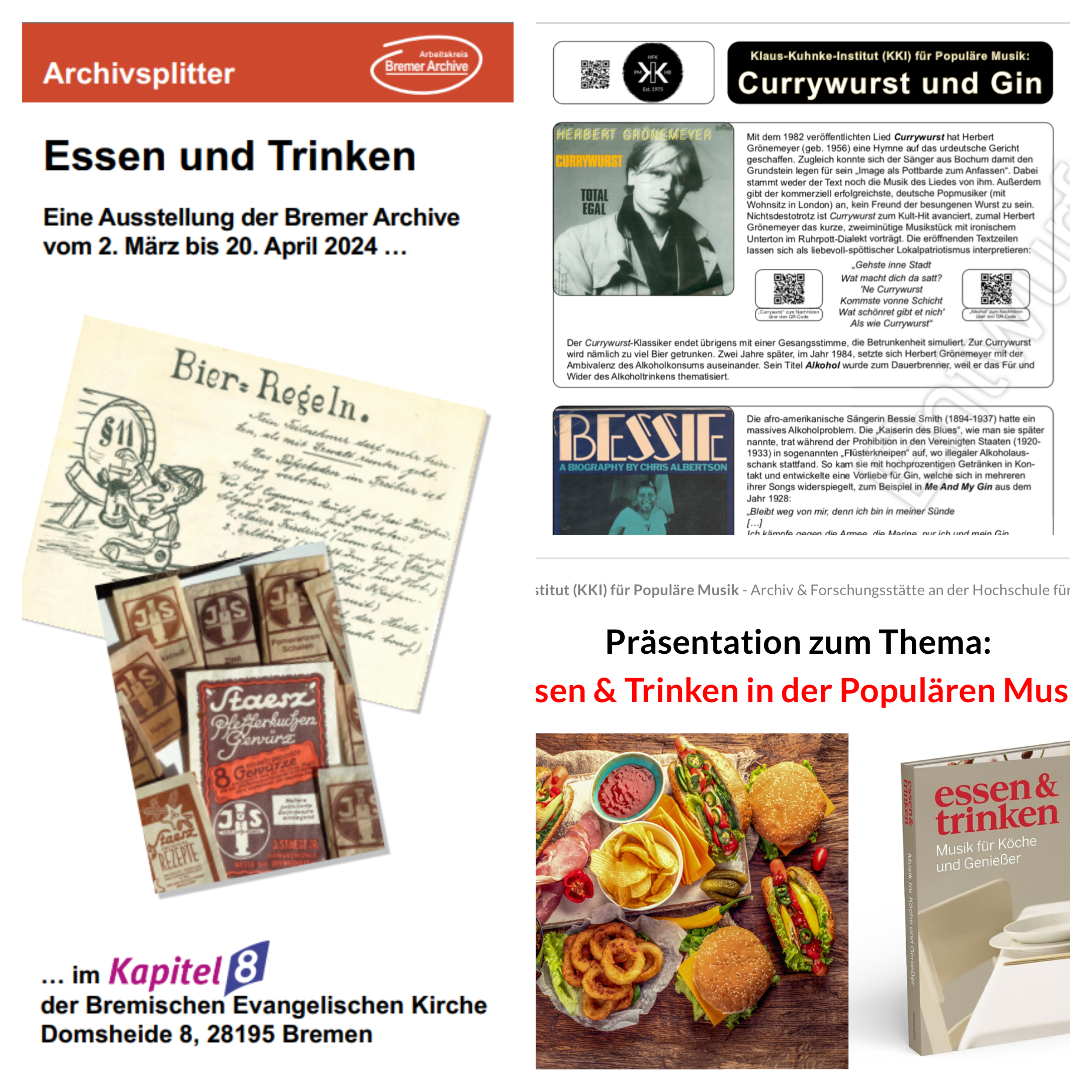
The KKI is taking part in the joint exhibition "Archivsplitter: Essen & Trinken" (Archive Splinters: Eating & Drinking) organized by the Bremen Archive Working Group. The exhibition will take place as part of the "Day of Archives" (March 2/3, 2024), an event organized by the Association of German Archivists (VdA). More information here: https://www.vda.archiv.net/tag-der-archive/startseite-2.html
The exhibition can be visited from March 1 to April 20 in "Kapitel 8" (information center of the Evangelical Church Bremen). There, the KKI will present an exhibition panel under the heading "Currywurst and Gin" and take Herbert Grönemeyer and Bessie Smith as examples. More information here: https://www.bremer-archive.de/gemeinsame-ausstellung-archivsplitter-essen-und-trinken-1-maerz-bis-20-april-2024/
The official opening of the exhibition will take place on Friday, March 1, at 5 p.m. in "Kapitel 8" (Domsheide 8). There will be finger food and drinks and the KKI will provide the appropriate background music.
Find of the month from the KKI archive _ February 2024
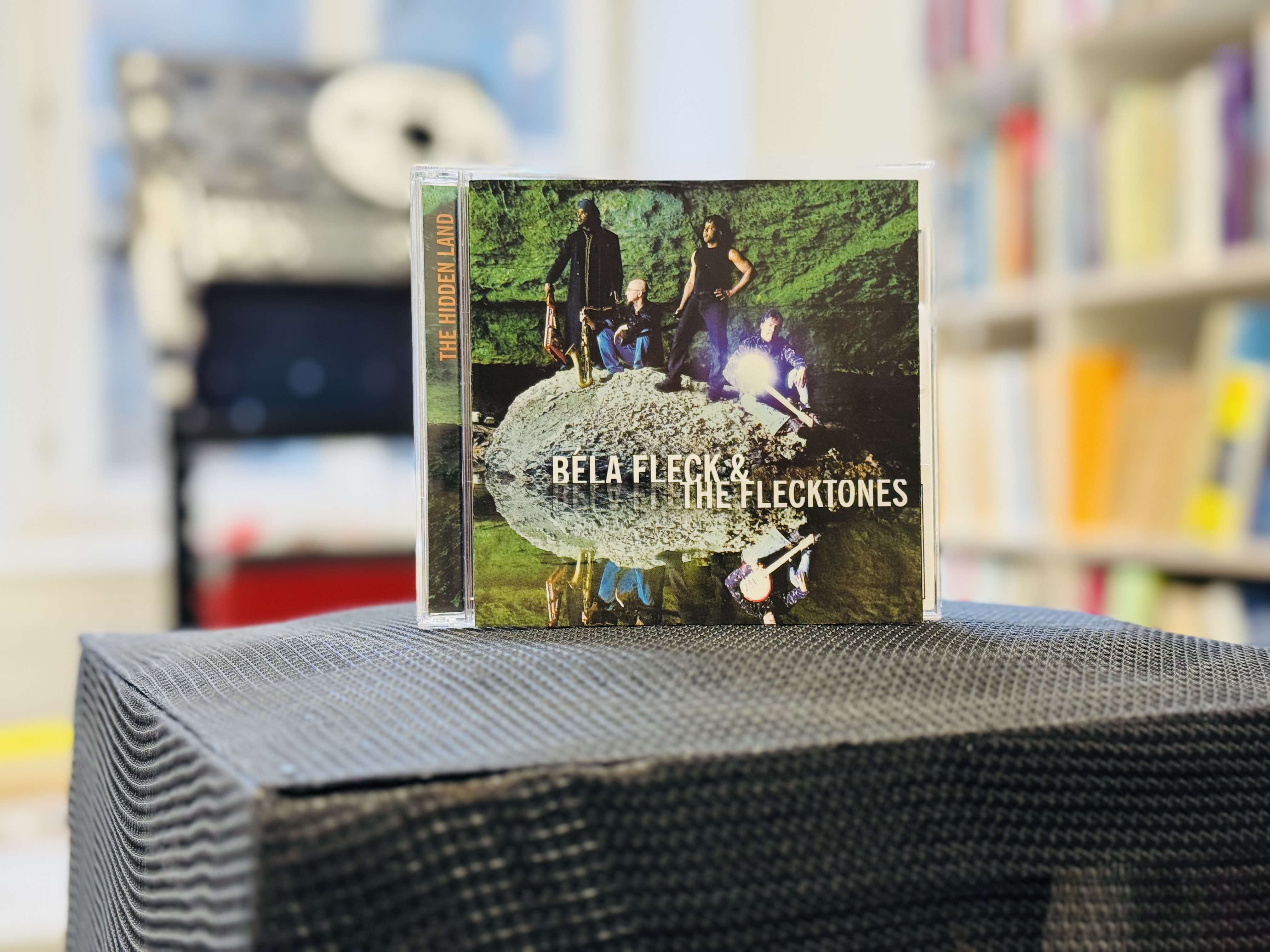
Béla Fleck & The Flecktones: "The Hidden Land" (CD), BMG 2006.
Béla Fleck is probably the best/most versatile/most famous banjo player on the planet at the moment. His traditional musical context is (progressive) bluegrass. The banjo grandmaster from New York City has ventured out of his comfort zone like no other bluegrass musician. The fact that he has been nominated for Grammy Awards in the categories Country, Pop, Jazz, Instrumental, Classical, Folk and World Music and has also won 16 Grammys speaks volumes.
He has been involved in various projects over the decades. For example, he has played live with John McLaughlin's Shakti Ensemble and recorded two duo albums with jazz pianist Chick Corea, adapted baroque and classical works by Bach, Beethoven, Chopin, Debussy, Paganini and Scarlatti for the banjo and written his own works for banjo and orchestra (recorded on several albums). He has traveled the African continent in search of the origins of the banjo, resulting in several albums, and for more than ten years he has performed regularly as a duo with his wife Abigail Washburn, an American banjo player who is at home in the clawhammer tradition and also sings. More recently, Béla Fleck has returned to his musical roots, so to speak, by gathering together old and new stars of the US bluegrass community. His latest release is an arrangement of George Gershwin's "Rhapsody in Blue" for banjo and orchestra.
With his experimental band Béla Fleck & the Flecktones, with whom he has been playing for 35 years now, he has won several Grammys, including for this album called "The Hidden Land", for which he won the coveted trophy in the "Best Contemporary Jazz Album" category in 2007. It is fusion jazz with country influences, but classical European art music is also interpreted (J.S. Bach's Fugue No. 20 in A minor, BWV 889). The unusual band line-up with Béla Fleck on banjo, Victor Wooten on electric bass, Future Man on (electric) drums and Jeff Coffin on saxophones, clarinet, flute and keyboard creates a very unique group sound. The musicians compose, improvise and interact with such ease and virtuosity that it is astonishing. This is progressive music that moves effortlessly between all stools. Not for purists!
Collection of sheet music and songbooks by Prof. Dr. Fred Ritzel (Oldenburg)
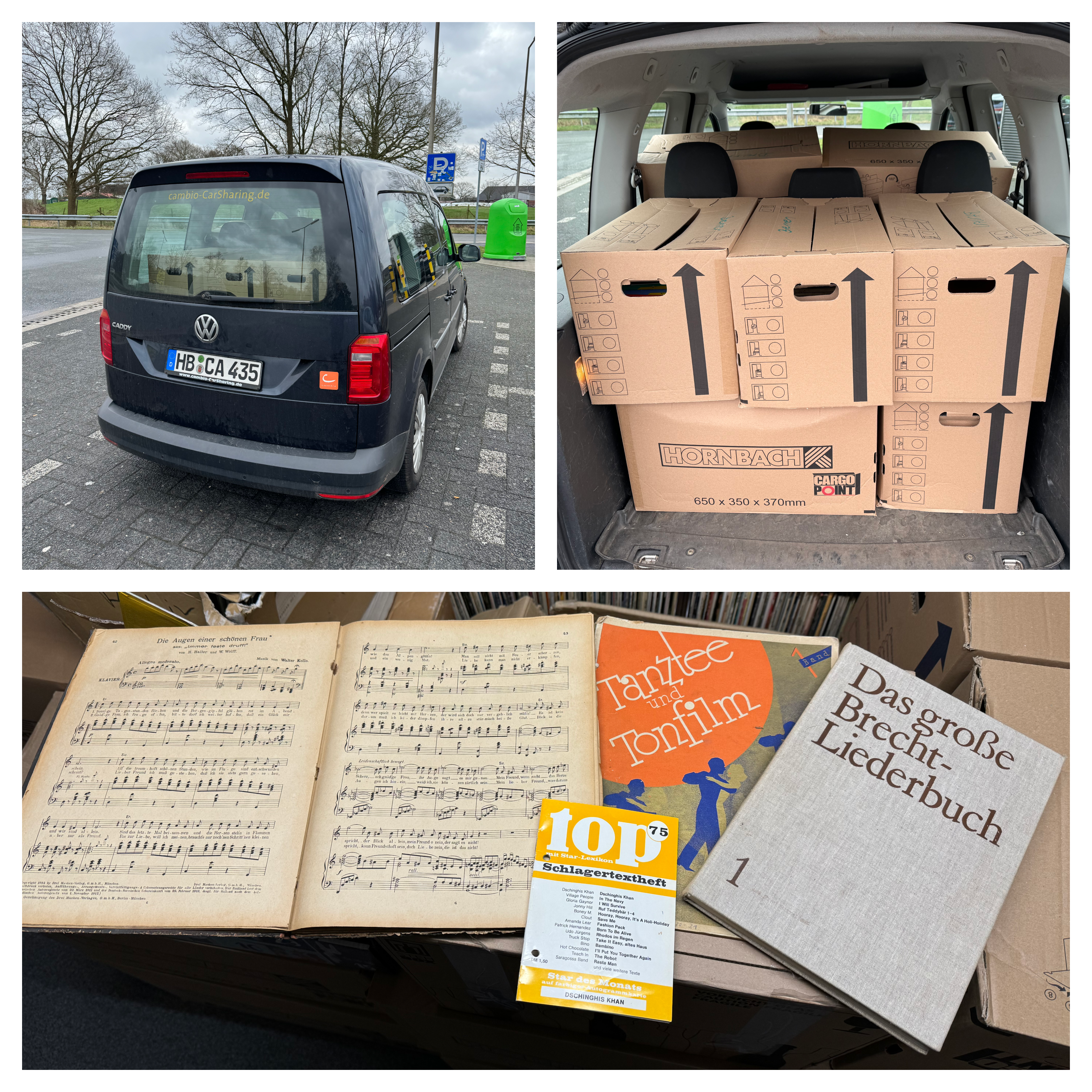
Emeritus musicologist Prof. Dr. Fred Ritzel (born 1938) from Oldenburg has given us his fine collection of sheet music and songbooks, which he has amassed over the course of decades. The collection of 12 moving boxes covers a wide musical spectrum (from jazz to Schlager) and a large period of time (mid-19th century to the end of the 20th century). Prof. Dr. Ritzel is one of the pioneers of German-language popular music research. He taught at the University of Oldenburg for many years.
More information about his life & work here: https://www.staff.uni-oldenburg.de/ritzel/
We would like to thank him for his trust and Prof. Dr. Mario Dunkel (University of Oldenburg) for his mediation.
Deaccession of books

Due to a lack of space and the restructuring of our book holdings, we have decided to deaccession (lat., sort out, reduce, purge, reduce or dispose of holdings or collections of a library, archive or museum). We have disposed of duplicates and literature that has no direct connection to music history. The approximately 1,500 books have found a new home at the Bookfarm in Löbnitz, Saxony.
First KKI advisory board meeting

We are pleased to present our new Advisory Board. The constituent meeting took place on Monday, February 12. The six founding members of the KKI Advisory Board include (in alphabetical order): Prof. Dr. Mario Dunkel (University of Oldenburg), Ulrich Duve (formerly HfK Bremen), Prof. a.D. Dr. Gunnar Schmidt (formerly Trier University of Applied Sciences), Prof. Dr. Ilka Siedenburg (University of Münster), Prof. Dr. Ralf von Appen (University of Music and Performing Arts Vienna) and Karl Gert zur Heide (Bremen).
The Advisory Board has advisory and representative tasks. It supports the work of the KKI with professional expertise.
KKI director gives lecture on bluegrass at the Philharmonie Luxembourg
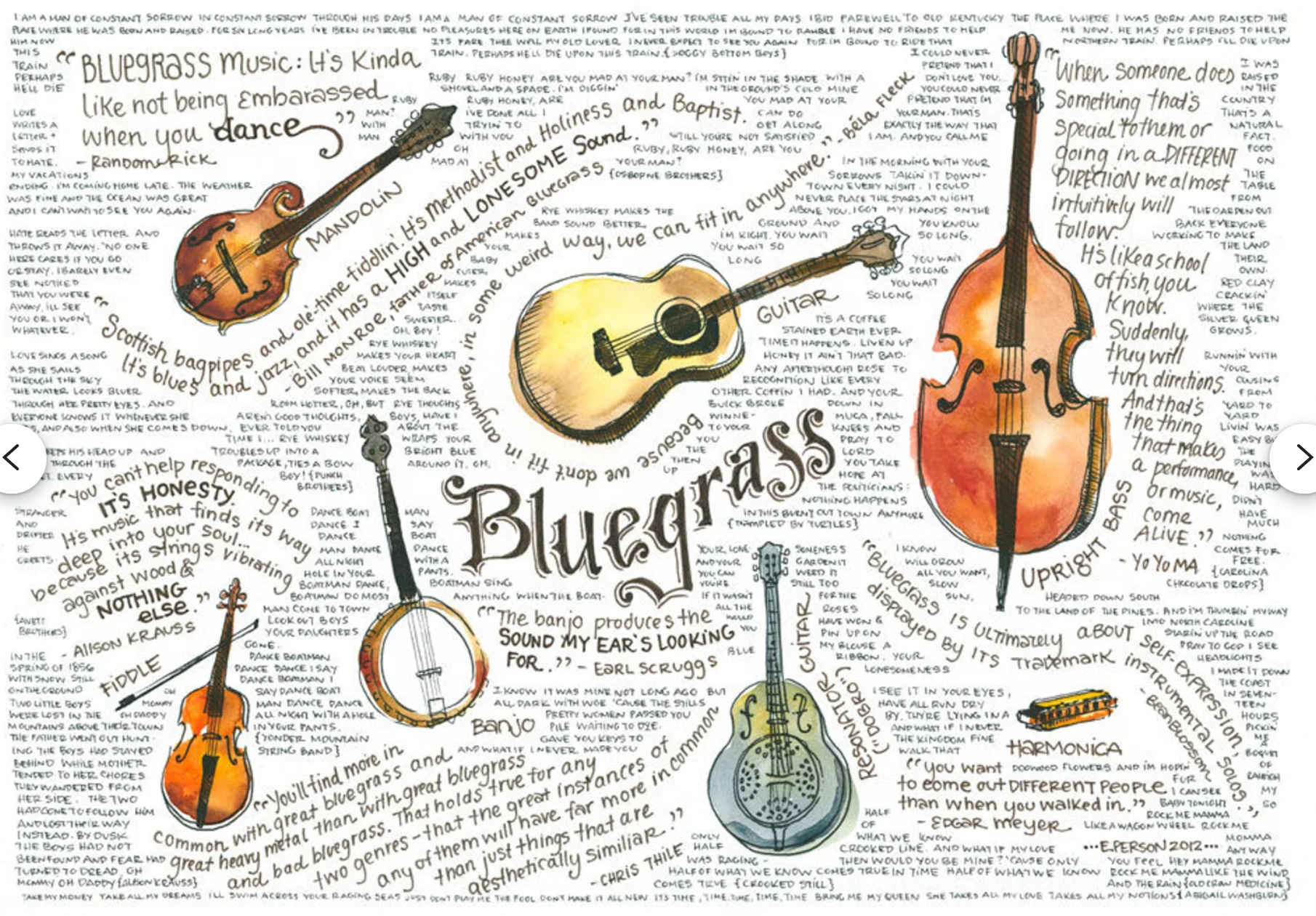
On Friday, February 9, 2024, Nico Thom (KKI director) will give a lecture at the Philharmonie Luxembourg entitled "Bluegrass - Virtuoso folk music through the ages". It is an introductory lecture to the concert by US banjo player Béla Fleck, which is entitled "My Bluegrass Heart".
More information: https://www.philharmonie.lu/en/programm/bela-fleck/5087
Find of the month from the KKI archive _ January 2024
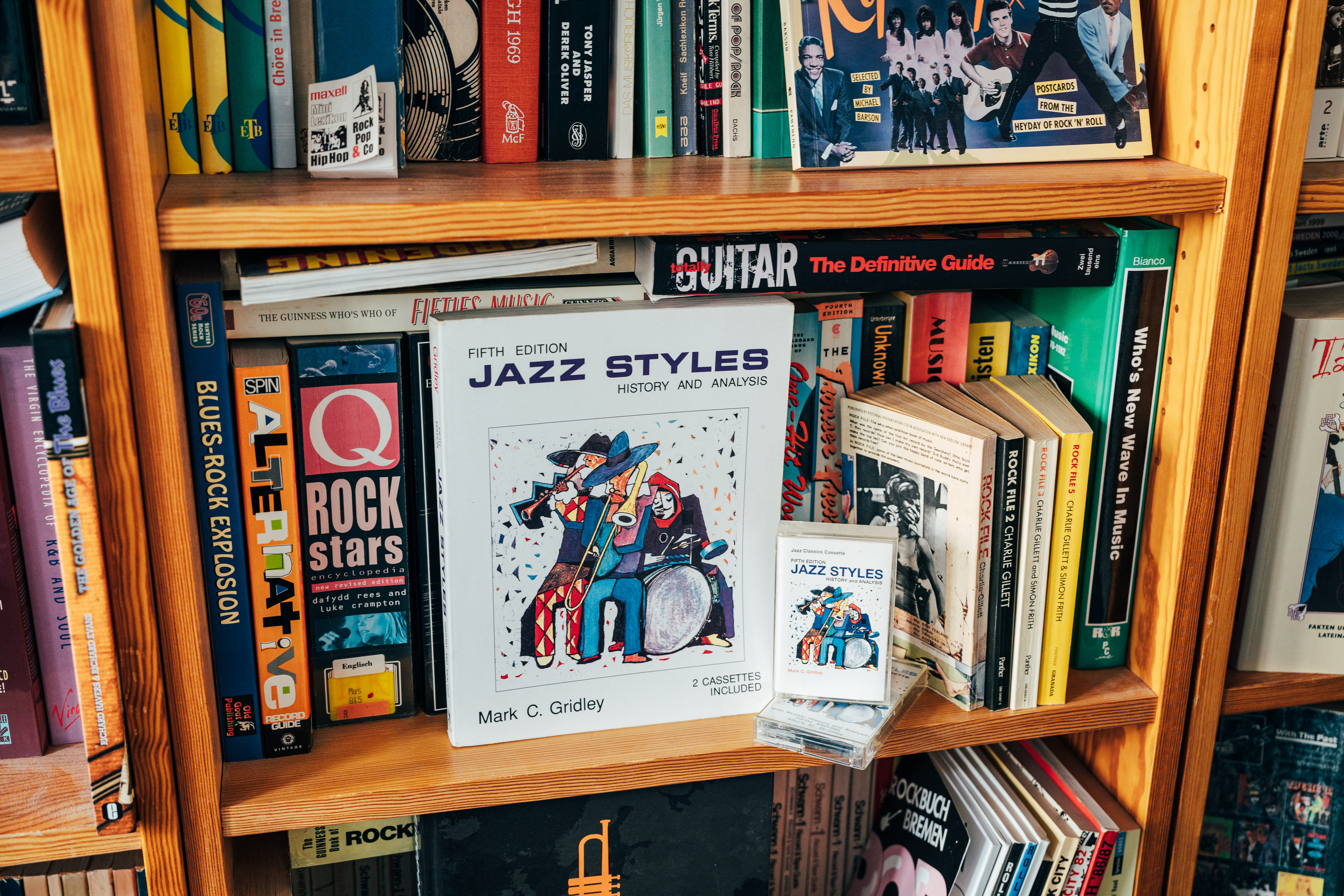
Mark C. Gridley: Jazz Styles. History and Analysis, 5th edition, incl. 2 audio cassettes, Englewood Cliffs: Prentice-Hall 1994.
Everyone who wants to study jazz in depth is looking for it: the one book that captures the essence of this music and gets to the heart of it, preferably using concrete examples. There have been many attempts to present the ultimate jazz textbook. The American jazz flutist/saxophonist and psychology professor Mark Charles Gridley has also tried - and was quite successful. The first edition of his book "Jazz Styles" was published in 1978 and the latest, 11th edition was published in 2013. At the same time, an abridged version entitled "Concise Guide to Jazz" was brought onto the market, which is now also available in its 7th edition.
The 5th edition of this comprehensive book "Jazz Styles. History and Analysis" (422 pages) is briefly highlighted here. It is accompanied by two audio cassettes with many audio examples. One cassette explains the instrumental basics of jazz music, i.e. typical ways of playing the drums, bass and piano as well as various melody instruments. Basic rhythmic, harmonic and melodic know-how is also taught (e.g. comping and syncopation, chords and chord progressions or octave-voiced piano lines). The second cassette contains excerpts from canonized jazz recordings, which are introduced and briefly contextualized by the author. The examples show the development of music history in chronological order, starting with the original Dixieland Jazz Band and ending with Weather Report.
The audio examples end in the 1970s because the first edition of the book was published in 1978. This edition from 1994 continues the jazz history, at least in the text, up to the chapter "Jazz-Rock Fusion". There, in addition to Weather Report, bass guitarist Jaco Pastorius and guitarist Pat Metheny are highlighted as style-defining musicians. Short sections also deal with the sub-styles New Age and Fuzak as well as the popularity of jazz-rock and fusion jazz at the beginning of the 1990s.
However, the majority of the publication is based on a classic jazz narrative. The history of this music is divided into pre-modern and modern jazz, with the beginnings of modern jazz being located in the 1940s. The chapter headings for pre-modern jazz are: Origins of Jazz, Early Jazz: Combo Jazz prior to the mid 1930s, Swing: The early 1930s to the late 1940s, Duke Ellington and The Count Basie bands. Modern jazz is covered in two parts: 1) The early 1940s to the early 1960s and 2) The early 1960s to the early 1990s. Both parts cover the typical catchwords and artists: 1) Bop, Cool Jazz, Hard Bop, Miles Davis and his groups and sideman as well as John Coltrane; 2) 1960s and 70s Avant-Garde and "Free" Jazz, Bill Evans/Herbie Hancock/Chick Corea/Keith Jarrett as well as Jazz-Rock Fusion.
The historical account is framed by explanations of the basics of jazz (definition, improvisation etc.) and a detailed appendix (Elements of music, Guide to album buying, Guide to jazz videos, Glossary, Supplementary reading, Sources for notated jazz solos, For musicians, Index). There are also many photos, graphics and info boxes. There are no illustrations of sheet music, as the publication is intended as a basic course or introduction aimed at beginners. The text was originally written for non-specialist students at colleges and universities. The book is structured in a pedagogically sensible way and uses chapter summaries, for example. From a European perspective, it is noticeable that the historical presentation is very narrowly focused on US jazz. Not a single European jazz musician is mentioned, let alone a female musician! In this respect, the publication seems somewhat out of date or very traditional. Nonetheless, it does provide pointed information on various aspects of jazz.
Arch support was removed -
The KKI is freely accessible again!

Today, the steel supports that have been standing in our vaulted cellar for the last two months were removed. They were installed as a precautionary measure to prevent a potential collapse after some small cracks were discovered in the vaulted ceiling. However, a structural expert opinion was able to give the all-clear, meaning that we can now move freely again. This means that the access ban for visitors has also been lifted. We are very happy about that!
Farewell to Lukas Klose

We were shocked to hear the news of the untimely death of photographer/filmmaker Lukas Klose. Over the last two years, he has taken photos of the KKI from time to time and photographed some of our finds. He worked as a freelance photographer/filmmaker for the University of the Arts and the University of Bremen, among others. He was still quite a young, artistically sophisticated colleague who was a pleasant cooperation partner due to his calm and reflective manner. We will miss him!
New material from Friedel Muders (FUEGO)
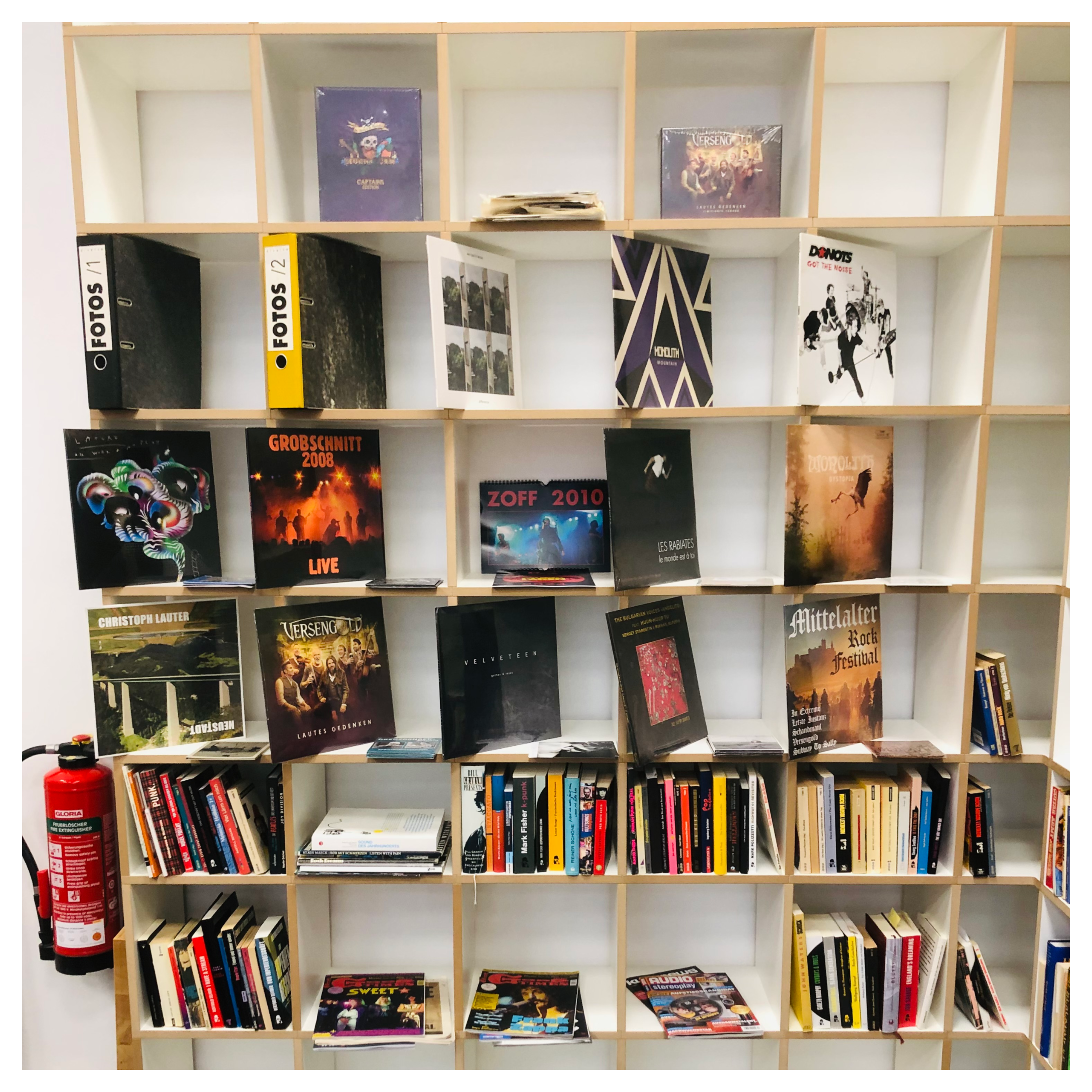
Our valued cooperation partner Friedel Muders, who runs the Bremen label and music publisher FUEGO, has once again provided us with interesting material from his collection, including books, vinyl records, magazines, CDs, DVDs, calendars, posters and photos. We are delighted with the exciting media and are determined to present his poster collection in particular in an appropriate way, perhaps in the form of a small (online) exhibition.
New intern for three months

From the beginning of January to the end of March, Peter Handke is completing a three-month internship at KKI, arranged by the Berufsförderungswerk Friedehorst in Bremen. We are delighted to have his support and are happy to give him an insight into our varied day-to-day work.
New FaMI trainee in January

From January 8 to 26, Alina Krusch will be completing a three-week internship at the KKI. She is currently training as a media and information services specialist (FaMI) at the Weserburg Center for Artists' Publications in Bremen and is in her second year of training. We are grateful for her cooperation and are happy to give her an insight into our day-to-day work. FaMI interns visit us regularly and are always welcome.
[Volume 2023]
Find of the month from the KKI archive _ December 2023
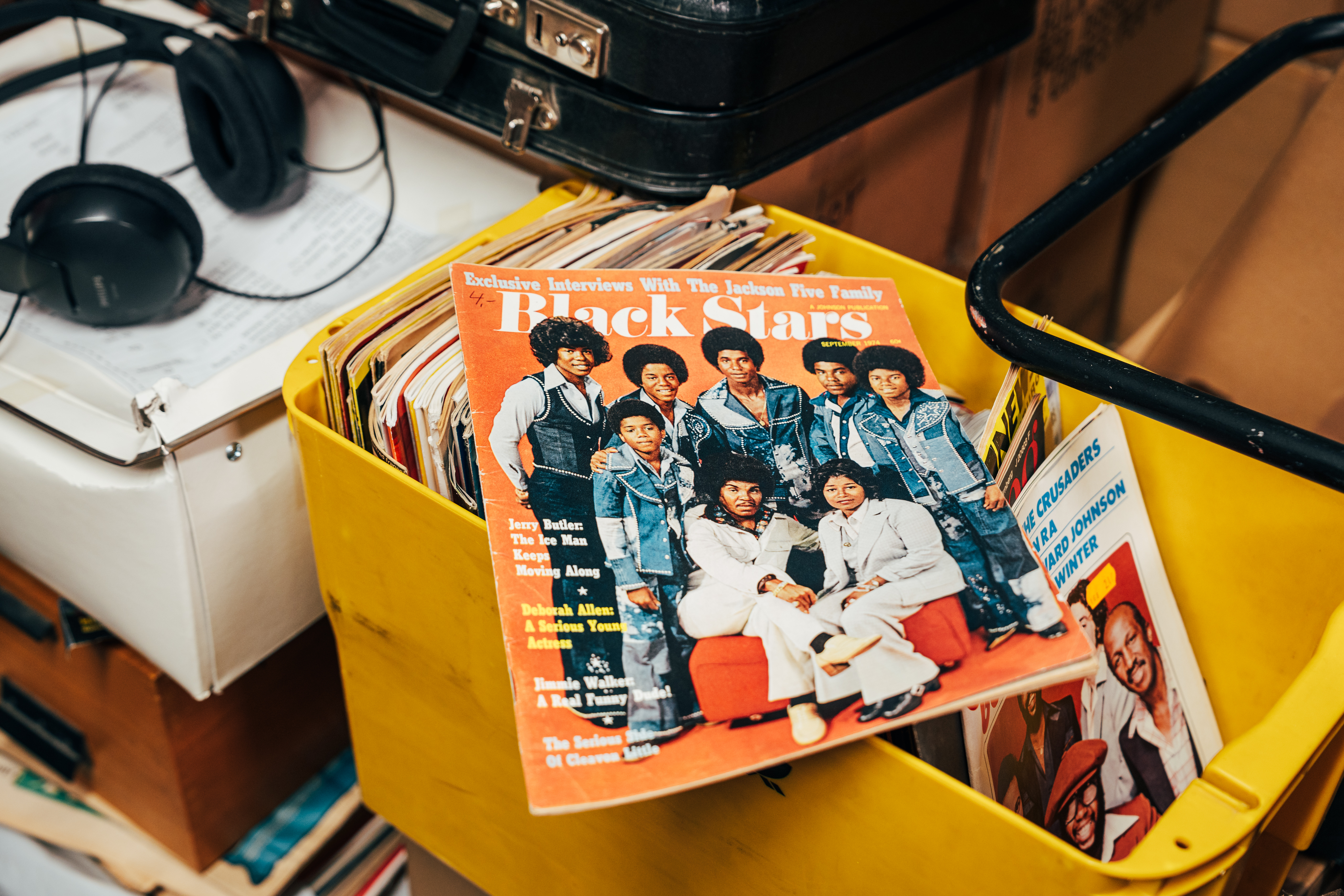
Black Stars, Volume 3, Number 11 (September 1974).
For ten years, from 1971 to 1981, Black Stars, a monthly magazine published by the Johnson Publishing Company (headquartered in Chicago), one of the largest African-American publishing houses in the United States, was published in the USA. Black Stars was founded in 1971 with the goal of creating an entertainment magazine. In the first issue, John H. Johnson outlined the magazine's goals as follows:
"Black Stars will be entertaining, informative, factual, intimate and lively, dealing almost exclusively with the lives and careers of great living black entertainers. Many of the articles in the magazine will be written by the stars themselves."
According to June A. Rhinehart, vice president of the publishing house at the time, publication was discontinued in 1981 because readership and advertising revenue were declining.
In the September 1974 issue presented here, the Jackson family is on the cover, including a certain Michael (15) and his younger sister Janet (8). The history of the family band goes back to 1964, when they started out as "The Jackson Brothers". In 1966, they changed their name to "The Jackson Five". From 1976, the band simply called themselves "The Jacksons". It still exists today, albeit without the siblings Michael and Janet, who have both become superstars and pursued very successful solo careers. Other siblings, such as the sisters Maureen and LaToya, are also no longer part of the group. On page 38/39 there is a large-format photo with a total of eleven family members, including father Joseph and mother Katherine Jackson. So there were nine siblings in total.
There are two articles on the Jackson family in this issue. One reports on the Jackson Five's first small (West) Africa tour under the headline "The Jackson Five Rap On Africa" (pp. 36-44), the other is dedicated to the mother of the music clan with the headline "Meet Mrs. Katherine Jackson" (pp. 46-50). While the first article, or rather an interview with the Jackson Five, is about their impressions of Africa and the questions revolve around being black, the second article is a tribute to the wife, mother and grandmother, who has been married for 25 years and has nine children and two grandchildren. Katherine Jackson is "one of the nicest, warmest and most friendly people you can ever meet", it says on page 46, for example.
Black Stars is by no means just a music magazine. In addition to musicians such as Jerry Butler and the Jacksons, this issue also features comedian Jimmie Walker, dancer and actress Deborah Allen, actor Calvin Lockhart, film director/producer Melvin Van Peebles and actress Juanita Brown. In short: African-American entertainers are highlighted and portrayed in a thoroughly heroic manner. Incidentally, Black Stars should not be confused with a similar contemporary magazine called "Blackstar*", formerly also known as "Black Star Magazine", although the concerns of the print products are comparable: To present successful African-Americans and to pursue identity politics in an entertaining way.
Current status of the conversion work (end of 2023)

What a ride! The renovation work in the upper reception/office/book room of the KKI is largely complete. Apart from some minor structural work that is still outstanding, most of the work is done. We are satisfied with the result so far and are delighted with the new interior, which inspires contemplation and encourages us to continue with the renovation on the lower level of the KKI in the new year.
Heartwarming KKI music exchange on December 17th

On Sunday, December 17, the KKI will be represented at the winter market of the Bremen University of the Arts with a music exchange from 3-8 pm. The one-day winter market will be set up in front of the university at Dechanatstrasse 13-15 (= location of the music department). Our music exchange offers duplicates of records, CDs, books & magazines at reasonable prices. A good opportunity to organize the last Christmas presents!
New HfK website & new KKI subpage

The University of the Arts Bremen, our parent institution, has a new website. After several years of interim solutions, the new HfK website shines with an appealing design and appropriate information content. The KKI has also been given a new subpage, which you can admire here: https://www.hfk-bremen.de/en/about-the-university/spaces-and-places/klaus-kuhnke-institute
Documents of a Bremen barbershop chorus called "Singsation"

On December 12, Gerlind Schütte gave us ten folders with documents from the Bremen choir "Singsation". The choir has been in existence for 35 years and follows the tradition of barbershop singing. Current information about the choir can be found here: https://singsation.de
Report on KKI on the Stadtlauscher website

The Bremen website stadtlauscher.de has reported on us in detail in its "Magazine" section. The three-part report was written by Jürgen Francke. We would like to thank Conrad Schwenke, the founder of the Stadtlauscher website, for his interest in our cooperation and his kind reporting.
Click here for the report: https://stadtlauscher.de/magazin/klaus-kuhnke-institut_1
New FaMI trainee in November/December

From November 27 to December 15, Marlies Heißenbüttel will be completing a three-week internship at the KKI. She is currently training as a media and information services specialist (FaMI) at the Bremen State Film Archive and is in her second year of training. We are grateful for her cooperation and are happy to give her an insight into our day-to-day work. FaMI interns regularly visit us and are always welcome.
Find of the month from the KKI archive _ November 2023
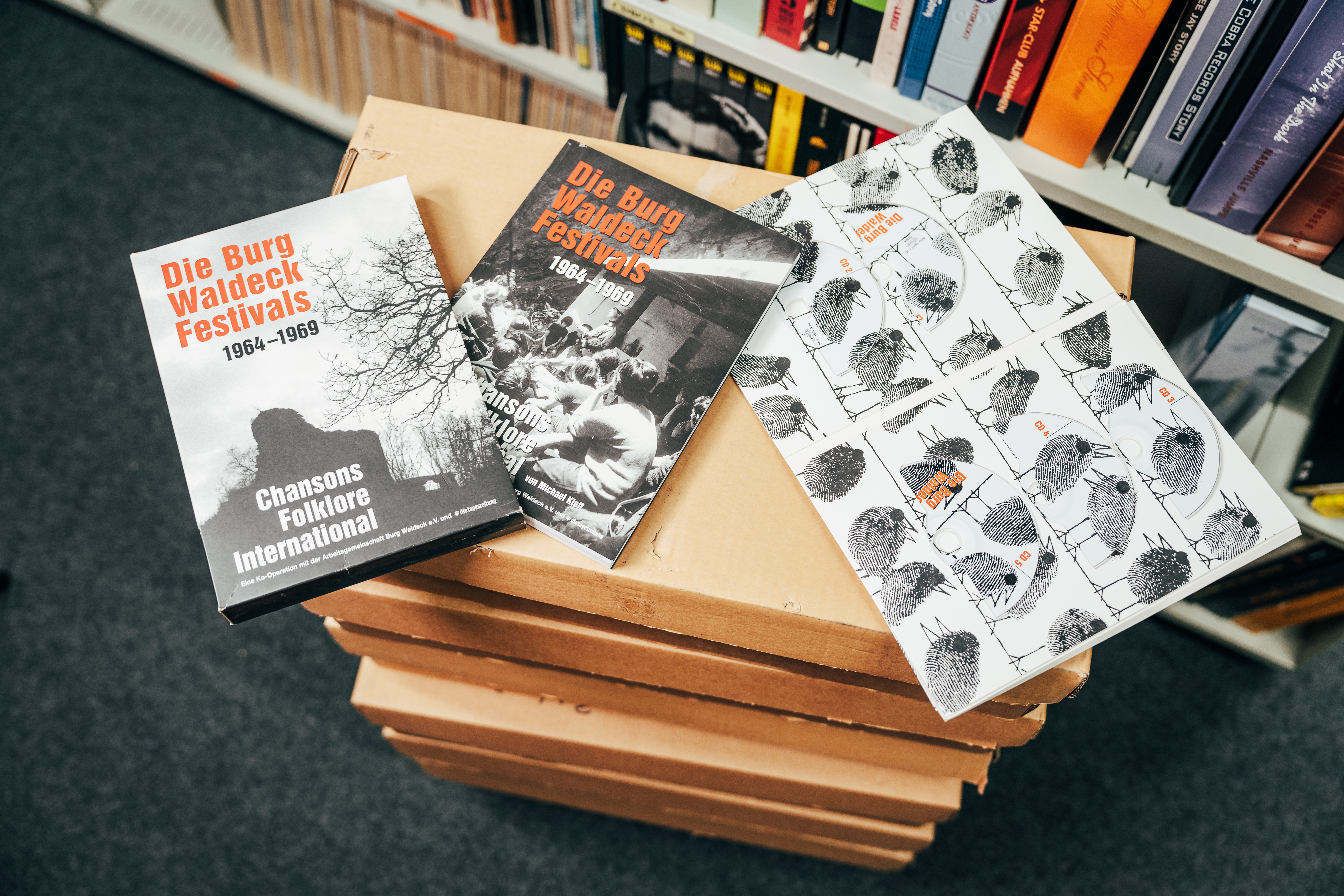
Michael Kleff (ed.): "Die Burg Waldeck Festivals 1964-1969. Chansons Folklore International", a co-operation with the Arbeitsgemeinschaft Burg Waldeck e.V. and the TAZ - Die Tageszeitung, 10 CDs with book in slipcase, Hambergen: Bear Family Records 2008.
In 2008, music journalist Michael Kleff and the Bear Family Records label won the prestigious German Record Critics' Award for this publication. In a cardboard slipcase with a picture of Waldeck Castle, there is a 240-page anthology with numerous texts and illustrations as well as a folding box with 10 CDs containing a total of around 300 live recordings of songs/chansons and spoken contributions.
This wealth of material documents the few years that the festival existed. For six years, Liedermacher/Singer-Songwriters/Chansonians and a young, politically-motivated audience met at a ruined castle near the village of Dorweiler in the Hunsrück mountains in Rhineland-Palatinate. Most of the singing was in German, but some was also in English, French, Italian and Yiddish. "The festivals at Burg Waldeck were the first German open-air festivals; they were a confrontation with the socio-cultural stink of the Adenauer restoration. They countered the pop singers and ideal-world prophets with other German texts", writes the editor (p. 10). And further: "The Waldeck festivals tore the old German democratic song traditions out of their shadowy existence. And the interpreters of a new German song reaped an unprecedented response in German music history." (ibid.)
In fact, this contemporary document makes the social upheavals in the Federal Republic of Germany visible and audible, which today are summarized under the catchphrase "68 generation". The color of the time is conveyed in a vivid way and a lot of nuances can be heard. In addition to the numerous musical examples, the recorded discussions are also very interesting because they show the liveliness of the festival community and the diverse political and artistic views of the participants. The book is supplemented by original sound bites from interviews conducted by the editor with festival protagonists such as Diethart Kerbs, Franz Josef Degenhardt and Fasia Jansen.
Each of the six festival years is recorded in great detail. Photos, newspaper articles, posters and flyers visualize the texts of selected festival makers, artists and festival visitors. Almost half of the book consists of an "alphabetical list of artists", which contains short biographies of the musicians, cabaret artists and poets who performed. The publication (book and CDs) is a must for fans of cultivated (folk) songs in the German language. What is today regarded as the ideal type of German-language folk and singer-songwriter music is summarized here. The spectrum ranges from highly political protest songs to poetically playful love songs. The most frequently used accompanying instrument is the acoustic guitar.
New YouTube video: Lecture on the relationship between jazz & pop music
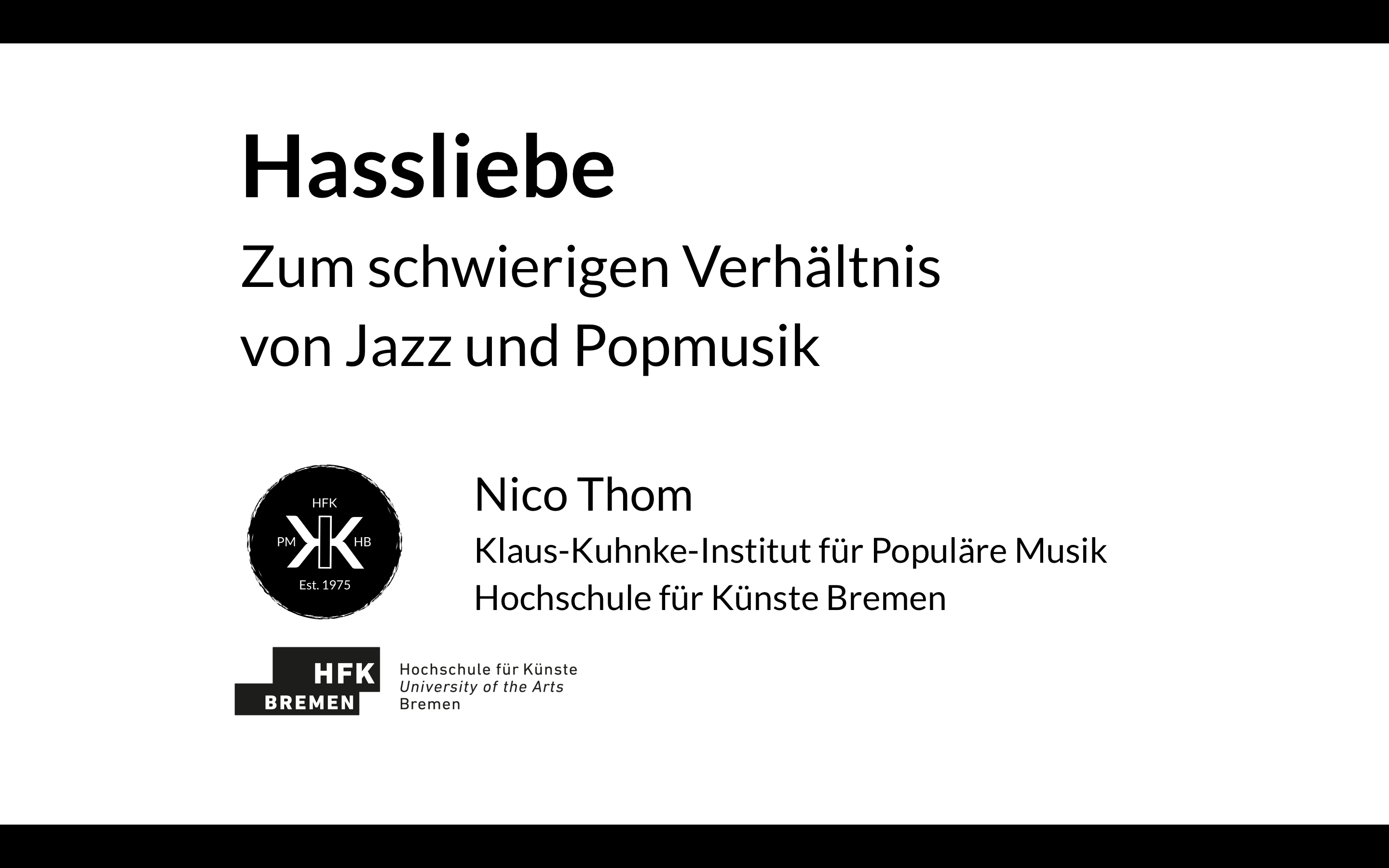
A current lecture by Nico Thom (KKI director) can be seen/listened to on the KKI YouTube channel. It is the recording of an online lecture from October 4, 2023, which was organized in the series "Pop im DMA" by the German Music Archive in Leipzig. The title was: "Hassliebe - Zum schwierigen Verhältnis von Jazz und Popmusik". Parts of the lecture had to be cut out for copyright reasons.
Here is the link to the video: https://youtu.be/J2IDh_rdO-U
KKI is (partially) open again thanks to steel supports
- But not yet open to the public

The closure of the KKI has been lifted as the damaged basement corridor has been secured with steel supports. However, only KKI employees are currently allowed to enter the premises. For the time being, the KKI is not accessible to the public - probably until the end of the year. However, inquiries can be directed to us at any time.
Breaking news: KKI is temporarily blocked!

Due to structural problems, the KKI is closed until further notice. It is currently not possible to enter the premises. We are waiting for a static check. As soon as there is any news, we will inform you here.
New FaMI trainee in November

Lisa Grube is completing a three-week internship at the KKI from November 6 to 24. She is currently training as a media and information services specialist (FaMI) at the Achim City Library and is in her second year of training. We are grateful for her cooperation and are happy to give her an insight into our day-to-day work. FaMI trainees visit us regularly and are always welcome.
Find of the month from the KKI archive _ October 2023
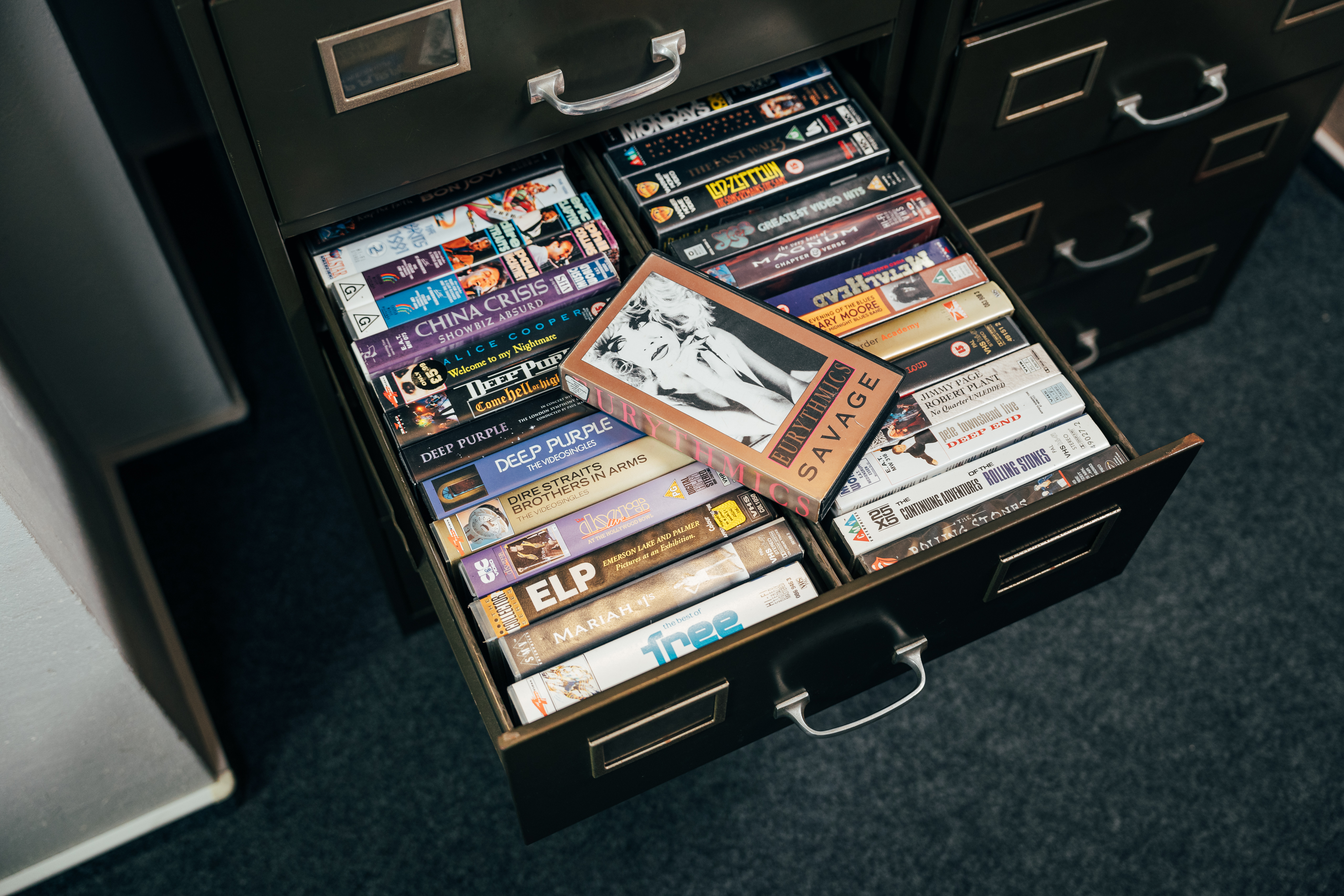
Eurythmics: "Savage", Video album on VHS cassette, Oil Factory Inc. (USA) / UFA & Media Ltd. (GB) / Virgin & PVG Ltd. (GB) 1988.
The British synth-pop duo Eurythmics was very active in the 1980s, producing seven studio albums during this period, having several international chart hits (e.g. "Sweet dreams" or "Love is a stranger") and doing major tours. The singer Annie Lennox and the music producer David A. Stewart had already worked together before (from 1975 to 1980) in two bands (The Catch and The Tourists). In 1990, the two separated and each pursued successful solo careers.
In 1987 their sixth studio album was released under the title "Savage". It contains 12 songs and can be described as a concept album. Thematically, the lyrics revolve around relationship problems, attempts to break out of partnerships, new loves and sexuality, as well as art as an organizing force in this emotional chaos. A female perspective dominates. The background for "Savage" was formed by personal tensions between Lennox and Stewart, who had once been a couple and were starting families independently of each other at the time of the album's creation.
The sound of the duo changed radically on "Savage" and was now mainly based on programmed samples and drum loops. Musically, the two again relied more on classic synth-pop elements, which had been pushed back in favor of rock influences in the two previous albums. David A. Stewart produced the music largely on his own, Annie Lennox was responsible for the lyrics and vocals. The album was received positively by the music press throughout. The record was said to have mature songwriting that struck a good balance between abstraction and sensuality as well as art and commerce.
For "Savage" a video album was specially produced, which was released a few months later as a VHS cassette. This means that a music video was shot for every song on the album. Some of these videos were shown as singles on music television (MTV & Co). The videos were all made by Sophie Muller, a British music video director who has produced over 300 music videos during her career and has worked with numerous (mainly female) stars in the pop music business (e.g. Sade, Björk and Sinéad O'Connor or bands like No Doubt, The Cure or Radiohead). The videos for "Savage" were her first independent works, created in her mid-twenties, which helped her break through. In the videos, Annie Lennox takes center stage. The singer is presented as a housewife who transforms into a vamp. In most of the videos, she wears a uniform outfit: a skin-tight white glitter dress, a big blonde wig, bright red lipstick and heavily made-up eyes. The video aesthetic is rebellious-glamorous, some clips are black and white or minimalist.
Construction of the new shelving system

Now it is finally here! The new shelving system from Mocoba was delivered and installed on October 24. Although the reception/office/book room is not yet completely furnished, everything should be ready by the end of the year. In any case, we are already enjoying the promising ambience.
Annual Meeting of the Archive Network Pop in Cologne
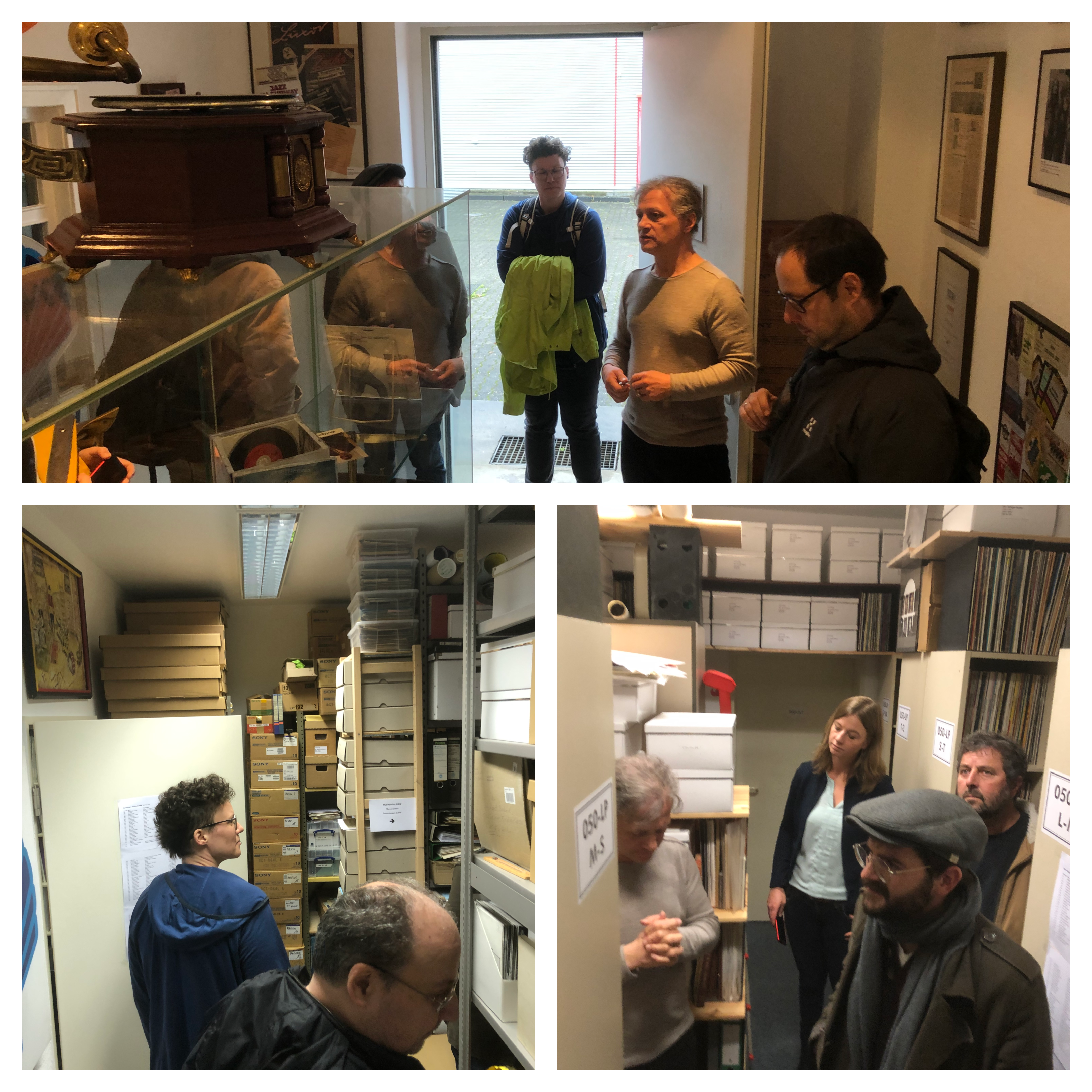
On Friday, October 20, 2023, the Archive Network Pop, in which the KKI is involved, met at the Musikarchiv NRW in Cologne. Of course, there was also the opportunity to marvel at the great collection of the Musikarchiv NRW, which has been compiled by its founder/director Matthias Schumacher. More information here:
https://musikarchiv-nrw.de
https://www.archivnetzwerk-pop.de
Find of the month from the KKI archive _ September 2023

"Bremer Liederbuch für AKW-Gegner" [Bremen Songbook for Opponents of Nuclear Power Plants], 2nd edition, published by the Bremen Citizens' Initiative against Nuclear Power Plants (BBA), Bremen: Self-published 1979.
This songbook is clearly political literature and music. It was written in the context of the anti-nuclear movement, which was formed as a social movement in the 1970s and was particularly strong in Germany in an international comparison. The movement had a lasting impact on public discourse in the Federal Republic for decades and, thanks to its perseverance, led to the shutdown of Germany's last three nuclear power plants (Isar 2, Emsland and Neckarwestheim 2), which were still in operation, on April 15, 2023. In this respect, the musical-political reference to the present is easy to recognize.
The handy booklet was designed for use at demonstrations. The editors of the Bremen Citizens' Initiative against Nuclear Power Plants (BBA) write in the preface: "This songbook was created out of our need to always have to walk around with 4 or 5 different booklets when we want to sing something. It is therefore predominantly a 'songbook', so we have refrained from giving explanatory texts on the origin of the songs and on the struggles at the respective sites. In the index, therefore, reference is made to text booklets, song books and records, which contain more content. [...] Send us new songs and write which ones could be left out because they are not sung anyway. Unfortunately, we couldn't record all the songs we collected, because you're supposed to take the book to the next demo conveniently."
Obvious is the do-it-yourself approach of the publication, which was created with a typewriter and supplemented by numerous handwritten headings, musical notations, additional texts and drawings. Approximately 100 songs with German lyrics are collected on 230 closely printed pages. These were primarily arranged according to the locations of nuclear power plants, i.e. there are, for example, songs about Brokdorf, Gorleben or Rehling near Augsburg. But Switzerland as a nuclear power nation is also sung about, as is the French community of Malville. Here the internationality of the movement is indicated. In addition, there are songs of a general character, for example the "Anti Paranoia Blues", "Das Lied vom Schutzmann" or "Das 'Es-kann-gar-nichts-passieren'-Lied".
In this second edition, some things have been redone, revealing the vitality of the anti-nuclear movement at the end of the 1970s: "Many songs that were written last year have been re-recorded. We have left out a few old songs. The sheet music for all the songs is now printed. We have tried to keep the melodies in singable pitches. [...] Harmonies are given for all the melodies, in a uniform notation." At the end of the book there are also instructions on how to write songs yourself. It can be stated that this is a document of the times, which places next to the political impetus the idea of a musical grassroots movement, in which everyone can and should participate.
KKI director gives lecture at the German Music Archive
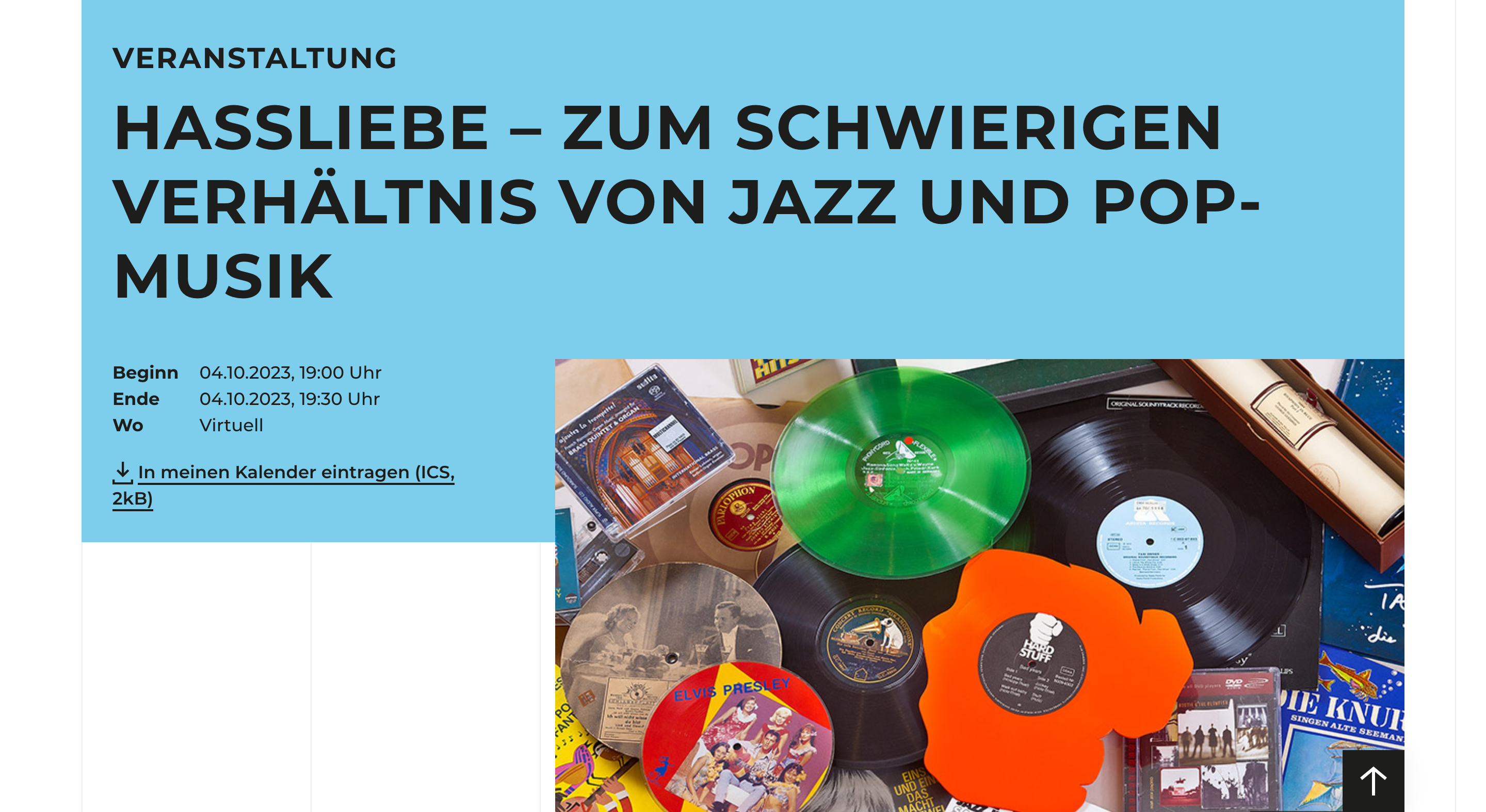
On Wednesday, October 4, 2023, at 7 p.m., Nico Thom (head of the KKI) will give an (online) lecture entitled "Love-Hate - On the Difficult Relationship between Jazz and Pop Music" at the Deutsches Musikarchiv (German Music Archive). The German Music Archive is part of the German National Library in Leipzig. The lecture will be freely accessible on the Internet. (Originally, the lecture was scheduled to take place a week earlier [on September 27], but it had to be postponed due to illness). More info here:
https://www.dnb.de/DE/Kulturell/Veranstaltungskalender/DMAPopmusik/230927JazzPopmusik.html
Find of the month from the KKI archive _ August 2023
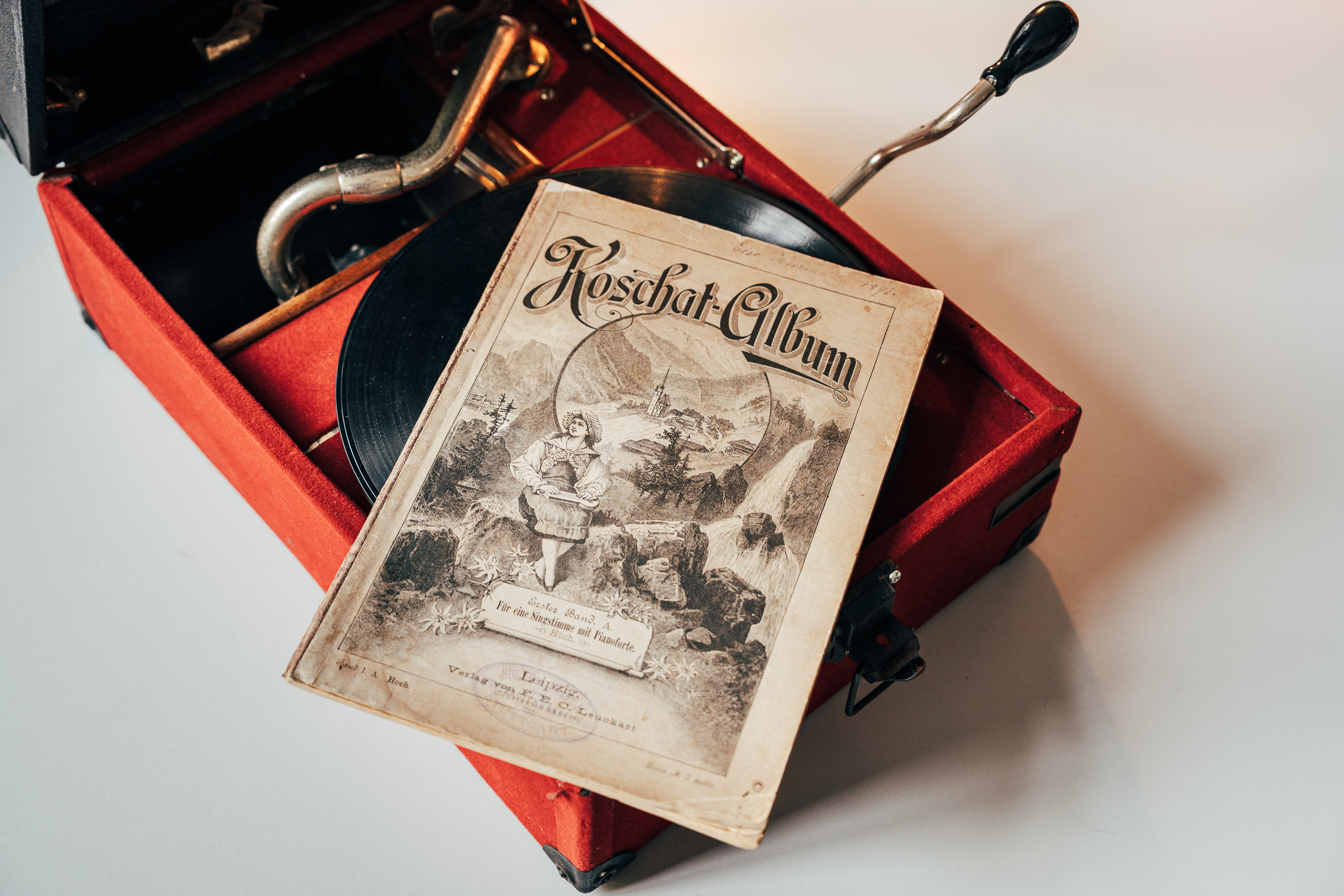
"Koschat-Album. Auswahl der beliebtesten Kärntner Lieder von Thomas Koschat. Erster Band. Ausgabe A. Für eine Singstimme mit Pianoforte (hoch)", Notenausgabe, Leipzig: Verlag F.E.C. Leuckart, ca. 1895.
("Koschat album. Selection of the most popular Carinthian songs by Thomas Koschat. First volume. Edition A. For one singing voice with pianoforte [high]," edition of sheet music, Leipzig: Verlag F.E.C. Leuckart, around 1895.)
Sometimes chance plays into your hands. In the foyer of our University of the Arts we found this fine music album. Someone had left it there for us to take home or had given it away. Now it has become part of our collection, so it has stayed in the house, so to speak.
This Koschat album is the first part of a multi-volume edition and was composed or compiled by Thomas Koschat (1845-1914). In the course of his life, the "Carinthian song prince" created an extensive body of work, which took up and further developed the Carinthian folk song tradition. Carinthian songs refer to the southernmost region of Austria or to the province of Carinthia (state capital: Klagenfurt am Wörthersee).
Starting from Viktring near Klagenfurt on Lake Wörthersee, Koschat was drawn to the Vienna Court Opera, where he was later director of the choir for many years. With his song arrangements and new compositions he achieved great popularity and even toured Europe and America. In his native Austria, he received fame and honor. Even beyond that, throughout the German-speaking world, his œuvre received much recognition. His most famous piece is certainly the "Jägerständchen", nowadays better known as the "Schneewalzer".
In this very nicely designed edition of sheet music, which was published in 1895 by a Leipzig publishing house, 20 of his songs or arrangements of folk songs are collected. The texts are in the Carinthian dialect. Koschat's prefaces state: "As a result of several inquiries, especially from northern Germany, concerning the pronunciation and accentuation of certain dialectal sounds marked by special signs, I see myself compelled to send a few hints in advance of this edition of my folk compositions."
The short songs, mostly only 2 to 3 pages long, have titles like "Karntner G'müath", "Büaberl, merk dir's fein" or "Ew'ge Liab". Only the last piece called "Am Wörther See" is more extensive and contains 5 Carinthian waltzes.
How productive and popular Thomas Koschat has been can be seen in the publisher's advertisements included in the album. There, on several pages, quite different editions of the composer's music are advertised, with arrangements (some by third parties) for various instruments and instrumentations. The highest opus number is 100, twenty years before the composer's death. Apparently there was a great demand for his works, which are catchy and dance-like throughout. Most of the pieces are short waltzes.
Formation of an advisory board

The KKI is in the process of forming an advisory board. So far, Ulrich Duve, the former director of the Klaus Kuhnke Archive, has been the only member of the advisory board. Now we have been able to recruit other well-known personalities to join the advisory board:
Prof. Dr. Ralf von Appen (Professorship for Theory and History of Popular Music at the mdw - University of Music and Performing Arts Vienna),
Prof. Dr. Mario Dunkel (Professorship for Music Education and Transcultural Music Education at the Carl von Ossietzky University Oldenburg),
Prof. ret. Dr. Gunnar Schmidt (Retired Professor for Theory and Practice of the Intermedial at the Trier University of Applied Sciences in the Department of Design).
The members of the advisory board support the KKI with their professional expertise and help with networking with the scientific and artistic communities and with public relations.
Renovation and conversion work in the KKI

We have started renovation and conversion work. In particular, the upper reception or office room of the KKI is being completely redesigned. Before the installation of a large shelving system, the room will get new ceiling tiles, new carpeting, new wall paint and new cable ducts and lighting. Even heating and plumbing work will be done. In short, operations are temporarily somewhat limited; probably until mid-November. We ask for your understanding.
Find of the month from the KKI archive _ July 2023
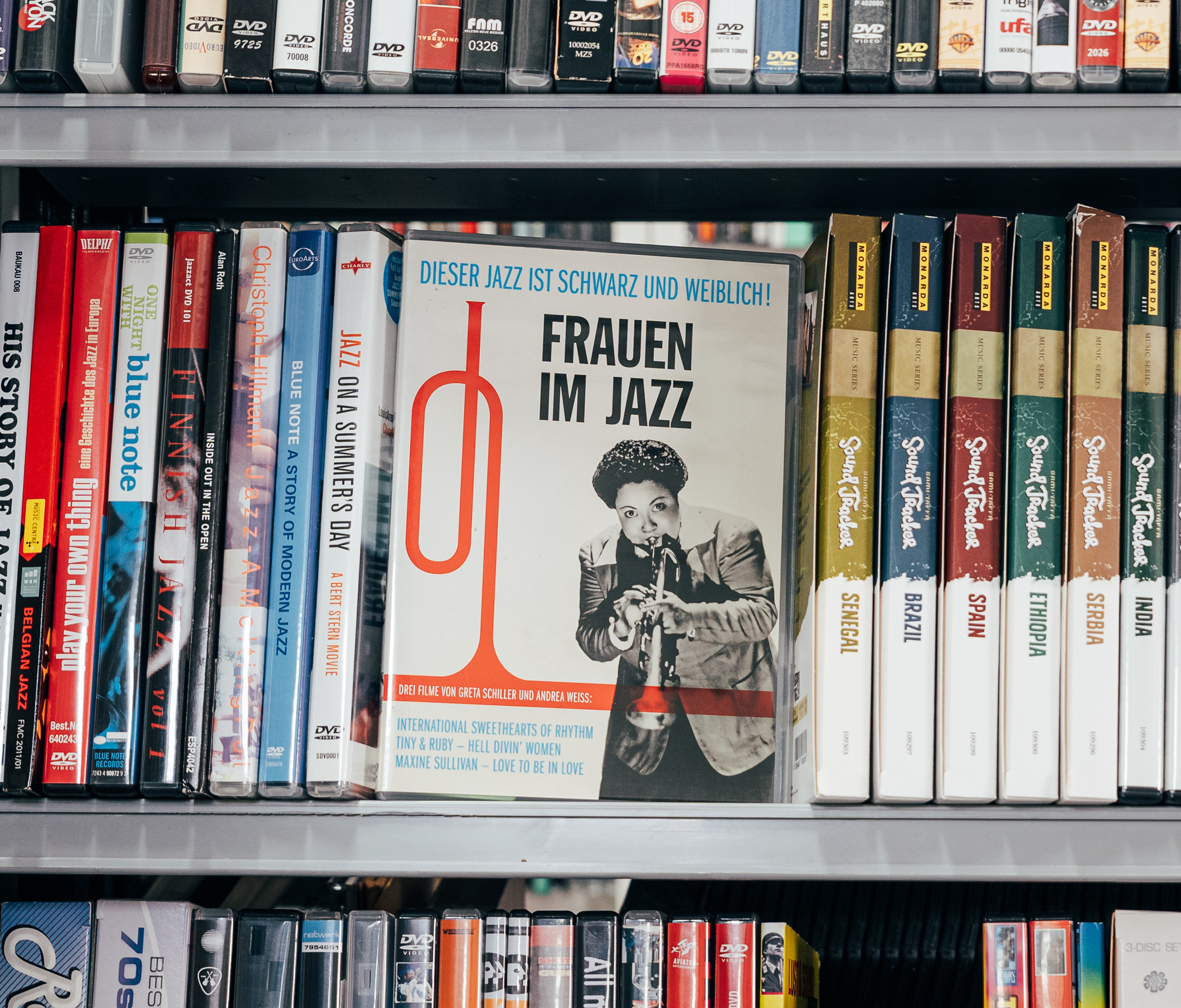
"Frauen im Jazz" [Women in Jazz], DVD with 3 documentaries by Greta Schiller & Andrea Weiss, Berlin: Salzgeber 2007.
Berlin-based Film Distribution & Publishing Salzgeber, which specializes in queer issues, released this DVD in 2007, which contains three short documentaries by Greta Schiller and Andrea Weiss. The two US-Americans were born in the mid-1950s and have been making documentaries together since the early 1980s. The lesbian couple has run Jezebel Productions, a small and independent film production company based in New York, since 1984.
Do you know the International Sweethearts of Rhythm, a 16-piece big band? Black and white women played together as equals in this formation. The group grew out of a Mississippi Delta schoolgirl band founded by a school principal in 1939. In 1941, the glamorous Anna Mae Winburn became the new leader and the singer of the big band. Other professional musicians such as Vi Burnside and Ernestine "Tiny" Davis also joined in 1941. From then on, the big band evolved into "America's greatest all girl band" (a slogan emblazoned on the tour bus). During the 2nd World War, the breakthrough came. Nevertheless, the Sweethearts had a hard time making it in the music business because they were a "mixed race" band. They played primarily for black audiences and toured the U.S. together on a bus. "We ate together, slept together and lived together. Our only goal was to bring music to the people. [...] We were professionals, like the men. [...] Louis Armstrong was one of our dearest friends. He liked us personally. So did Count Basie or Billie Holiday. [...] Armstrong even tried to poach Tiny Davis. He offered her ten times as much." Tiny: "I didn't go because I liked the girls too much. I loved them." "We were attached to each other. [...] We also worked with Ella Fitzgerald. She became a very good friend," Anna Mae Winburn reports. The band even performed in Europe, playing for American soldiers. In Germany alone, the women spent six months and gave concerts there, for example, at the Nuremberg Opera House. After the war, the band suffered from returning male musician colleagues who now got the jobs. In addition, many female bandmates started families and could not be adequately replaced. By the end of the 1940s, the big band gradually disintegrated, not least because this type of swing was losing popularity due to newer musical developments (keyword: bebop). The half-hour documentary, simply titled "International Sweethearts of Rhythm", was released in 1986 and features interviews with the protagonists as well as a lot of archival footage that attests to the popularity of the big band in the 1940s, as well as the first-rate quality of its music.
The 1988 film "Tiny & Ruby - Hell Divin' Women" is dedicated to the two African-American women Ernestine "Tiny" Davis & Ruby Lucas, who have been a lesbian couple for over 40 years. They met and fell in love in the band Tiny Davis and her Hell Divers. Virtuoso trumpeter and vocalist Ernestine "Tiny" Davis - she was appreciatively called the "female Satchmo" - led the professional all-female band from 1947 until the early 1960s, after she quit the International Sweethearts of Rhythm. The combo played an entertaining mix of blues, swing, and rhythm and blues. Ruby Lucas acted first as a driver, and later as the band's bassist, drummer and pianist. After divorcing Tiny Davis (in 1946), who had three children, Ruby and the band leader became a couple. Then, in the mid-1950s through the early 1960s, Tiny and Ruby ran a gay/lesbian club together in Chicago called the Gay Spot. The house band was the Hell Divers. The 27-minute film presents the two women and their shared musical life story through interviews and archival footage. The film also reveals the very different personalities of the ladies: here the fun-loving full-blooded musician in the spotlight (Tiny), there the reserved organizer in the background (Ruby).
The 45-minute film "Maxine Sullivan - Love to be in love" is about the pop/jazz singer from Pittsburgh who became successful in New York. Her life dates: 1911-1987. "She had a direct singing style, simple but with tremendous sense of rhythm. Just perfect." (Scott Hamilton, bandleader & saxophonist) While she had no formal musical training, Maxine Sullivan came from a family of musicians. All ten family members played some instrument or sang. The kind of music with which she achieved fame was called "sweet swing." Among other things, she sang swing versions of classical works and had a huge hit called "Loch Lomond." She performed with Benny Goodman and Louis Armstrong and worked on Broadway as well as in film. Sullivan toured Britain, where she also scored hits. "I slowly broke away from folk and returned to my passion, jazz." (Maxine Sullivan) In 1957, she retired from show business for 12 years to devote herself to her family - and resumed her singing career at the age of 58. She also played trombone and flugelhorn from the 1950s. At an advanced age, she completed two tours of Japan. Starting in 1983, she recorded a new album every three months and formed a permanent band around her, with which she toured the world. She was a Dixieland and Swing veteran and reached a large audience of old-time jazz lovers. The film by Greta Schiller and Andrea Weiss saw the light of day in 1991 and documents the fascinating life/music story of the African-American singer on the basis of numerous archive material and self-conducted interviews with companions.
New material from the collection of Friedel Muders (FUEGO)
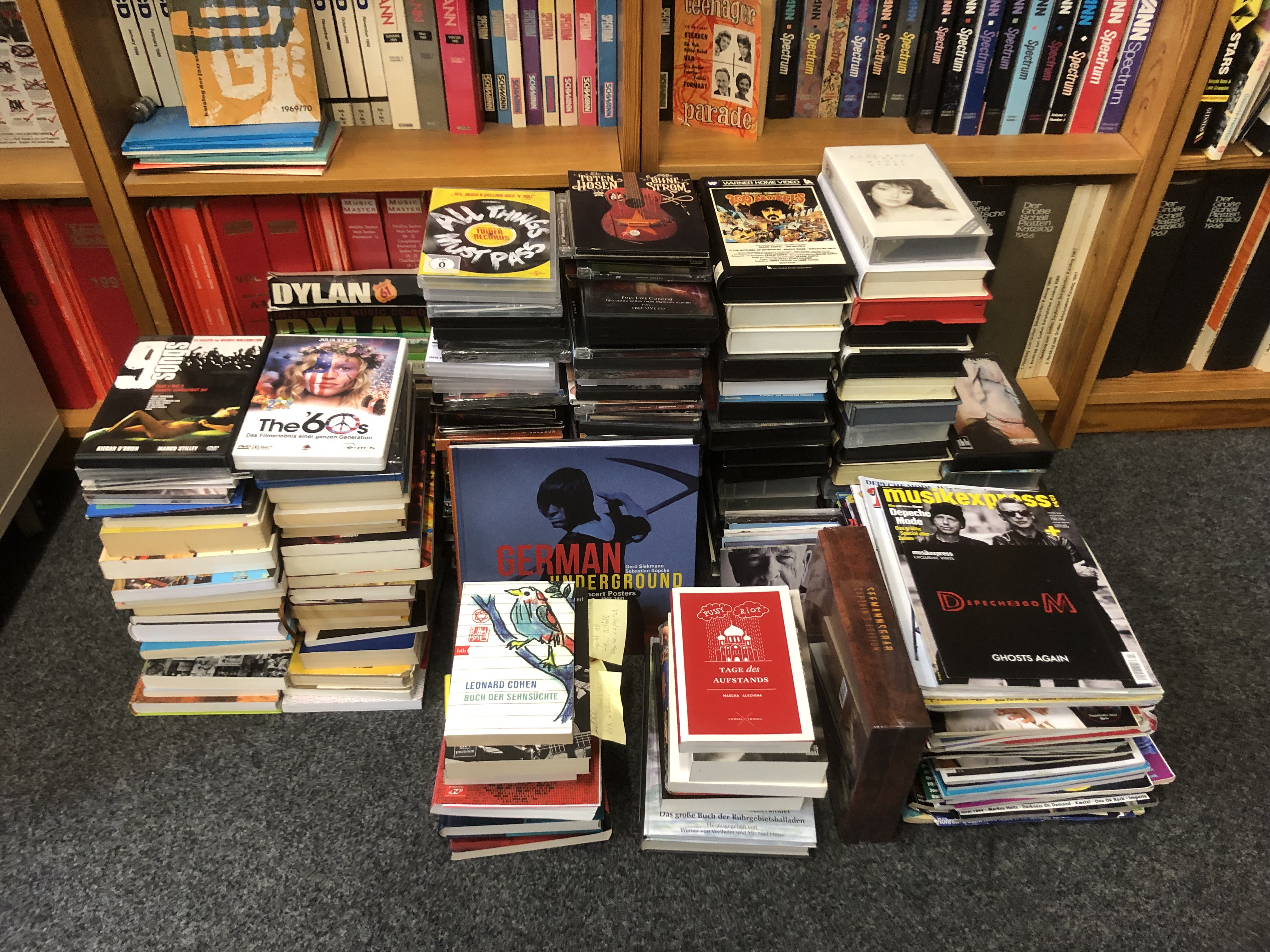
For decades we have been closely connected with Friedel Muders, the highly esteemed designer, label operator & publisher from Bremen. Again and again he gives us records, videos, books, magazines and graphic material from his collection. On his label, respectively in his music publishing house FUEGO, exciting indie acts continue to appear and we also benefit from the high-quality output. Recently he gave us again a load of his music treasures, for which we are very grateful.
New FaMI trainee in July

During the first two weeks of July, Leonie Hiestermann is completing an internship at the KKI. She is currently training to become a media and information services specialist (FaMI) at the Bremen State and University Library and is in her second year of training. We are grateful for her participation and are happy to give her an insight into our daily work. FaMI trainees regularly honor us and are always welcome.
Find of the month from the KKI archive _ June 2023
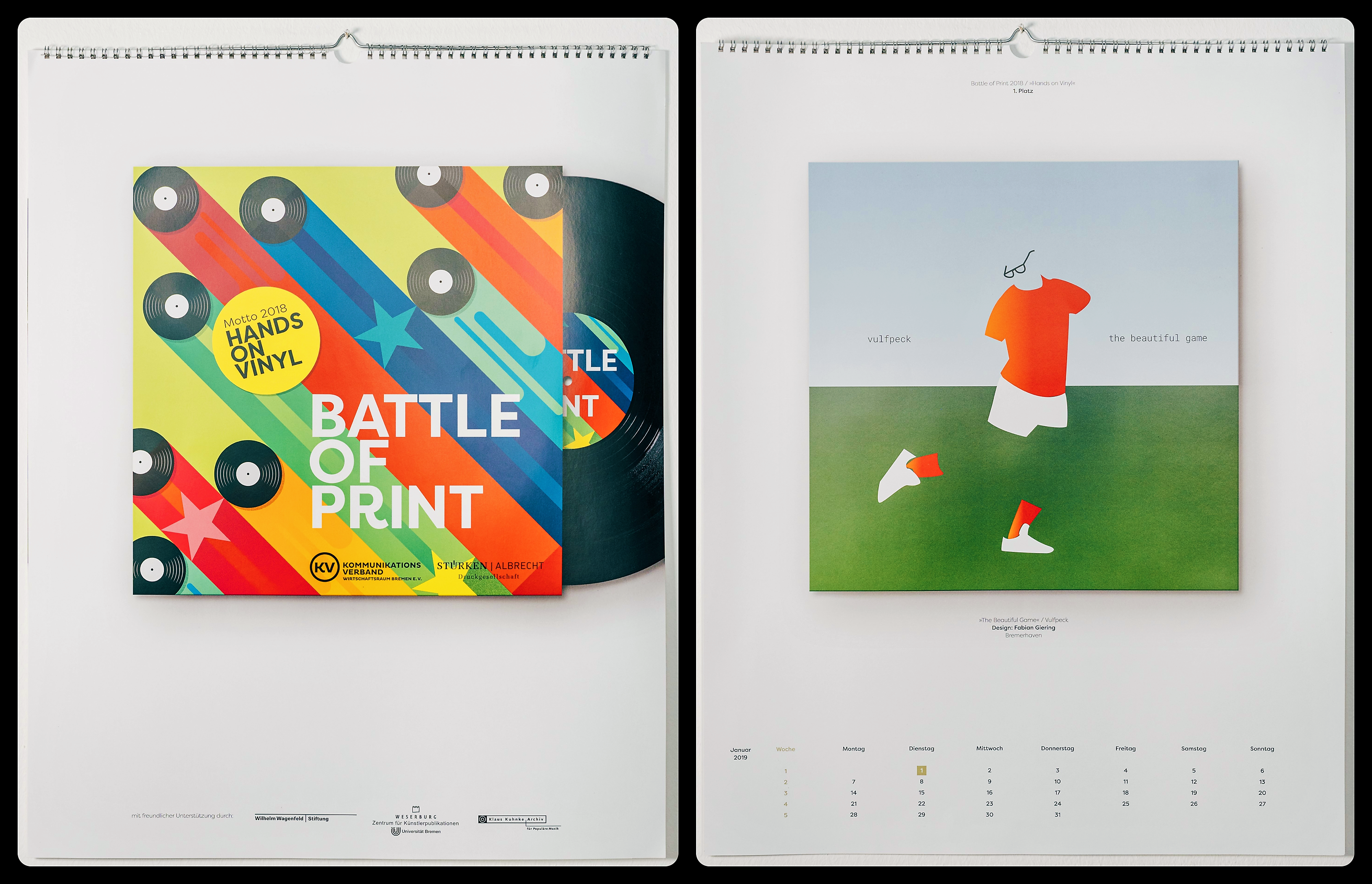
"Battle of Print. Hands on Vinyl (Motto 2018). The Winning Calendar 2019," published by Kommunikationsverband Wirtschaftsraum Bremen e.V., Bremen: Stürken | Albrecht Druckgesellschaft 2019.
In 2007, printing house Stürken | Albrecht from Bremen organized the 'Battle of Print' design competition for the first time. "From the very beginning, the aim of the 'Battle of Print' was to establish optimum networking between the printing house and creative professionals as well as the business community in and around Bremen," says a statement from the company. Since then, a motto for a calendar has been chosen each year, for which designers from the northwest of Germany can submit designs. The best submissions are selected and distributed via a cross-media campaign combining print media, social media, classic online communication and an exhibition including a vernissage.
The design competition is now organized in cooperation with other regional organizations, including, for example, the Kommunikationsverband Wirtschaftsraum Bremen e.V. and the Wilhelm Wagenfeld Foundation. In 2018, the Weserburg or the Center for Artist's Publications and the Klaus Kuhnke Institute for Popular Music (KKI) also participated in the competition under the motto 'Hands on Vinyl'. The six-member jury included Peter Schulze, the founder of the KKI, and Klaus Voormann, the musician and graphic designer from the Beatles' circle.
The motto 'Hands on Vinyl' aimed to stimulate re-designs of LP covers. In other words, the task was to redesign existing vinyl albums. Designs were to include the front and back covers of the records, as well as the respective record labels (in the center), and were to be submitted in the original sizes. From the entries, the three best were awarded prizes. Nine additional designs were included in the calendar, which impressively celebrates record cover art.
First place went to Fabian Giering from Bremerhaven (study: Digital Media Production / Bremerhaven University of Applied Sciences) with a re-design of the album 'The Beautiful Game' (2016) by US funk band Vulfpeck (see the right-hand side of the photo; the left-hand side of the photo shows the back of the calendar). Second place went to Asja Beckmann from Bremen (study: Illustration and Typography / Bremen University of the Arts) with her reinterpretation of 'Non-Stop Erotic Cabaret', an album by the British synthpop duo Soft Cell from 1981. Third place went to Ivana Kleßen from Bremen (study: Communication Design / Wandsbek School of Art), who redesigned the album 'Dynasty' (1979) by the US hard rock band Kiss.
KKI Music Exchange at the beginning of summer on June 21
at the University of the Arts Bremen
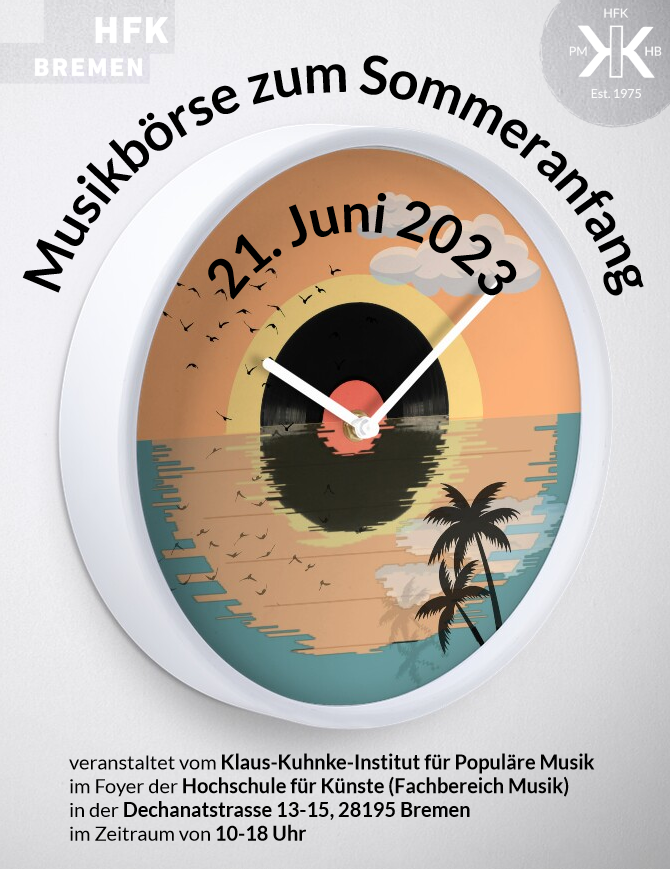
On Wednesday, June 21, 2023, our next Music Exchange will take place in the foyer of the University of the Arts (Department of Music, Dechanatstrasse 13-15). Just in time for the beginning of summer, we will offer doubles from the Klaus Kuhnke Institute (sound and image carriers, books, magazines, etc.) for sale. Between 10 a.m. and 6 p.m. you can make bargains and buy great music in sound, picture and writing - mainly popular music, but also early, classical and new music, as well as music of the world. The Music Exchange is open to all, that is HfK members and external guests.
First meeting of the KKI Circle of Friends
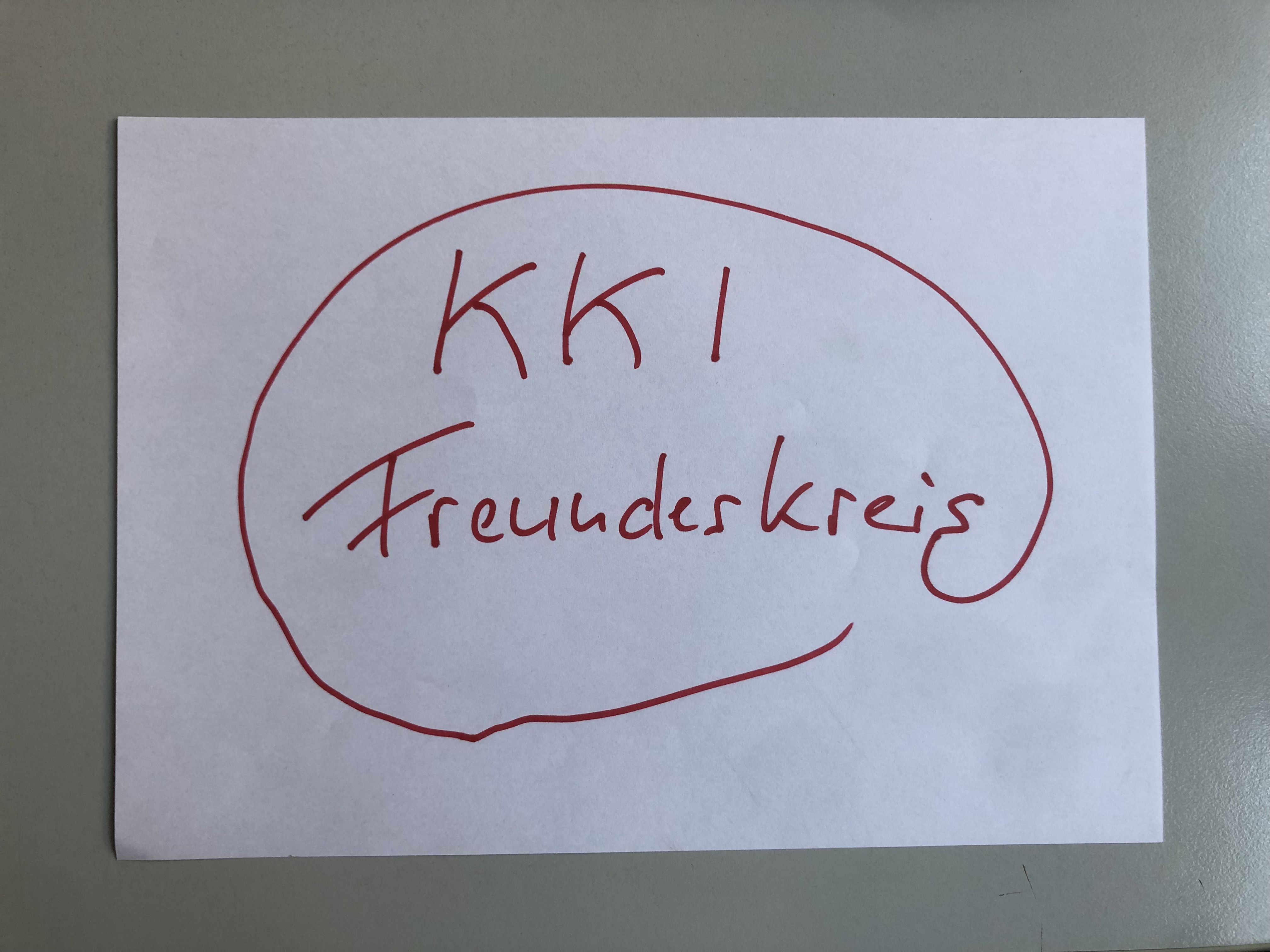
On June 8, the first meeting of the newly formed KKI Circle of Friends took place. Three volunteers came together to get to know each other over coffee and pastries and to talk with Nico Thom about getting involved in the KKI. We are happy about the support! The next meeting will take place on July 27, 10 a.m. at the KKI. All interested persons are cordially invited.
KKI participates (again) in exhibition on the subject of
"Communication. From Depeche to Tweet. The Bremen Archives and Radio Bremen"

From June 6 to 24, 2023, you can visit a great traveling exhibition of the Bremen Archives Working Group at Weserpark Bremen (Hans-Bredow-Straße 41, 28207 Bremen), in which the KKI is also involved. Admission is free.
More information can be found in this flyer.
Help wanted for research project on Bremen's pop music history
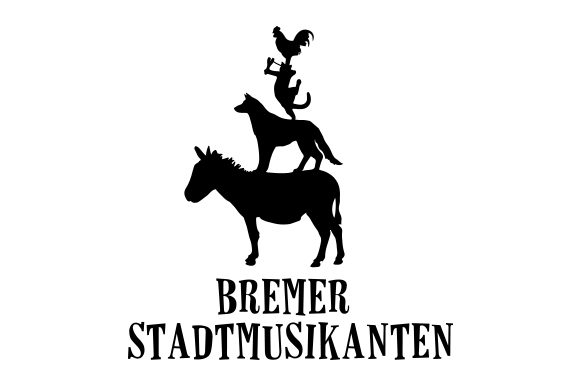
The KKI has just started a research project with the working title "Bunte Stadtmusik - Populäre Musik in Bremen und umzu". We would like to work up the music history of the city of Bremen and the immediate surrounding area for the field of non-classical music. We are interested in all relevant music styles - from rock to pop, from punk to hip hop, from techno to metal, from folk to blues and of course jazz. No matter if you are a singer-songwriter, a world musician or a reggae artist from Bremen or the surrounding area or if you know any of them, please contact us to tell us your personal stories. Club owners, event organizers, musician initiatives, studio, festival or record label operators are also welcome to contact us to tell us about their activities in the past (and present). Of course, we are also looking for pictures and texts about solo artists, bands, locations, competitions or associations that have made, offered or promoted popular music (in the broadest sense) in Bremen or the surrounding area. Just call or send an email to kontakt@klaus-kuhnke-institut.de.
Find of the month from the KKI archive _ May 2023

Transita - A portable radio by Nordmende (Bremen, around 1960)
At one time, radios, record players and television sets were produced in Bremen and enjoyed great popularity. Originally, Otto Hermann Mende had founded the company Radio H. Mende in Dresden in 1923. Since the company had been involved in the German armaments industry during the Second World War, the factory was destroyed by the Allies. In 1947 it was rebuilt in Bremen by Martin Mende, the nephew of the founder. Due to protests, the family or company name was slightly modified. From then on, the company bore the name Nordmende and developed into one of the leading German manufacturers of consumer electronics in the post-war period.
Alongside other German companies such as Metz, Saba, Grundig and Telefunken, Bremen's Nordmende held its own on the international market. From the beginning of the 1950s, television sets were produced in addition to radios and record players, and the sets were exported to more than 100 countries. There was a kind of gold-digger mood at Nordmende and so further factories were built in the Bremen area.
One of Nordmende's trademarks was its modern product design. In particular, a mobile transistor radio called "Transita" represented the young generation's urge for freedom and coolness, as well as the sound of the time: the transition from the rock'n'roll of the 1950s to the beat music of the 1960s. "Transita" was practical, because its compact dimensions and battery operation meant it could easily be taken with you wherever you went, allowing you to receive the exciting new music wherever you went.
At the end of the 1970s, Nordmende fell into crisis, similar to other German manufacturers, e.g. Saba or Telefunken. All three companies mentioned were taken over by the French company Thomson and then successively liquidated or rationalized away. Despite support from the Bremen Senate, the Nordmende factories in Bremen and the surrounding area had to be closed. However, Nordmende's brand rights were sold on and so "Transita" experienced a rebirth in 2017 as a Nordmende DAB digital radio in retro design.
The Bremen Archives Working Group (including the KKI)
receives the 2023 Recognition Award from the Wittheit
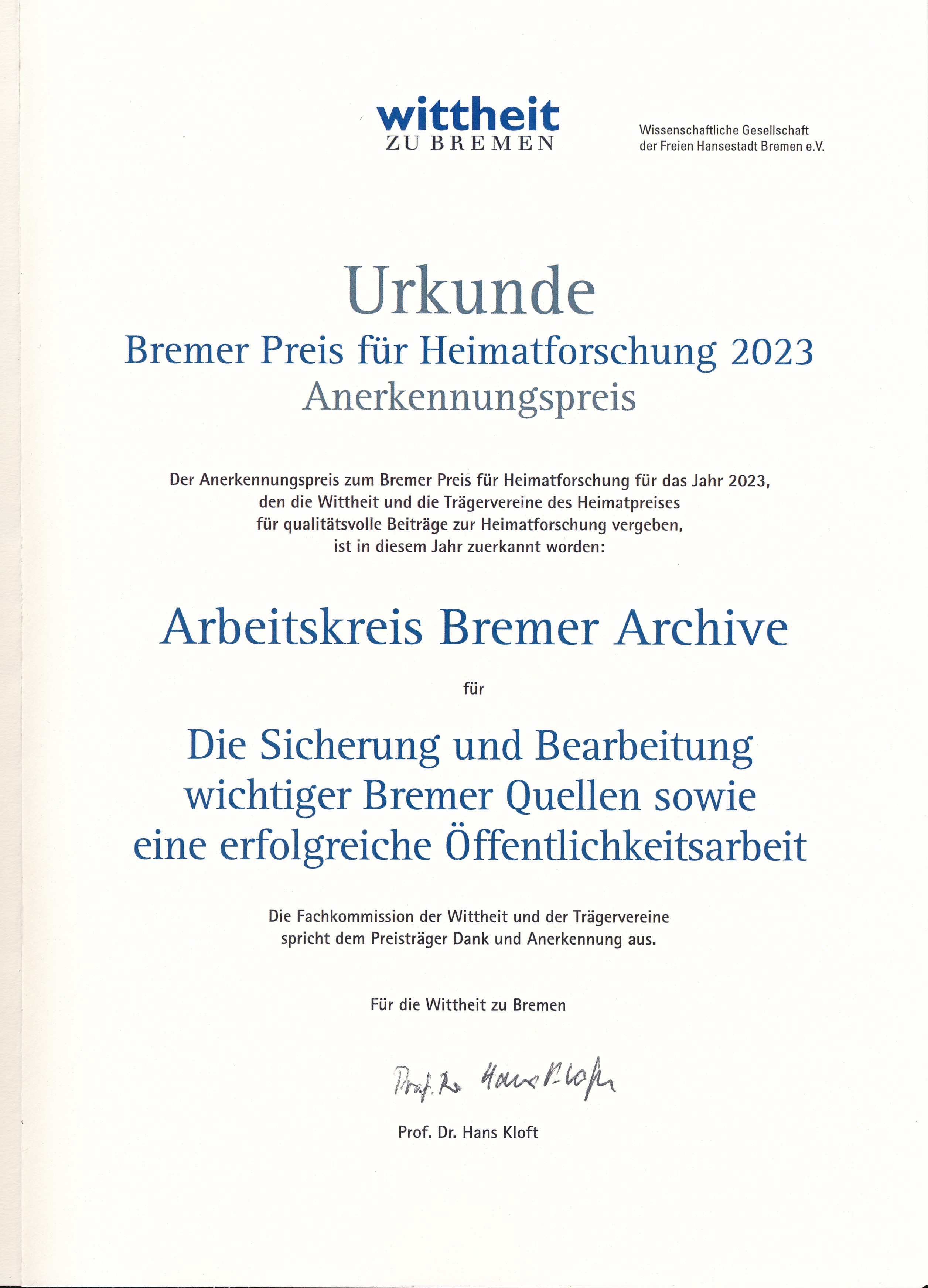

The KKI is part of the Bremen Archives Working Group, which brings together 40 archives from Bremen and Bremerhaven. On May 2, the Wittheit zu Bremen, a scientific society of the Free Hanseatic City of Bremen, awarded the Bremen Archives Working Group a recognition prize for local history research, more precisely for "securing and processing important Bremen sources as well as successful public relations work". We are pleased together with the colleagues of the working group and take the award as an incentive for a committed continuation of the cooperation. We would also like to thank Sigrid Dauks, Director of the University Archives of the University of Bremen, for accepting the award and for her speech of thanks. More information about the working group can be found here: https://www.bremer-archive.de
Find of the month from the KKI archive _ April 2023

The East Is Red. A Pageant of the Revolution, Performed in Peking by 3,000 Workers, Peasants, Students and Soldiers of The People's Republic of China (Box mit 3 Vinylplatten & Begleitheft, New York: Paredon Records 1971)
Whether the East is really red is being hotly debated again these days. The war in Ukraine and the alliance between Russia and China provide occasions to think again about geopolitical divisions such as East versus West or communism versus capitalism. It is important to remember that such dualisms are exacerbations and that the world is de facto more colorful or multifaceted.
A food for thought in this direction provides this box with three vinyl records and an accompanying booklet. The box is dedicated to China and contains the People's Opera or the epic "The East Is Red", which was created for the 15th anniversary of the People's Republic (founding year: 1949) in 1964. In it, the chronology of the Chinese Revolution is traced.
"The East Is Red" was also made into a film. The film was released in China in 1965 and shows the historical events in a stylized production, which is strongly influenced by Maoism and already foreshadows the upcoming Cultural Revolution (1966-1976). In a pompous visual language, huge state buildings as well as crowds of people are depicted, singing and dancing in synchronization. This is accompanied by a huge orchestra composed of both traditional Chinese and classical European instruments. The massive choral singing is repeatedly interrupted by solo arias and spoken text passages.
The box set here contains the soundtrack of the film. The subtitle says: "A Pageant of the Revolution, Performed in Peking by 3,000 workers, peasants, students and soldiers of the People's Republic of China". Curious is the fact that the vinyl record box was not released in China but in the USA, in 1971 by the Brooklyn/New York based label Paredon Records (1970-1985), which specialized in revolutionary, left-wing movements and their respective protest music.
The pronounced political impetus to be found in this box stimulates reflections on supposedly clear boundaries between East and West or communist and "free" states. Not least the fact that people from China also study at the University of the Arts Bremen (as well as people from Russia and Ukraine) should give pause for thought. But the boundary between classical and popular music is also crossed in this production. This is literally music of/for the masses.
KKI founder Peter Schulze gives up the artistic direction
of the Bremen trade fair jazzahead!

With a warm embrace Claudia Roth (the German Minister of State for Culture and Media) said goodbye to Peter Schulze (the Spiritus Rector of the KKI) from his position as Artistic Director of the Bremen trade fair jazzahead!. He shared this leadership for many years with Prof. Ulrich Beckerhoff, who also stepped down to pass on the artistic direction to Götz Bühler.
The Jazz Institute Darmstadt as guest at KKI
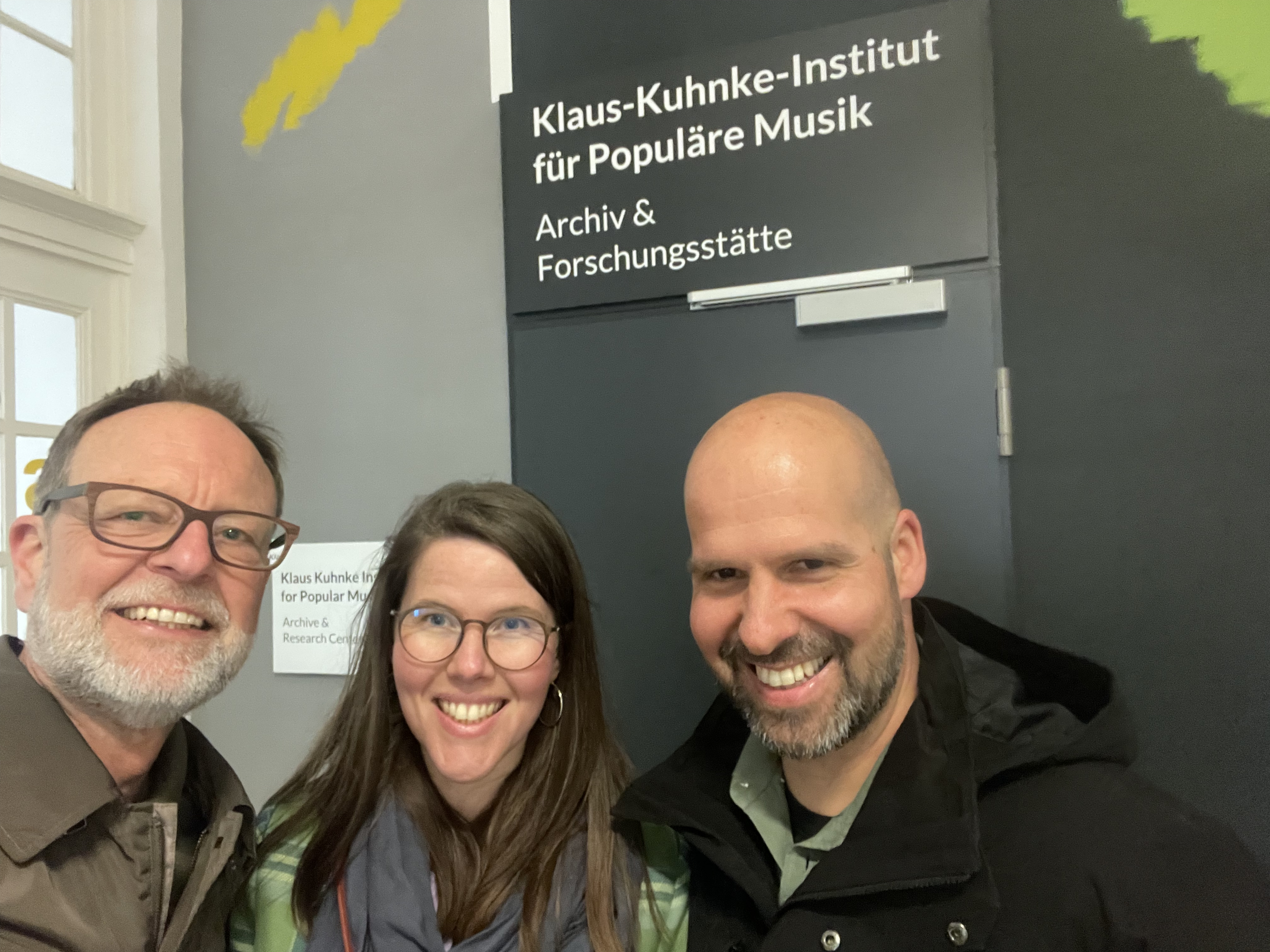
In the context of the Bremen trade fair jazzahead! the dear and esteemed colleagues from the Jazz Institute Darmstadt (Germany) have visited us. With Arndt Weidler and Marie Härtling we talked shop and indulged in culinary and musical delights. Long live jazz and the "international understanding" power of archival expertise!
We are present at the jazzahead!... with a gift and a presentation


The Bremen trade fair jazzahead! is coming up and we are of course there again. This time we had an extra giveaway produced that promotes the KKI with the slogan "Where Jazz Is Popular", because of course jazz is popular with us! In addition, we have developed an animated presentation together with the jazz department of the University of the Arts Bremen, which will be shown during the Clubnight on Friday (28.04.) in the jazz club or the Mensa of the UA Bremen. The show starts at 7:30 pm.
By the way: If you would like to have a guided tour through the archive rooms of the KKI beforehand, you can come to the KKI on 28.04., at 6:15 pm. The tour can be offered in German and English.
Another move of the Mohns Mohnssen Collection
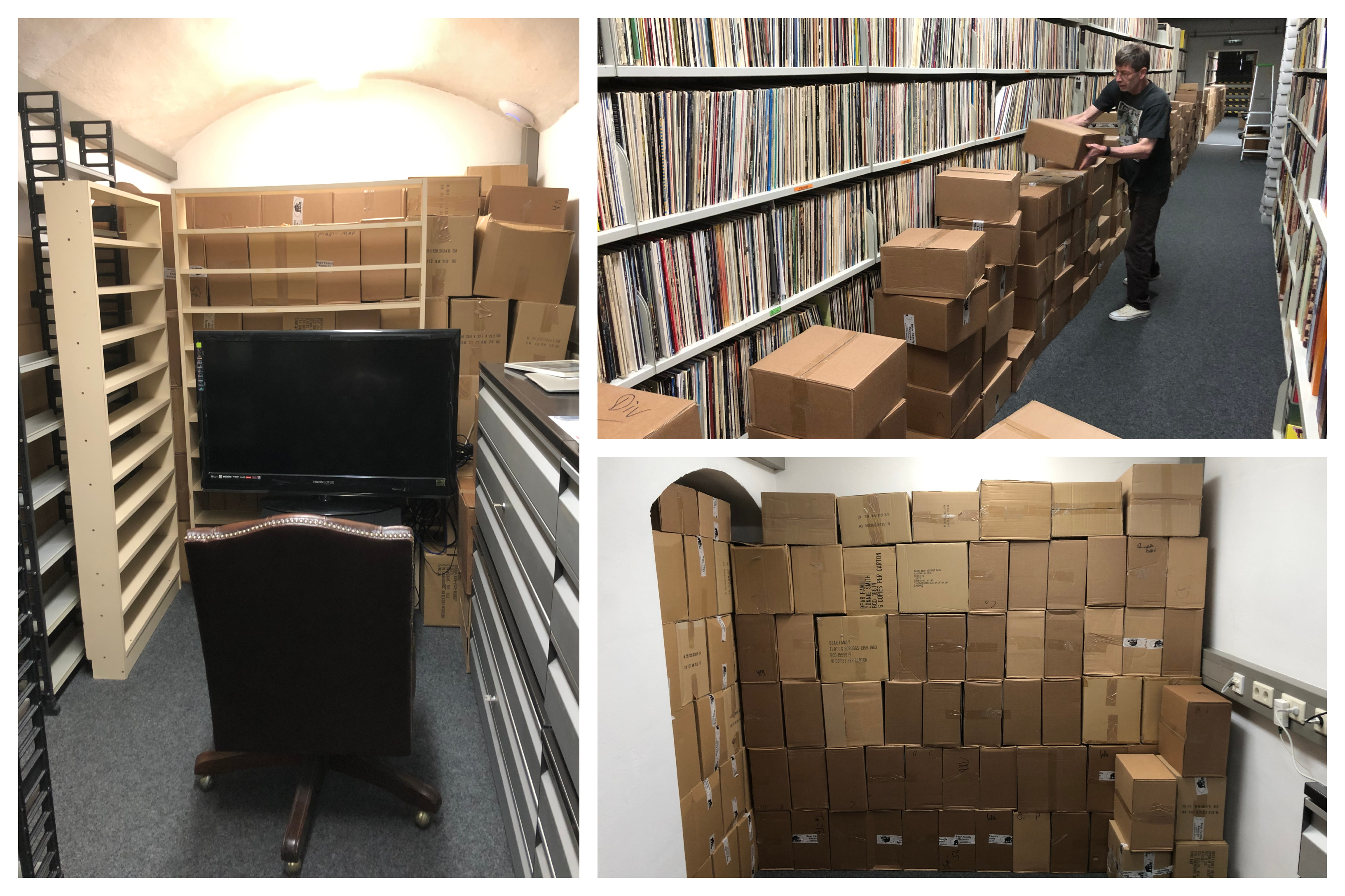
At the beginning of 2022, we took over the large collection of Bremen's Mohns Mohnssen in his will, who passed away in 2021. 300 boxes of the finest US country music. The only question was: Where to put them? First we rented an external storage facility. Then we moved them to our archive rooms in the University of the Arts Bremen, where they stood around in the hallway for a few months. Now they have been moved again - props to the hard-working colleague Till! - and are now no longer blocking the vinyl shelves.
Sale of two studio tape machines
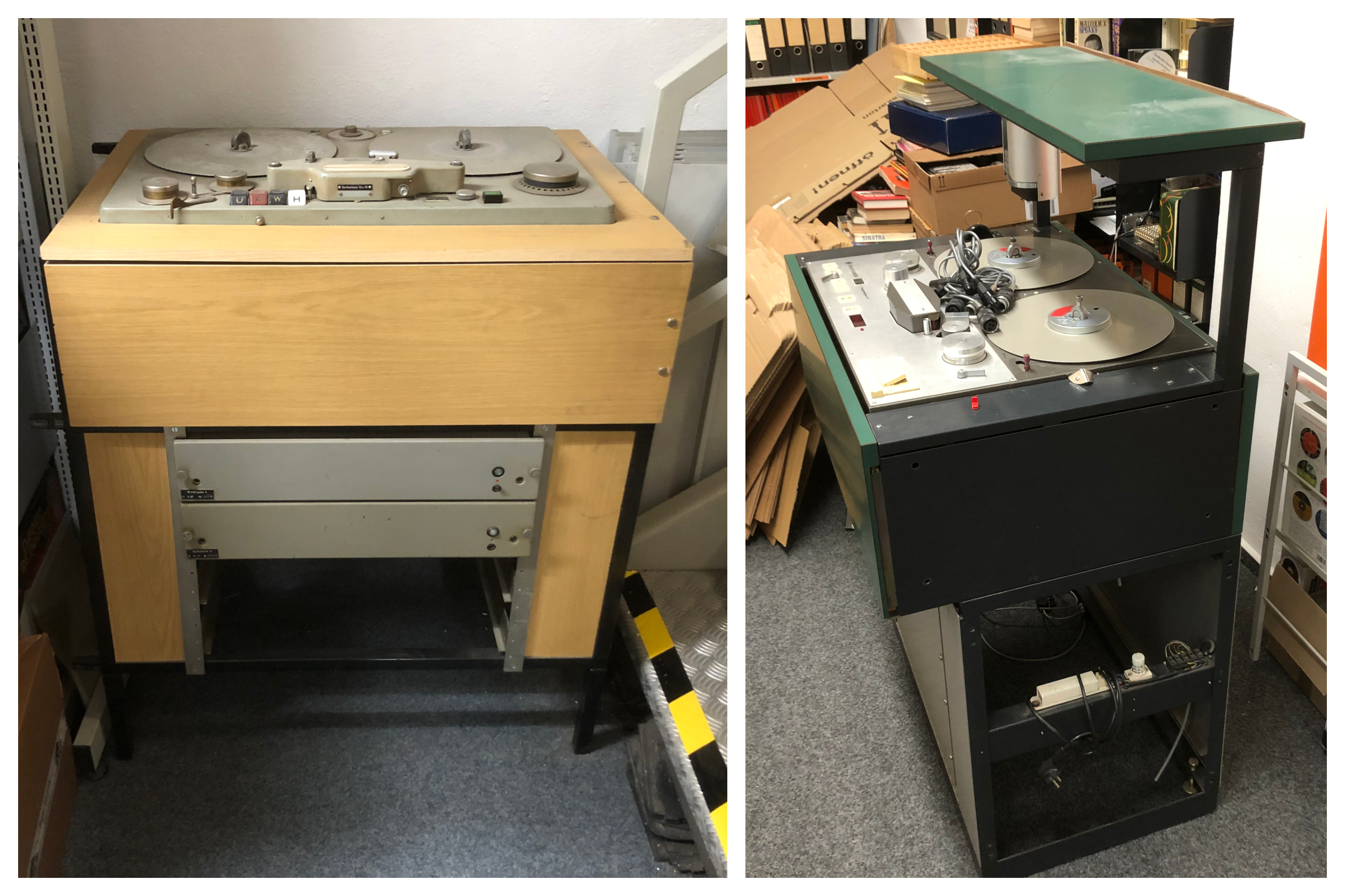
We have parted with two historic studio tape machines (models from the 1950s and 1960s respectively) that had been sitting unused in our archives for many years. A passionate collector from Trier won the bid. We therefore know that they are in good hands. A win-win situation.
Find of the month from the KKI archive _ March 2023
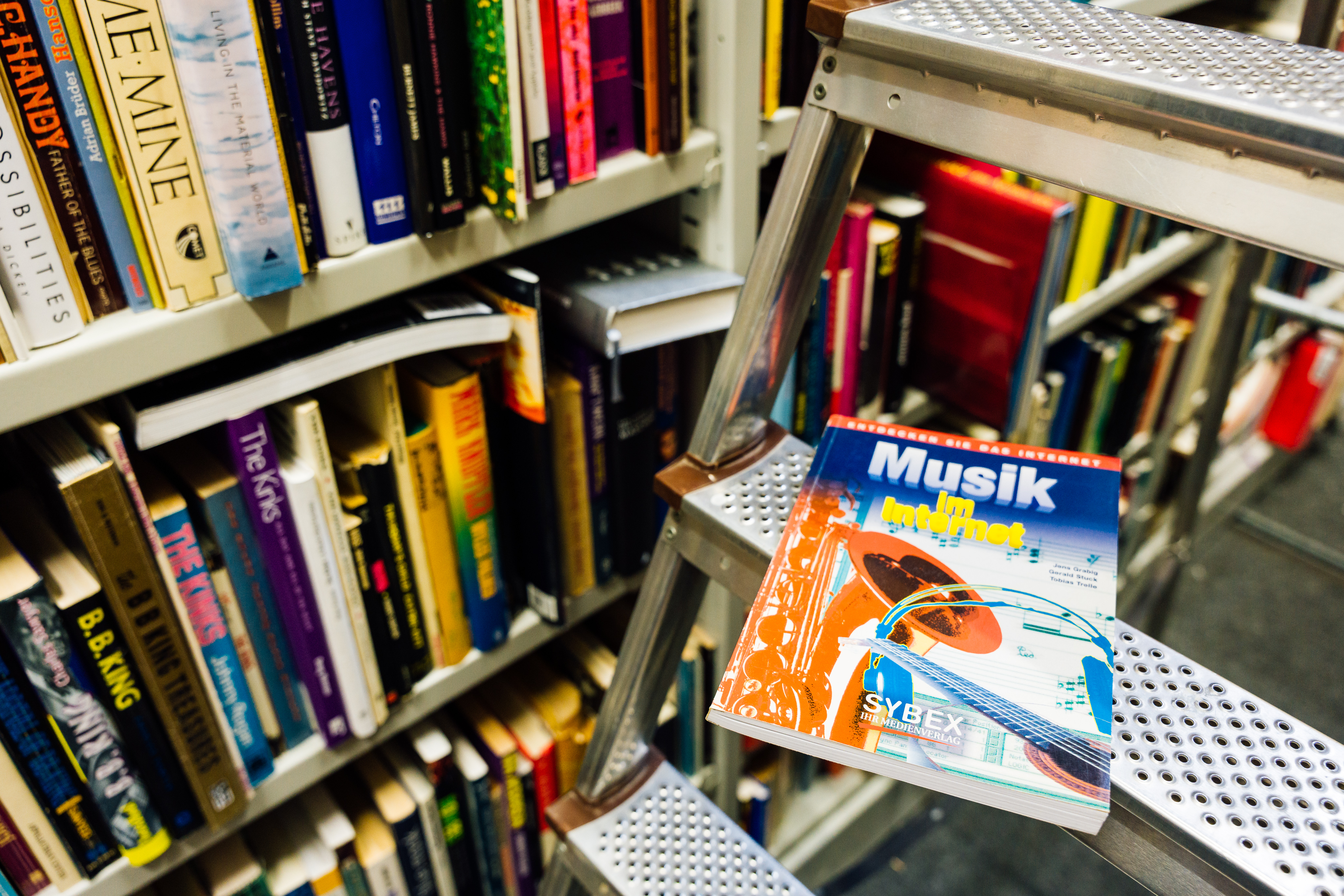
Jens Grabig, Gerald Struck & Tobias Trelle: "Musik im Internet", Düsseldorf et al.: Sybex-Verlag 1995.
When this book was published 28 years ago, it was not possible to foresee how the Internet and its music offerings would develop. Nowadays, a banner like "Discover the Internet" on the cover of the publication may seem cute, but at that time it could not be assumed that all potential readers were familiar with this worldwide communication network. It had simply not yet reached the general public. Although its origins can be traced back to the 1960s, when the U.S. military began experimenting with it, it took almost three decades before its commercial potential was recognized and exploited. For many years, scientists from a variety of disciplines had been working on the Internet, developing the technology behind it and testing its potential applications.
About the authors of the book it says on the cover: "Jens Grabig is an internaut of the first hour. With his collaborators Gerald Struck and Tobias Trelle, he is (almost) around the clock 'online' to explore the best places on the Internet for you". Grabig and his team published similar books on the Internet in the mid-1990s, including "Sport im Internet" (1995), "Reiseplanung im Internet" (1995) or "Erotik im Internet" (1995), all of which were published by Sybex, one of the "pioneers in the computer book market in Germany," according to the publisher's website.
Just how little music-related online information was still available can be seen from the blurb alone: "It [the Internet] offers more than 1000 web pages on over 1600 music groups. [...] Exchange information in newsgroups, or download sounds and videos to your hard disk. Find out about current concert dates and discographies". Nevertheless, the entire stylistic spectrum was apparently already available. "The variety of information is enormous. You can find what interests the fan's heart on all genres: whether mainstream or underground, classic and rock, pop, rap, hip-hop, soul, jazz, beat, blues... ." Since there was still a lack of higher-level (streaming) platforms and meta-search engines, a publication like this made perfect sense.
After introducing the "biggest music fair in the world", the authors give a number of tips on software installation, the use of the Internet and "netiquette". A glossary describes the most important terms (e.g. e-mail, HTML or link). The second part of the book arranges Internet addresses of solo artists and bands under generic terms such as "Alternative, Indie & Industrial" (e.g. Dead Can Dance, Einstürzende Neubauten or Sonic Youth), "Hard & Heavy" (e.g. AC/DC, Scorpions or White Zombie), "Hip-Hop, Jazz, R&B" (e.g. Albert Ayler, Jazzkantine or Snoop Doggy Dogg), "Rock & Pop" (e.g. Paula Abdul, Björk or Die Prinzen) and "Techno, Rave & Ambient" (e.g. 2 Unlimited, Laurent Garnier or Marusha). Furthermore, websites are sorted under "Archives & Online Magazines" (e.g. Audio Database, Techno.Net or Virtual Radio), "Instruments & Music Software" (e.g. Fender, MIDI Farm or Steinberg) as well as "Labels" (e.g. BMG, Geffen Records or Polygram) and "Crazy & Miscellaneous" (e.g. Beavis & Butt-Head, Deutsche Welle Musikwunsch or Rock'n'Roll Clubs in Österreich). Of course, websites are also given for "Classical Music" (e.g. Klassische Gitarre, Bach or New Zealand Symphony Orchestra). All in all, an exciting document about the beginnings of (popular) music on the Internet.
KKI-Workshop in the context of the Spring School of the University of the Arts Bremen
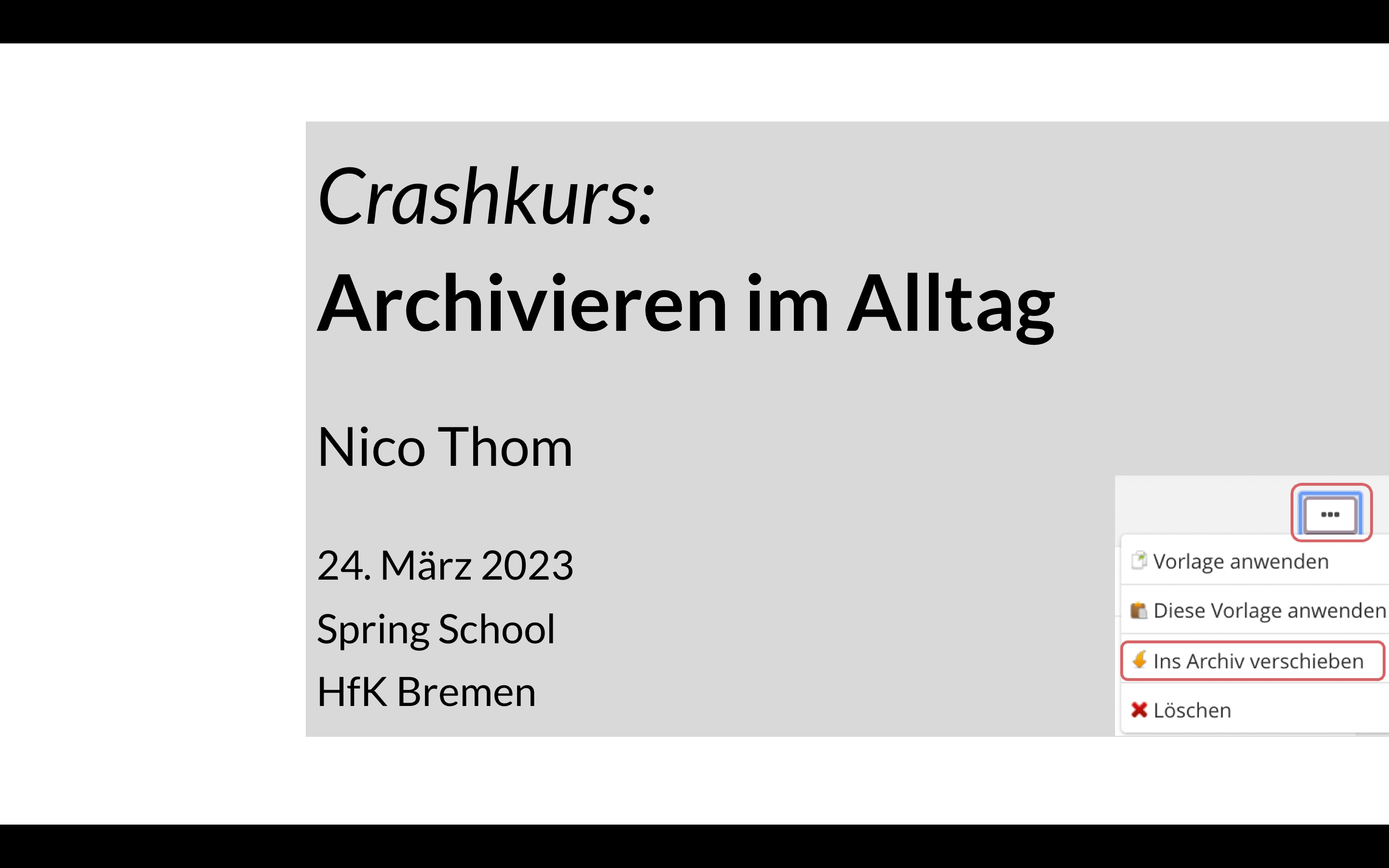
We contributed to the Spring School of the UA Bremen with a one-hour online workshop. Here is the description text:
"Musicians and artists should also deal with archiving, because it can be extremely helpful in professional and private life. Nowadays, the topic of archiving is described with terms such as document, knowledge or information management, whereby the digital organization and storage of files plays an increasingly important role. However, paper documents such as contracts, certificates, notes, pictures, photos and the like also need to be systematized and stored for the long term in order to be readily usable for private or professional purposes. Archiving also includes sorting out and disposing of old and unused documents or AV media (sound and image carriers). The crash course wants to give assistance for the (working) everyday life of musicians and artists and present practical examples that can be applied quickly and easily. Insights will be given into the working methods of the Klaus Kuhnke Institute of the University of the Arts Bremen, which is an archive as well as a research center for popular music and stores all kinds of auditory and visual media."
Redesign of the KKI access
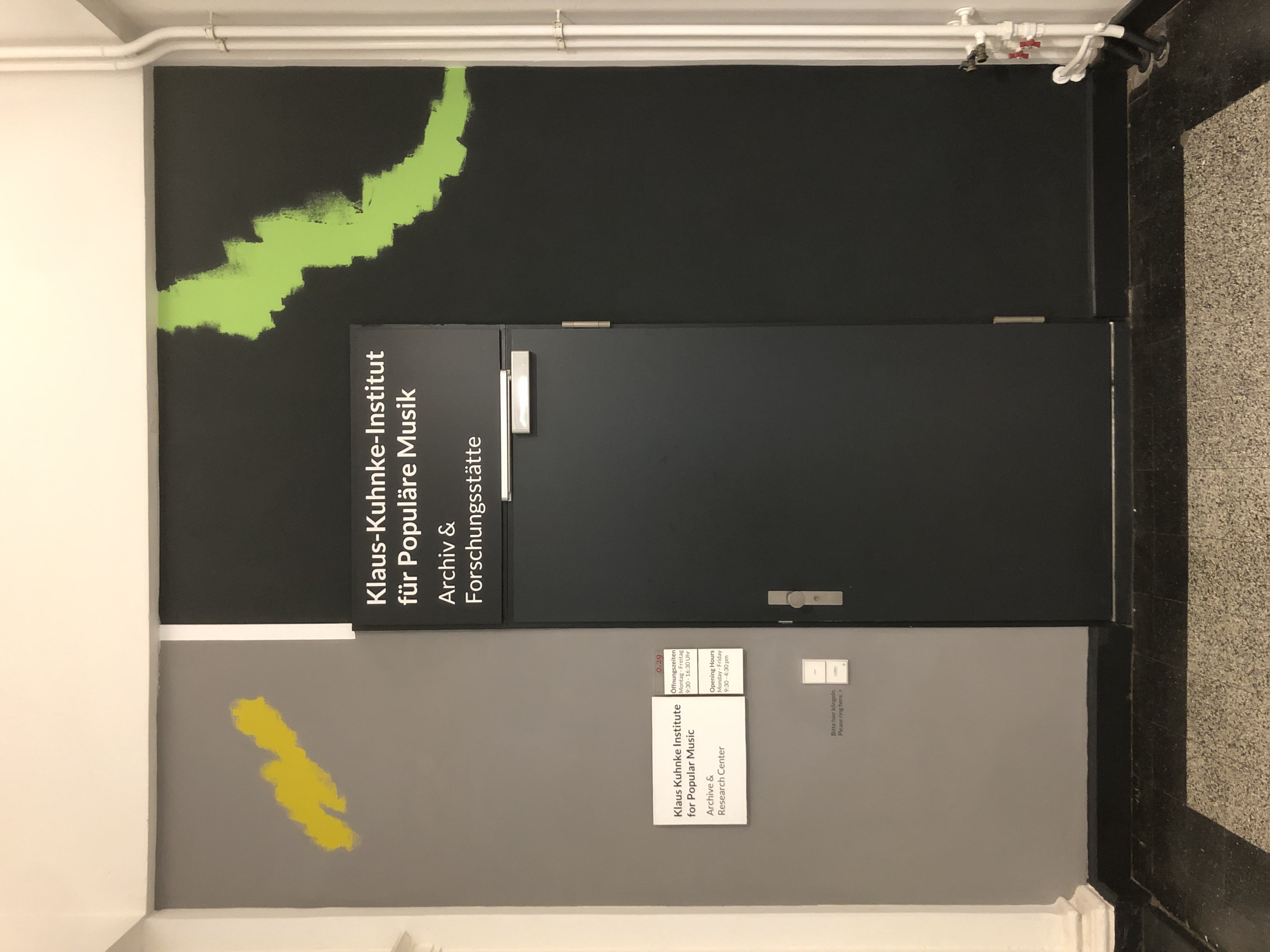
After more than thirty years, we have redesigned the access to the KKI. Our intention was to tie in with the corporate design of our web presence. The simple black-grey-white painting is broken up by two accents. These are the translucent original colors (yellow and green). In this way, the historical layers of the KKI are to be appreciated.
2023 - The year of the big clean-up at KKI
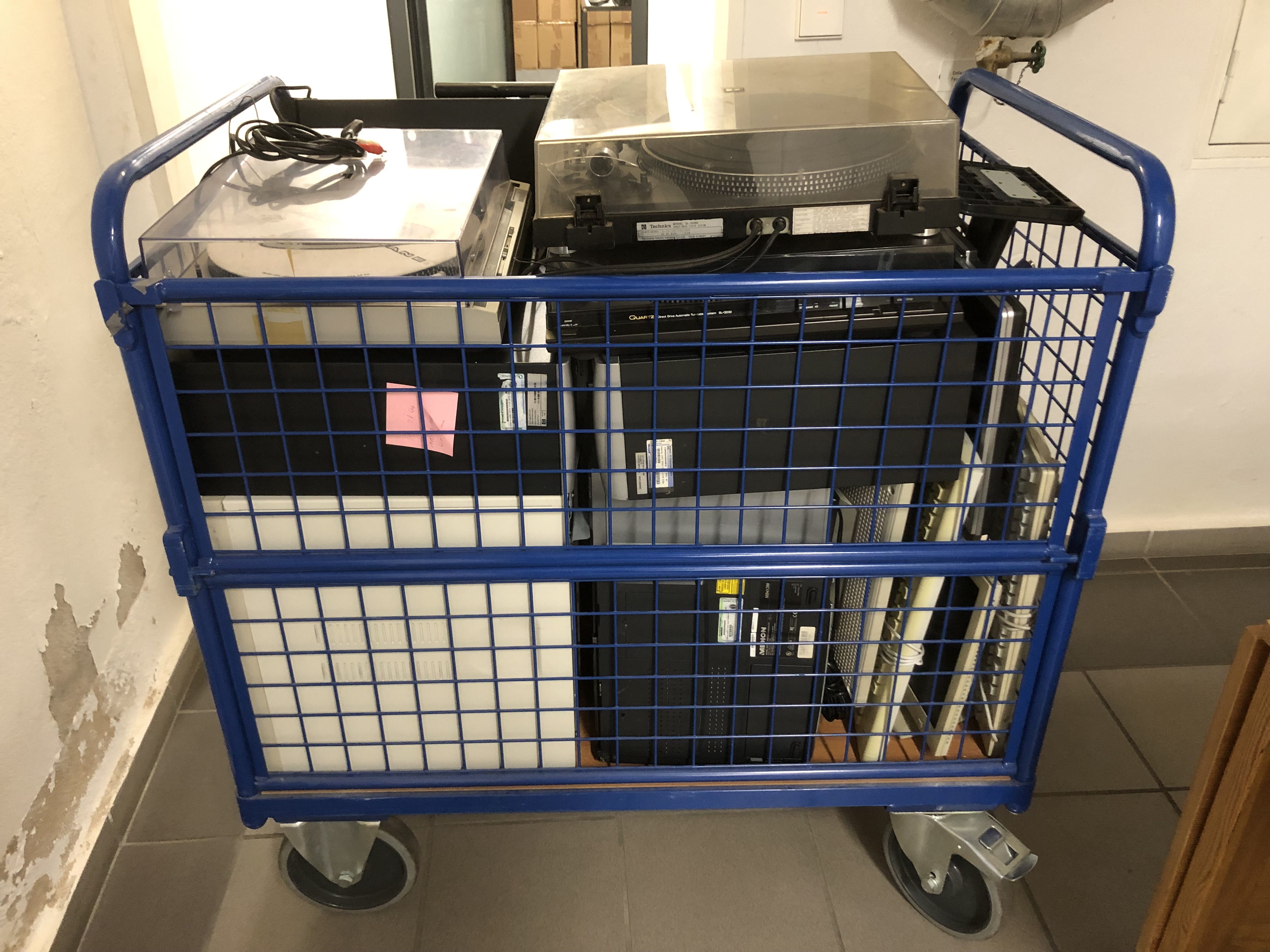
We have set ourselves a lot of goals for 2023. After more than thirty years in the same premises, we want to really clean up and sort out in order to create order and space. Over the years, we have accumulated a lot of things that are no longer usable - for example, a lot of electronic waste (old and broken computers and ailing hi-fi equipment). Of course, we don't throw away anything that could still be used in any way. We are fans of upcycling and sharing concepts and pay attention to the sustainable use of the objects or items entrusted to us.
Find of the month from the KKI archive _ February 2023

Versengold: "Nordlicht" (Limited fan box, RCA/Sony/Fuego 2019)
It is amazing what range the band Versengold achieves. It was founded in 2003 in the Bremen area (Osterholz-Scharmbeck) and will celebrate its twentieth anniversary in 2023. The German-language folk rock of the six musicians relies, among others, on traditional instruments such as the nyckelharpa, the bouzouki, the mandolin or the fiddle. In 2022, the eighth album of the formation was released under the title "Was kost die Welt" ("What costs the world") and reached number 1 in the German album charts.
At this point, however, it should be about the previous album "Nordlicht", which was released in 2019 and still reached number 4 in the German album charts. Due to the commercial success, a limited fan box was also brought to market. This contains, in addition to the "Nordlicht" CD long player (14 tracks), a Blu-ray disc on which the video documentary "15 years Versengold. The anniversary concert live in Hamburg" (with 28 songs) from 2018 is recorded. In addition, merchandise products are enclosed such as a storm lighter, a chain with pendant and a shot glass.
The box offers a lot of handmade music, which is lively performed and comes with ironic lyrics. Thematically, the fast dance songs and scratchy ballads revolve mainly around the rough north, the sea, medieval drinking bouts, reports of historical events and love relationships. Every now and then, socio-critical allusions are woven in, which refer to the present.
The concert recording from 2018 celebrates the band's fifteen-year history with a cross-section of original songs in front of a large audience. The fans sing along and dance exuberantly. A number of guest musicians are welcomed on stage. Versengold's music obviously works very well live, not least because it is presented in a professional and lively manner - but without much fuss. Just the musicians, their instruments and the joyful performance.
High-end sound at KKI
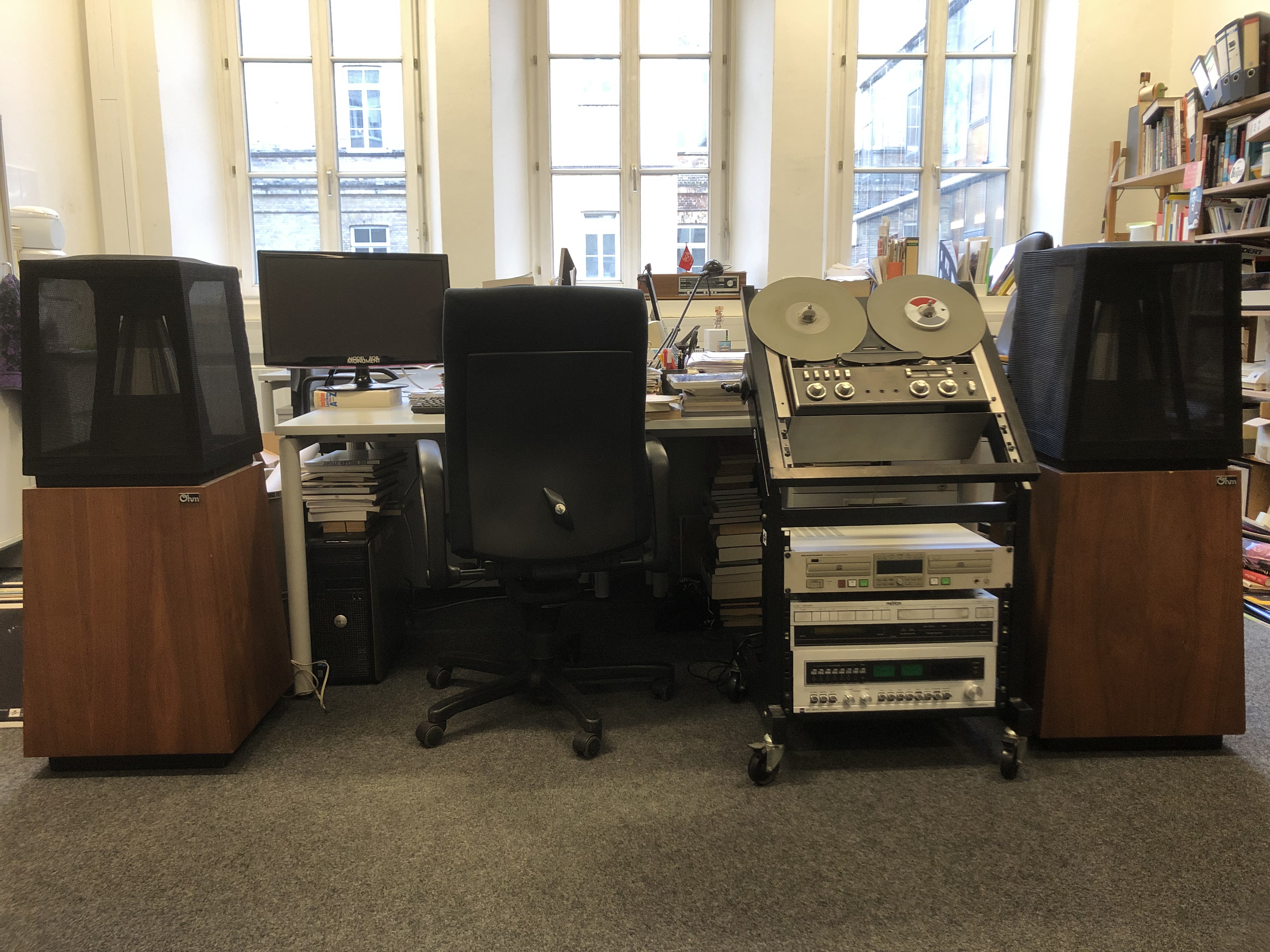
We are in love... with our "new" high-end speakers from Ohm (NY/USA). Strictly speaking, they are not even that new (year of manufacture 1975!), but they still sound fantastic! An incredible pleasure for the ears and a true reference sound! We are moved to tears. In addition, these wooden 360-degree speakers are also eye-catching. Gorgeous!
Cooperation with Bremen-based music publisher/label Fuego

We have always been on friendly terms with the Bremen-based music publisher/label Fuego, which is run by Friedel Muders. Now we are intensifying our exchange and cooperating on two eBook projects. On the one hand, the first (English-language) volume of our "Bremen's Contributions to Popular Music Studies" will soon be published by Fuego under the title "Toddlers/Children's Songs. The Popular Music of the Youngest?". On the other hand, we are planning to republish the "History of Popular Music" (2 volumes) in 2024, which was last published by the three founders of the archive (Kuhnke, Miller & Schulze) in 1998 via Bear Family Records.
Find of the month from the KKI archive _ January 2023
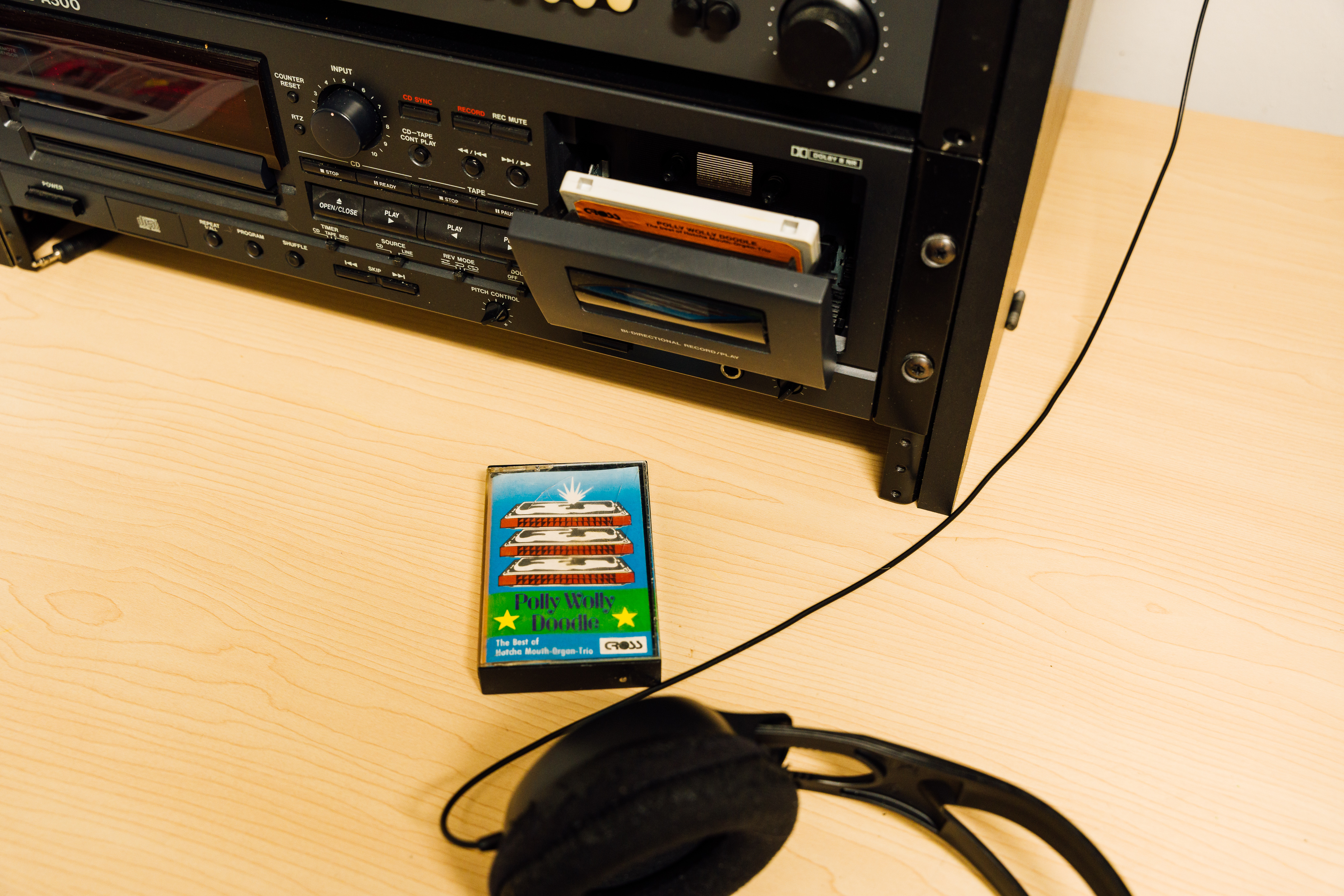
Hotcha Trio: "Polly Wolly Doodle. The Best of Hotcha Mouth-Organ-Trio" (Compact cassette, Cross [without year])
Whimsical music and an untraceable album are the focus this time. The "Hotcha Trio" from the Netherlands was quite successful decades ago with cheerful harmonica music or musical clowning. Inspired by harmonica star Borrah Minevitch and his group "The Harmonica Rascals", the formation started in 1938 in Rotterdam under the name "5 Hotchas", at that time still with five members.
When the brothers Wim and Cor Belder emigrated to Australia in 1949, Joop Heijman (solo harmonica), Geert van Driesten (bass harmonica) and Eddie Sernee (vineta or chord harmonica) remained, and from then on they formed the Hotcha Trio. In the following years the bass harmonica players changed a few times, but the trio continued until 1970. The heyday of the Hotcha Trio was in the 1950s. At that time they were considered the "Nederlands Populairste Artiesten". They recorded numerous records, toured the world, appeared in variety shows and on television, and had roles in various films as well as lucrative advertising contracts.
The Philips label also marketed the trio in the German-speaking world by having the harmonica virtuosos set children's and folk songs as well as hits to music (e.g. Blumenwalzer, Wiener Blut or Du liegst mir am Herzen). Sometimes the trio was accompanied by a nameless "rhythmic accompaniment", i.e. a double or electric bass and drums. Stylistically, the trio covered a wide spectrum and tried their hand at rock'n'roll, country as well as Latin tunes. The uptempo arrangements were always snappy, humorous and danceable.
The KKI has an original compact cassette in its archive that presents a best-of selection from the trio. Unfortunately, the find reveals little information. The year of release is unclear (probably sometime in the 1980s). At least one learns that the cassette was produced or released in Germany. However, nothing can be found about the designated music label called "Cross". The album does not appear in any discography of the trio. The short note "Trad. Bearb. J. Sprangers" suggests that this could be the name of an external arranger. The appearance of the cassette is uncharitable and indicates a cost-saving production method. The music itself is nevertheless worth a listen.
Study of the Don Quixote - Reception in Jazz
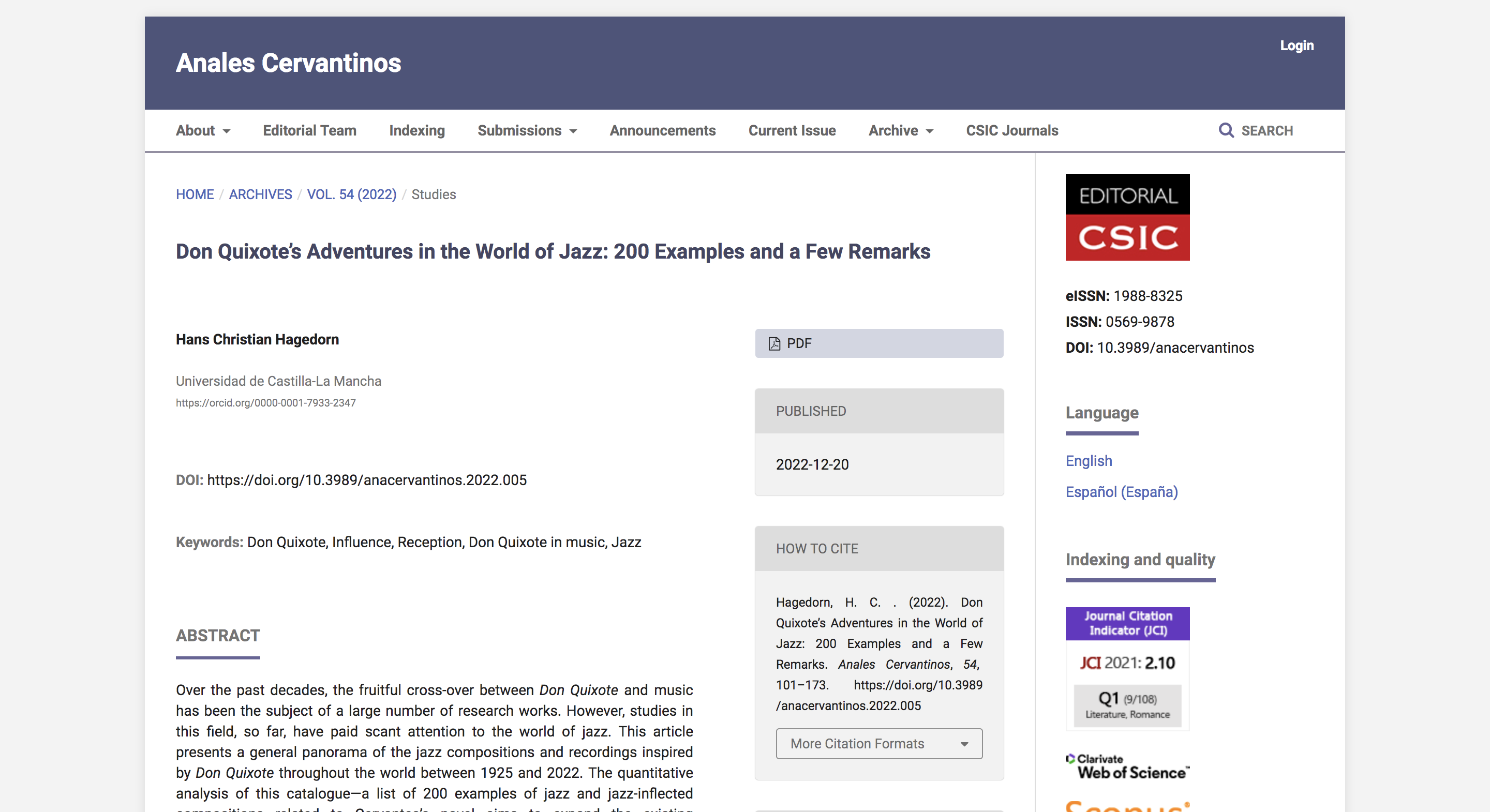
Prof. Dr. Hans Christian Hagedorn, a user of our archive, who researches and teaches as a Germanist and literary scholar in Spain, has made the results of his research available to us. We are pleased to refer to his English-language study on the reception of Don Quixote (Cervantes) in jazz. It can be viewed at the following open access link: https://analescervantinos.revistas.csic.es/index.php/analescervantinos/article/view/511
Mourning for colleague Hubert Notzon

On January 12, we received the sad news of the unexpected passing of our dear colleague Hubert Notzon. For more than 20 years he was the "good spirit" at the gate of the Department of Music at the University of the Arts Bremen. We saw him every day and had a chat from time to time. He was always obliging and helpful. We miss him and remember the transience of life.
[Volume 2022]
Find of the month from the KKI archive _ December 2022
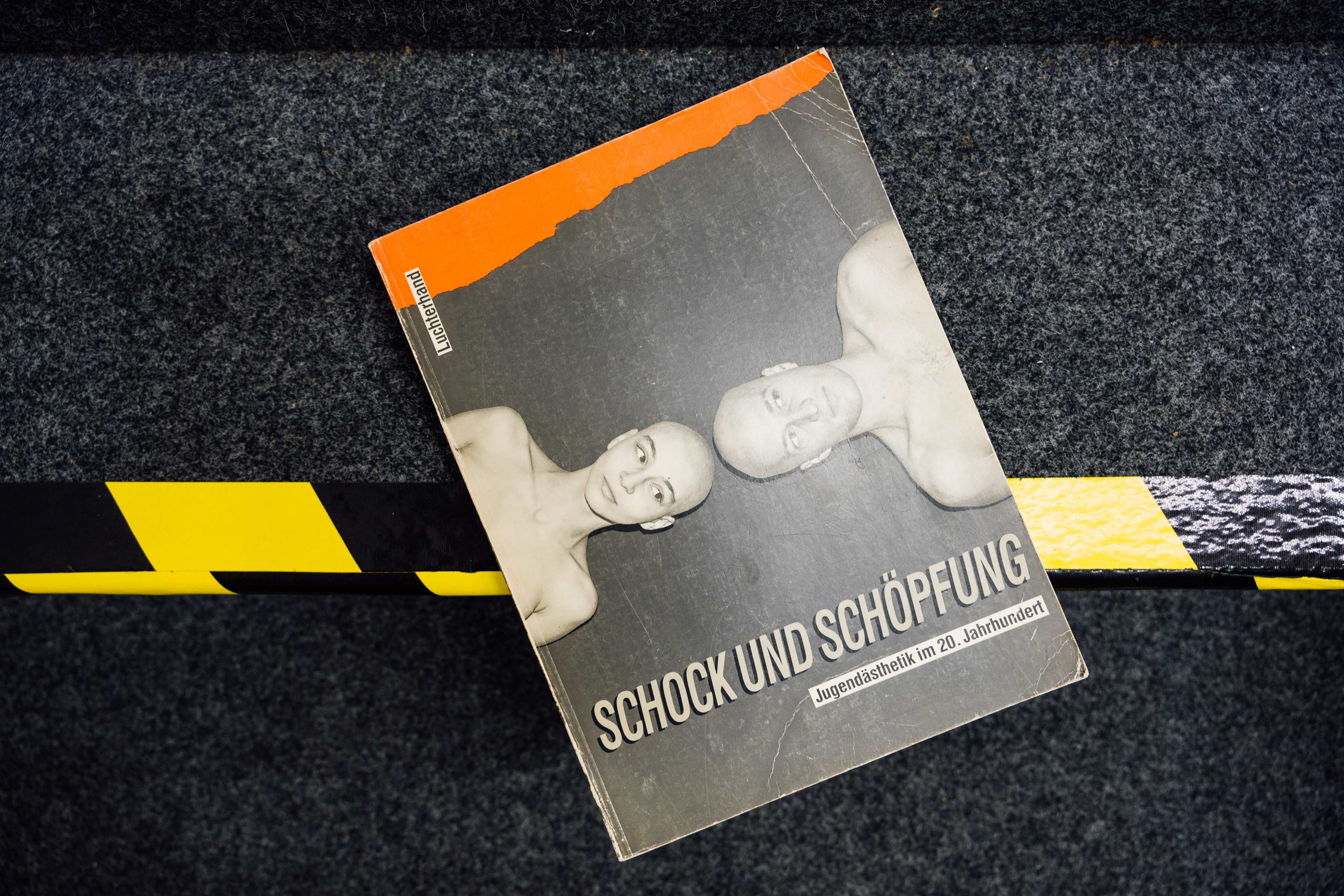
Willi Bucher & Klaus Pohl (Ed.): „Schock und Schöpfung. Jugendästhetik im 20. Jahrhundert“, edited on behalf of Deutscher Werkbund e.V. & Württembergischer Kunstverein Stuttgart, Darmstadt & Neuwied: Hermann Luchterhand Verlag 1986.
In this book accompanying the exhibition of the same name, youth is treated as a multi-layered complex of themes. It is impressive that such a differentiated view of youthfulness was already possible in (West) Germany in the mid-1980s. The extensive volume (436 pages) brings together many short texts and countless photos by various authors and photographers.
"Seeing is the starting point of this project" (p. 9), write the editors or exhibition organizers. They look at the phenomenon of youth from several sides and avoid evaluations. "The project wants [...] to try to leave the 'object' its original fascination. Aesthetics here means in the very original sense: showing and looking. It is not the history of youth (cultures) in general that is to be traced, but their aesthetic forms of expression, their meaning and the history of their use. Only in this respect are 'exotics' the focus. But in order not to get lost in the sensuality of these phenomena, it is necessary to include the 'normal handling' of things, the handling of the 'normal things' in the consideration. The 'normal youths' as well as the 'adult world' are needed as a contrast for a representation that assumes meaning to the aesthetic deviation and understands the subcultural phenomena as an aesthetic reflex, as a response to the necessities and specific problem constellations of their time." (p. 9)
The book accompanying the exhibition begins with the 1980s and works its way back from there decade by decade to the beginning of the 20th century. Of course, popular music plays an important role in this. Starting with punk and techno of the eighties, rock and pop music of the seventies, beat and schlager music of the sixties, rock'n'roll of the fifties and swing music of the twenties, thirties and forties. Even folk and workers' songs between 1900 and 1920 are thematized.
What the book shows very nicely is the close connection between music, fine arts and fashion, but also the overarching historical contextualization with its diverse political and social cross-references is by no means neglected. Or, as the blurb succinctly summarizes it: "... of wandering birds and punks, of wild cliques and flower children, of Bündische and anti-authoritarians, and much more".
Closed between Christmas & New Year

KKI will be closed from December 24, 2022 to January 1, 2023. We will open our doors again on January 2. We wish you all a merry Christmas and a relaxing New Year. See you/hear you in 2023!
New video series about the history of KKI
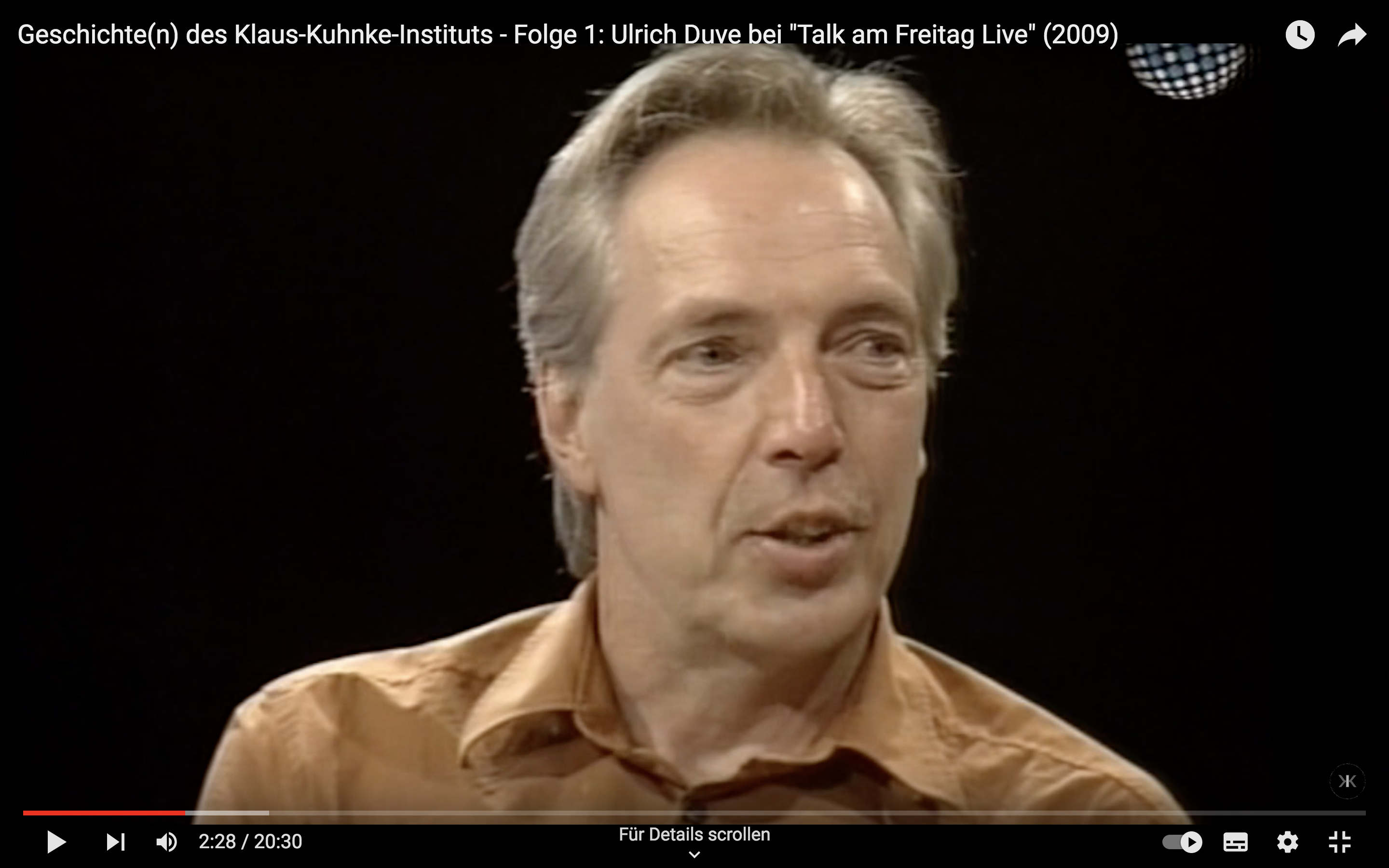
Ulrich Duve was head and managing director of the Klaus Kuhnke Archive for Popular Music from 1991 to 2021. On August 7, 2009, he was a guest on the Bremen regional TV show "Talk am Freitag Live". There he reported about the Klaus Kuhnke Archive and presented some exhibits.
https://youtu.be/bzo2W3opasA
Resumption of cooperation with Stattreisen e.V. Bremen
The Stattreisen e.V. Bremen offers alternative city tours for locals and tourists. Due to Corona, our cooperation was on hold for two years. Since December 2022 Stattreisen e.V. organizes a new tour through Bremen called "Hidden and Special Places". In addition to the Tischlerei Museum, the KKI will also be visited. We are looking forward to the revival of the cooperation as well as to many interested guests. The tours take place once a month on a Saturday morning (every third Saturday).
More info here: https://www.stattreisen-bremen.de/stadtfuehrungen/thema/auflistung/verborgene-und-besondere-orte/verborgene-orte.html
Santa Claus Music Exchange on December 6
in the foyer of the University of the Arts (Department of Music)

On Tuesday, December 6, the KKI will sell a selection of its archive doubles. In the period from 10 am to 4 pm you can go bargain hunting. A good opportunity to find Christmas gifts.
Find of the month from the KKI archive _ November 2022

"Jazz and Early Music" (lecture with music examples, vinyl record, Telefunken 1957)
In the age of the Internet, music-related explainer videos or podcasts are omnipresent. This was quite different in the 1950s. Back then, in addition to books and magazines, it was primarily radio broadcasts that provided music-related information. In a few cases, it was records on which music was explained.
One example is this 10-inch vinyl record titled "Jazz and Early Music," which includes a lecture with musical examples. It was recorded in 1957 in the auditorium of the School on Mittelweg in Hamburg (Germany) and released in the same year on the Telefunken label. The two lecturers are jazz journalist/publicist Joachim-Ernst Berendt and musicologist Dr. Joachim Tröller, an expert on early music. The music samples are by the Wolfgang Lauth Quartet, a jazz quartet around pianist Wolfgang Lauth, with Werner Pöhlert on semi-acoustic electric guitar, Peter Trunk on double bass and Joe Hackbarth on drums. An unnamed "student of the Mannheim University of Music" provides the improvised harpsichord passages.
The live recording offers "with its just under 40 minutes an excerpt from a two-hour event", at which also "light pictures" were shown, which of course are not to be seen on the record. With this event, the two presenters and the musicians toured German universities and schools at the time - with the intention of bringing both jazz and early music closer to the population. Of course, the commonalities of the two musical traditions were in the foreground: improvisation, bass motifs, spiritual-secular folk melodies, continuous rhythm, tonal coloration practices, etc.
However, the two speakers emphasize that the aim is not to justify or artistically valorize the respective other musical tradition by pointing out the parallels. Rather, music-historical and music-analytical facts are to be provided in order to promote a better understanding of jazz as well as early music.
The Wolfgang Lauth Quartet plays five pieces that today would be classified as so-called cool jazz, including two compositions by Wolfgang Lauth himself and one each by Fats Waller, Meade Lux Lewis and John Lewis. In addition to the short passages in which the harpsichord student demonstrates basso continuo playing practice, an audio sample is also presented that sounds a recording from the church service of an African-American congregation in Harlem, New York.
The entire lecture is delivered in the pathetic, overtoned speaking style typical of the 1950s and uses the N-word many times to contextualize the African-American parts of the jazz tradition. This may sound inappropriate to our ears, but it was in keeping with the spirit of the times and at no point reveals pejorative or racist ideas. On the contrary, it is precisely a matter of acknowledging the importance of the contribution of African-Americans to the development of jazz. In this respect, this contemporary document is worth listening to and is an early example of so-called intercultural music education.
Musicology Intern in November/December

Maren Speer, a musicology student from the University of Bremen, is completing a four-week internship at the KKI in November/December to accompany her studies. She is in the 7th semester of her Bachelor's degree and is assisting the KKI team with their work in the archive. We are grateful for her participation and are happy to give her an insight into our daily work. Student interns are always welcome.
The KKI takes autumn vacation from 14 to 20 November

We are taking a week off and will be back to our regular schedule on November 21. We wish you all relaxing days.
Participation & presentation on November 11/12 at the IASA Germany/Switzerland Country Group meeting on "Ethnographic Audio/audiovisual Collections and their Challenges"

The former director of the Klaus Kuhnke Archive (Ulrich Duve) and the new director of the Klaus Kuhnke Institute (Nico Thom) participated in the annual meeting of the Germany/Switzerland country group of the International Association of Sound and Audiovisual Archives (IASA) in Freiburg/im Breisgau. The hybrid event was hosted by the Center for Popular Culture and Music (ZPKM) at the University of Freiburg. Ulrich Duve took his leave from the position of IASA country group chair and was met with warm and grateful words. Nico Thom gave a lecture on the topic "From a (North-)Western perspective? The Quasi-ethnological Record Collections of the Klaus Kuhnke Institute for Popular Music in Bremen", in which he contrasted an ethnological perspective on (popular) music with a system-theoretical one.
International online conference on the topic:
"Toddlers/Children's Songs - The Popular Music of the Youngest?"
on November 4, 2022

On Friday, November 4, 2022, the KKI will host an online conference from 12 to 4 p.m. (Central European Time), which will deal with the still relatively unexplored complex of topics "Toddlers/Children's Songs". The question to what extent such songs are to be understood as popular music will be explored. The detailed Call for Papers can be found here: CfP_Toddlers_Children_s_Songs.pdf
The presentations and discussions will be available on the Internet via the Zoom platform.
Please send your registration for free participation to the following email address: kontakt@klaus-kuhnke-institut.de
The conference program:
First block (12:00-13:15)
12:00-12:10 _ Opening & Greetings
12:10-12:40 _ Nico Thom (Bremen/Germany):
"The varity of popular toddlers/children's songs - An overview with examples from the German-speaking area"
12:40-12:45 _ Changeover break
12:45-13:15 _ Shelley Brunt & Liz Giuffre (Melbourne & Sydney/Australia):
"Popular music and parenting"
13:15-13:30 _ 15 minutes break & online café
Second block (13:30-14:35)
13:30-14:00 _ Ariane Diniz Holzbach & Jackeline da Costa (Rio de Janeiro/Brazil):
"Mundo Bita feat. Brazilian Popular Music - Reflexions around musical quality in songs aimed at children"
14:00-14:05 _ Changeover break
14:05-14:35 _ Andrew Snyder (Lisbon/Portugal):
"Expat migration and baby music classes in an internationalizing Lisbon"
14:35-14:50 _ 15 minutes break & online café
Third block (14:50-16:00)
14:50-15:20 _ Ruth Barratt-Peacock (Jena/Germany):
"The 'child' in children’s popular music research - A social constructionist view on childhood in kiddy metal"
15:20-15:25 _ Changeover break
15:25-15:55 _ Tobias Marx (Erfurt/Germany):
"Music for children - Musical, pedagogical and social perspectives"
15:55-16:00 _ Farewell
Find of the month from the KKI archive _ October 2022
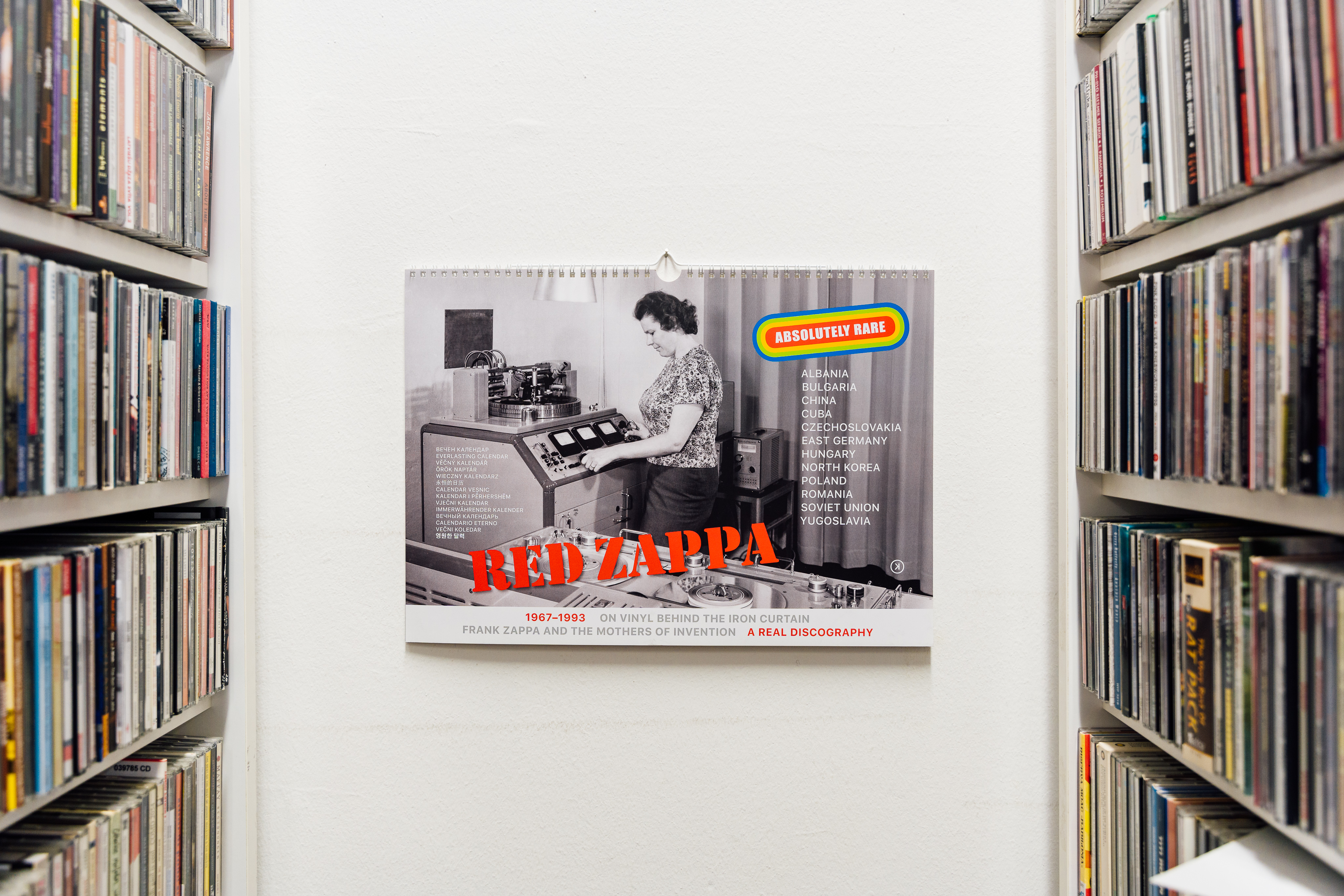
Frank Wonneberg: "Red Zappa. 1967-1993. On Vinyl Behind the Iron Curtain. Frank Zappa and the Mothers of Invention. A Real Discography"
(Limited Fake Art Calendar, self-published: 2019, Series Z, No. 43/100)
Frank Wonneberg has been moving between the arts of music, graphics and literature for decades. Coming from an East German family of musicians, he first learned the trade of typesetter, then studied musicology and cultural history and worked for many years as a graphic artist in the publishing world, where he helped design magazines, and in the music business for record labels, music promoters and rock bands, for whom he designed record covers and posters. In the meantime, he also ran a mail order business for vinyl records and published a magazine called "Living Vinyl". With his "Vinyl-Lexikon" he appeared for the first time as a book author in 2000. Further revised editions of his standard work on vinyl records followed, as well as the book "Grand Zappa" (2010) about the U.S. musician Frank Zappa (1940-1993).
In 2019, Wonneberg published a limited edition fake art calendar that also deals with Frank Zappa. In it, he depicts the covers of vinyl records that the legendary musician was supposedly able to release behind the "Iron Curtain". Wonneberg is spinning yarns about "unknown recordings from the former Eastern Bloc" or "rare licensed editions from communist record companies" that were packed in a mysterious cardboard box from the estate of Swiss collector Beat Rupp and stored in the archive of the Varèse and Zappa Society in Basel. Wonneberg had visited the archive in 2018 and discovered these records by chance.
The fictional story is executed in the calendar and peppered with all sorts of details that make it seem realistic. Nevertheless, it is an amusing game with the truth, which, however, insiders and Zappa connoisseurs can expose as fantasy or the collector's dream of the artist. With a neo-realistic approach, Wonneberg "facsimiles" "just under a dozen exceedingly rare [...] long-playing records as well as a single". In addition to the respective front cover, the A-side of the record is also shown. The captions include information about the year of release, the catalog number, the country of origin and the record company in the respective national language. In addition, there is the matrix number, the details of the original recording or lacquer re-cut, the manufacturer, the source of the sound recording, the media format, the vinyl quality, grammage and the predicate from the point of view of the collector. All invented of course!
Allegedly, the Zappa records depicted were released in Albania, Bulgaria, China, Cuba, Czechoslovakia, East Germany, Hungary, North Korea, Poland, Romania, the Soviet Union and Yugoslavia. Corresponding monopoly labels like Amiga, Supraphon or Balkanton would have brought the vinyls under the people with state permission. And indeed, the illusion works through Wonneberg's deceptively genuine recreations of the label designs and aesthetics. Only native speakers or experts recognize small errors in the country-specific spellings. Since Frank Zappa released more than twelve albums, Wonneberg had to make a selection that provides a cross-section of Zappa's work. In each case, the original is recognizable, even if it is presented in an alienated way. Here, successful craftsmanship, expertise and mischievous humor are paired. A pleasure - not only, but especially for Zappa fans.
The KKI was at the annual meeting of the Archivnetzwerk Pop in Leipzig

On October 26, the members of the Archivnetzwerk Pop met again after a two-year break from Corona. This time, the German Music Archive in Leipzig invited them. It is directed by Ruprecht Langer and is part of the German National Library. The KKI has been a member of the network, a Germany-wide association of archives that focus on popular music, for years. There are plans to intensify the cooperation.
https://www.archivnetzwerk-pop.de
Find of the month from the KKI archive _ September 2022
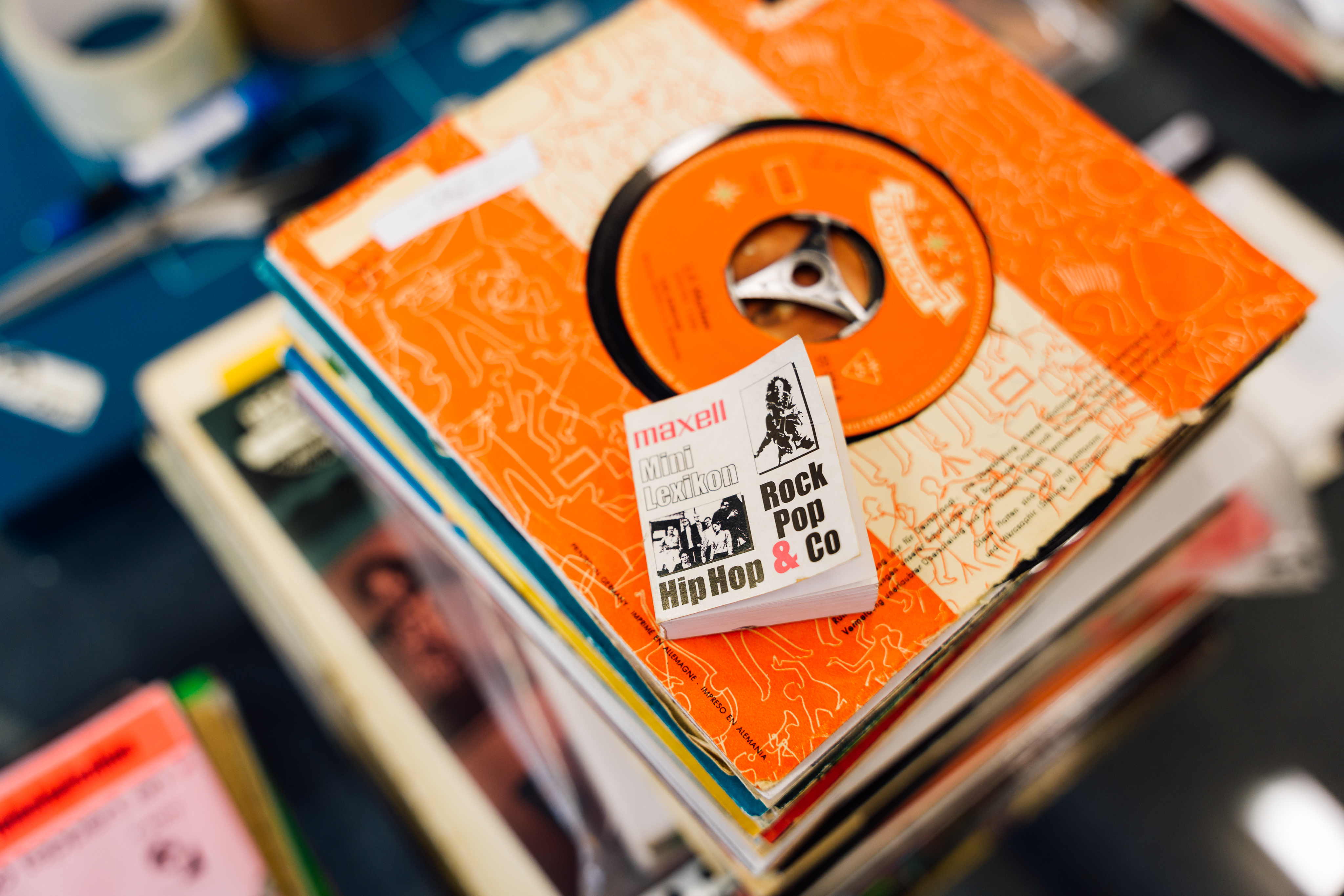
Stephan Heimbecher: "Maxell Mini-Lexikon Rock, Pop, Hip Hop & Co"
(Special edition for Maxell Germany GmbH in Meerbusch, Munich: Compact Verlag 1999)
Never judge a book by its cover. With this international proverb in mind, this time we will take a look at a small-format promotional or customer gift from the Maxell company. The company, which operates worldwide, has its headquarters in Japan and various branches abroad, including in Germany. Its product lines include batteries and storage media such as cassettes, tapes, floppy disks, video tapes, blank CDs and DVDs, as well as iPod accessories, remote controls, microphones, headphones, soundbars and beamers. Maxell is in turn a subsidiary of Hitachi, a global player and international technology conglomerate with roots in Japan.
Apparently, Maxell commissioned the German publishing house Compact Verlag before the turn of the millennium to produce an unusual gift for customers and business partners in German-speaking countries that is handy and provides facts about popular music in a condensed form. On no less than 255 pages, musicians and bands from ABBA to ZZ Top are listed and described with short entries. In between, there is concise information on musical terms, such as A Capella or Disco. Cross-references also assign individual artists to corresponding bands, e.g. Kurt Cobain to Nirvana or Steve Nicks to Fleetwood Mac.
Stylistically, the booklet delivers what it promises: It covers mainstream rock and pop from the 1960s to the 1990s and also features a few entries on hip-hop artists such as Grandmaster Flash and the Furious Five, Salt'n'Pepa, and Run D.M.C.. Particularly frequently represented are artists who dominated the charts in the 1990s. As usual in such encyclopedias, primarily US-American and British artists are presented. However, there are also entries on German musicians and formations, such as Nena, Udo Lindenberg or Die Fantastischen Vier.
Although you will come across many famous names when browsing through it, every now and then you can (re)discover some lesser-known singers or groups. Can you still remember Pat Benatar, for example? You can read about it: "Pat Benatar (Patricia Andrzejewski, * 10.1.52) started in 1975 as a cabaret performer before she switched to rock in 1978. From then on, the singer with the roughhened [sic!] voice delivered numerous hits with songs like Fire And Ice (1981), Shadows Of The Night (1982) and Love Is A Battlefield (1984)" (p. 25).
The cover of the miniature encyclopedia is a graphic disaster and not for people with impaired vision (you can only guess which band and which solo guitarist are pictured on it). In addition, the spelling of the book's title is grammatically incorrect. Also the text itself has some orthographic errors (compare the quote above) - and that although three editors are mentioned by name. A loveless appearance, then, behind which, however, is hidden an astonishingly information-dense reference book that is only two thumbs wide and high.
New video series entitled "Expert Opinion(s) - Understandings of Popular Music".
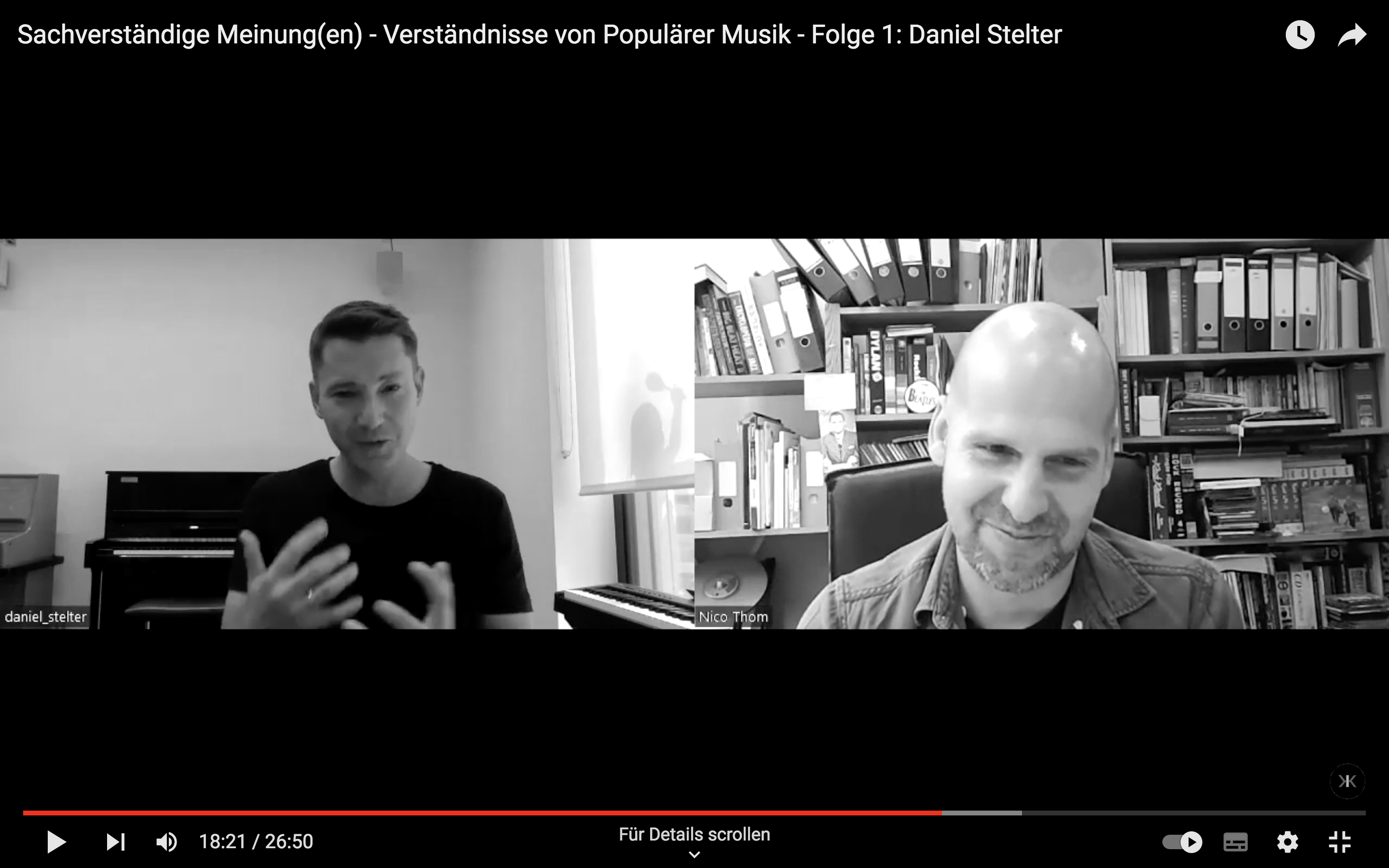
With a new video series, the KKI is shedding light on understandings of popular music and interviewing experts on the subject.
The first guest is guitarist and composer Daniel Stelter (born 1977 in Wiesbaden/Germany). For years he has been one of the most sought-after and versatile live, studio and TV musicians in Germany. He has played with many well-known artists from the fields of jazz, pop, world music and classical music, participated in several TV shows and released several albums under his own name.
You can find out everything else in the following interview:
https://youtu.be/7svisw2nwPI
Find of the month from the KKI archive _ August 2022
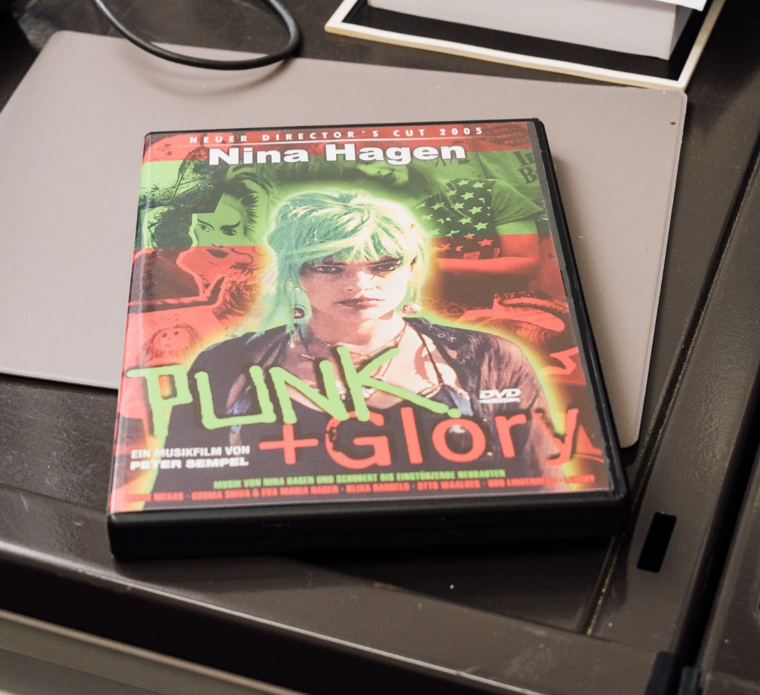
Peter Sempel: "Nina Hagen. Punk + Glory"
(DVD, CreArtive Film, Neuer Director’s Cut 2005)
Anyone expecting a conventional music documentary in the style of a biography of a female artist will be disappointed by this self-titled "music film". The GDR-born musician Nina Hagen, who today enjoys worldwide adoration, is instead presented in avant-garde moving images. Australian-German filmmaker Peter Sempel first released his experimental "portrait in collage form" (according to the sleeve text) in 1999, and then released a new director's cut in 2005, which is the subject of this post.
The film begins by highlighting the artist's versatility. Nina Hagen sings traditional Indian ragas, Italian opera arias and French chansons. In addition to her native German, she speaks to the camera in English over long stretches. The polyglot setting is reinforced by scenes in New York, Paris, Hamburg and Delhi, to name just a few locations. Over a period of 20 years, the filmmaker has accompanied the famous eccentric, who seems to be constantly in performance mode.
She constantly grimaces, plays with the diverse expressions of her impressive vocal range, walks aimlessly back and forth, utters esoteric aphorisms like "I'm jewish-indian-buddha-voodoo" and moves lasciviously in figure-hugging outfits. The fact that she can be seen in the course of the film with black, green, blond, red, and pink hair and wigs, and that she always appears heavily made up and adorned with jewelry, underscores her permanent need for role changes and grand theatrical gestures.
Although she is observed often and for a long time in close-ups, and she seems reasonably free and unconstrained, one still has the impression of not being able to look behind her facade, that is, to actually learn little about her. It seems as if she is trapped in her neurotic image, as if she has to serve it at all costs in order to remain interesting, intangible, enraptured. Even in supposedly intimate scenes in which she gives herself away vulnerably, such as when she sits on the floor and breathes Schubert's Ave Maria unaccompanied and in a trembling voice into the darkness, her unconditional will to stage is palpable. When asked by the filmmaker what her favorite opera is, she answers laconically: "the opera of my life".
Although Nina Hagen is known for her operatic singing, she has nevertheless acquired the nimbus of the "Godmother of Punk". The title of the film seems to allude to this global fame ("Punk + Glory"). A number of stars from the international music and film world have their say in praising her. In addition to Udo Lindenberg and Otto Waalkes, for example, Wim Wenders, Anthony Kiedis (singer of the Red Hot Chili Peppers) or Lemmy Kilmister (frontman of Motörhead) are full of praise for the non-conformist woman, who appreciates her for her uncompromising art and her socio-political commitment.
It is striking, however, that they all mention her attractiveness. Does this possibly reveal a male view of the "feminist revolutionary" (Udo Lindenberg), not least because a man made the film? Perhaps in parts. But what remains superficial is the respect for her stage presence, her wit and her playful way of dealing with gender roles. In this respect, it is not surprising that there are also some enthusiastic comments from the transsexual community.
The film does without a genuine narrative, a red thread. It is left to the viewer to form an opinion. For example, there are some scenes in which Nina Hagen can be seen in her private home with her children Cosma Shiva and Otis. It is sometimes irritating how she poses in front of the camera while her children have to wait bored in the background. The film's aesthetic, however, is focused on brief personal impressions, enriched with landscape and street scenes, images of animals and people passing by. It's about the in-between, about transitions and the ambiguous. If one wants to make it easy, one could claim that it is just an art film. In any case, it ends with the meaningful statement of its protagonist: "I use it all as a game".
Nevertheless, one learns something about Nina Hagen that a conventional documentary would probably not have brought out in this form. Namely, how broad the spectrum of her artistic work really is; that Nina Hagen is far more than a pioneer of the punk movement. Subtle allusions to singing actresses such as Zarah Leander, Marlene Dietrich and her own mother Eva-Maria Hagen are juxtaposed with musical style references to funk, disco, rap and opera as well as to the entire history of rock. The film's minimalist soundtrack forms the sonic tapestry for many extravagant examples from Nina Hagen's musical œuvre, which are complemented by no less special musical recordings by bands such as Einstürzende Neubauten, Yello or Tulip, die singende Tulpe.
KKI takes summer vacation from August 8 to 21

We allow ourselves two weeks of closure. From August 22nd we will be available again regularly. We wish you all relaxing summer days with lots of good music!
Find of the month from the KKI archive _ July 2022
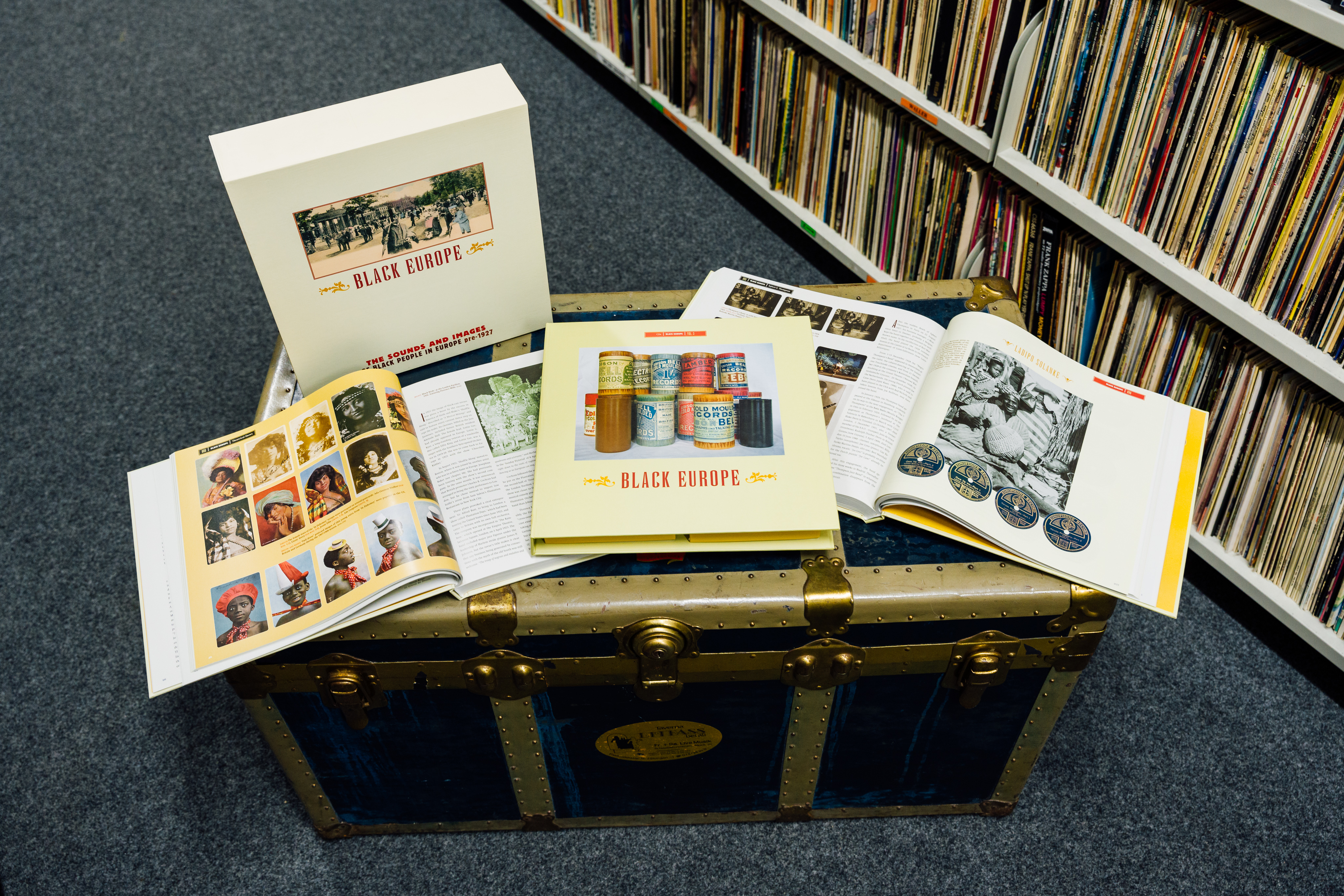
"Black Europe. The Sounds and Images of Black People in Europe pre-1927",
Compilation Box, Deluxe Edition with 2 hardcover books and 45 CDs, edited by Jeffrey Green, Rainer E. Lotz & Howard Rye, with the assistance of various authors, limited edition: No. 251 of 500, Holste: Bear Family Records 2013.
Some publications cause us to shake our heads in admiration. You look at them in amazement and wonder who came up with the insane idea for such a mammoth project and then had the guts to put it into practice. Especially for whom? Who would buy such a special-interest object weighing 7 kilograms for a hefty retail price of 2,000 euros?
Respect is due first and foremost to Rainer E. Lotz, the well-known German music collector and private researcher, who, together with a number of colleagues, has compiled and evaluated a deluxe box with no less than 600 book pages (2 x 300), 1244 tracks on 45 CDs (total playing time almost 57 hours) and 2000 color illustrations (photographs, posters and film scenes). The Bremen-based record label Bear Family Records has borne the economic risk and brought out the extremely elaborately designed collectors box - and with a limited number of only 500 copies!
The target audience for this collection, compiled with ethnological subtlety, has certainly been large libraries, archives, and museums. Since all texts have been written in English, "Black Europe" is aimed at an international specialist audience from the outset.
In addition to the density of the material, the special feature of this magnificently curated box is the historical restriction to the period before 1927. The justified question of why precisely this temporal restriction is quickly answered: around 1927 the all-electric microphone was invented, with which from then on most sound recordings were made.
In terms of content, this pioneering project deals with black women and men, i.e. people with African roots, whose influence on the development of modern mass media (especially in Europe) has long been overlooked. Yet this marginalized group was instrumental in the emergence of the recording and film industries from the beginning, and was marketed on phonograph cylinders, gramophone records, and in the first films (as well as in the fledgling print media) - mostly with an exoticizing and/or eroticizing impulse. "Black Europe" uses more than 100 individual biographies to show how people of African descent shaped the beginnings of European entertainment at the turn of the century and the racist stereotypes they had to suffer.
More information about the box can be found at this link: http://black-europe.com
Bremen declares itself to be "fresh of sound" and a "city of music"
- at least in the year 2022

Are the famous Town Musicians - here in the form of a small cardboard display - also ambassadors of popular music? The dog's "Hendrix-like" bass guitar and the cat's microphone, as well as her "hip-hop-esque" Bremen necklace, certainly raise hopes. Even the donkey's leg irons seem pretty folky.
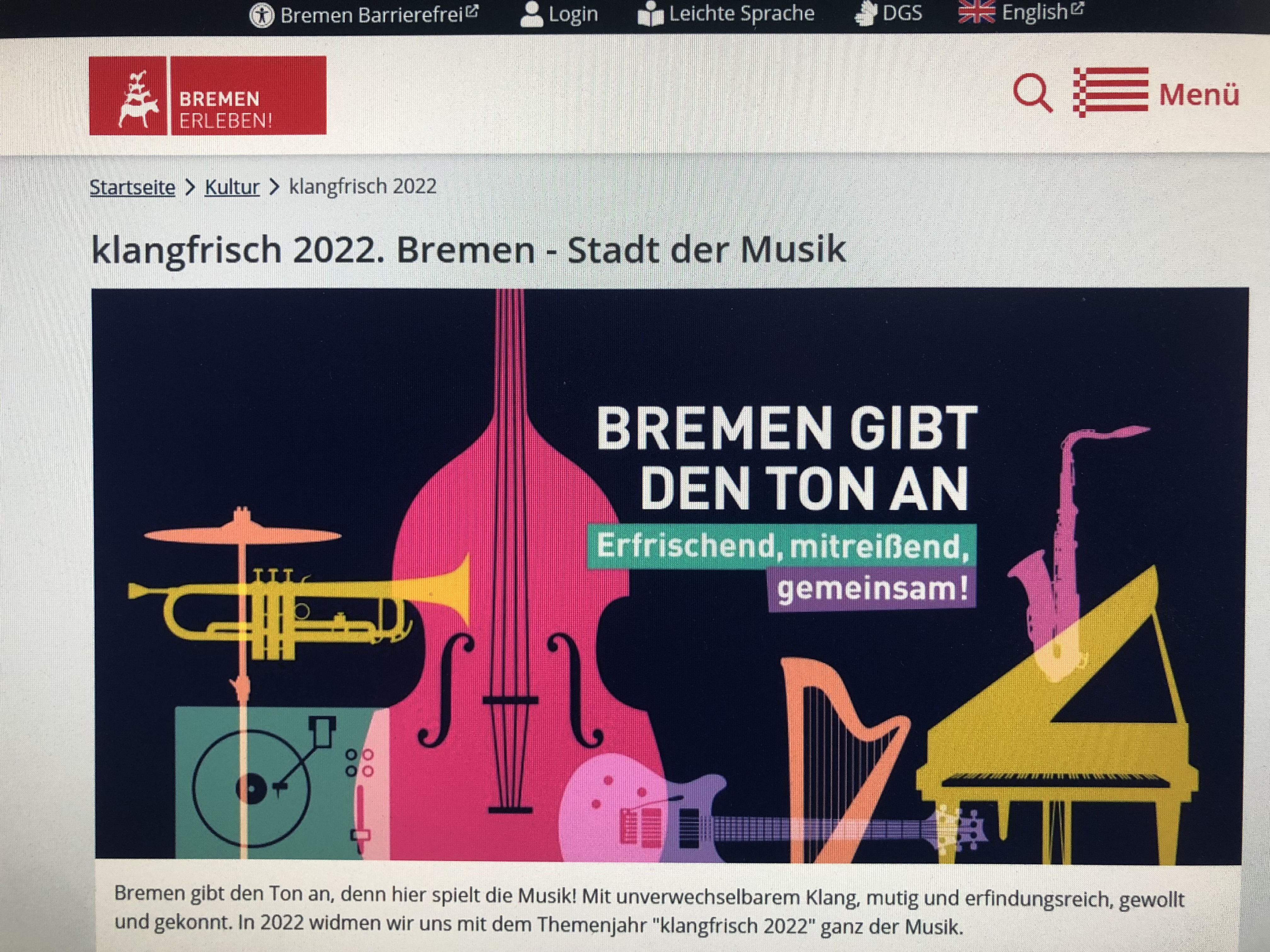
On the corresponding klangfrisch-2022-website, a record player and an electric guitar are integrated as genuine symbols of popular music. Perhaps with the exception of the harp, all the instruments depicted are ubiquitous in the jazz context (= popular music?) anyway.
For the year 2022, the city of Bremen (in cooperation with Bremerhaven) has a lot planned. With many subsidized events and aggressive marketing, the city's (and the region's) musical activities will be promoted and put in the shop window, so to speak, to raise public awareness. Popular music plays an astonishingly large role in this, which of course pleases us. Even in the visual presentation, popular music is given space, on an equal footing with the city's classical music tradition. This is by no means a matter of course... just think, for example, of the "Musikfest Bremen", which is de facto a classical music festival. But as we said: There is reason to hope that in the future the decision-makers and sponsors will cultivate a more open understanding of music worthy of support. Whereby subtitles like the following continue to reveal old thought patterns: "Bremen is inspiring - from high culture to subculture". From our point of view, what is high and what is low culture has to be negotiated again and again... it is best to first choose other terminologies for this.
More information here: https://www.bremen.de/kultur/klangfrisch-2022#/
New video series under the title "Exquisite music narrative(s) - Literature & Popular Music"
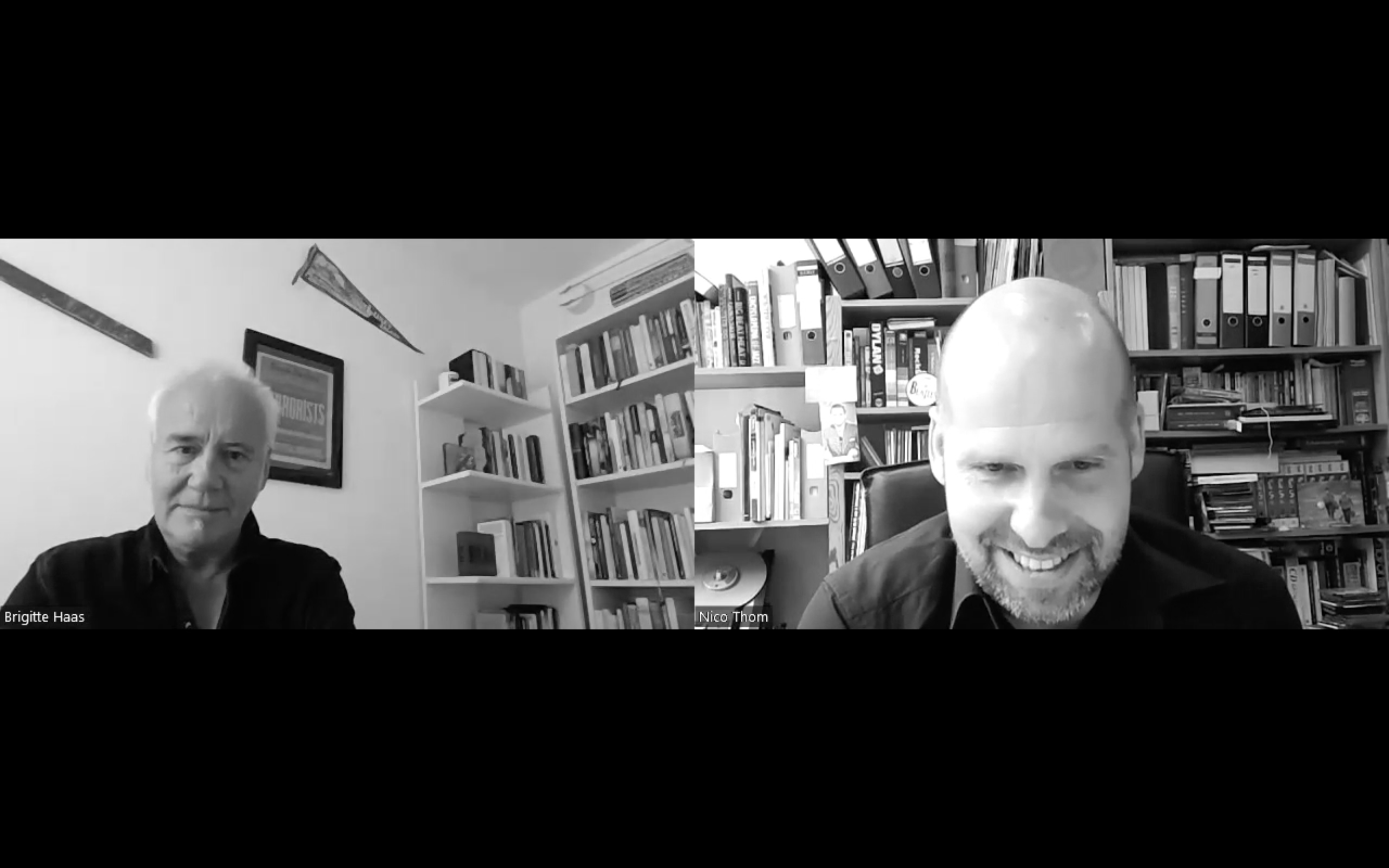
The KKI dedicates a new video series to the relationship between literature and popular music.
The event kicks off with an (online) conversation with the internationally renowned writer Hansjörg Schertenleib (born 1957 in Zurich/Switzerland). He regularly refers to popular music in his literary texts. Sometimes he even places it at the center of his books, for example by writing about musicians and their lives.
You can find out everything else in the following interview:
https://youtu.be/0YKHzcn8Ih8
Find of the month from the KKI archive _ June 2022
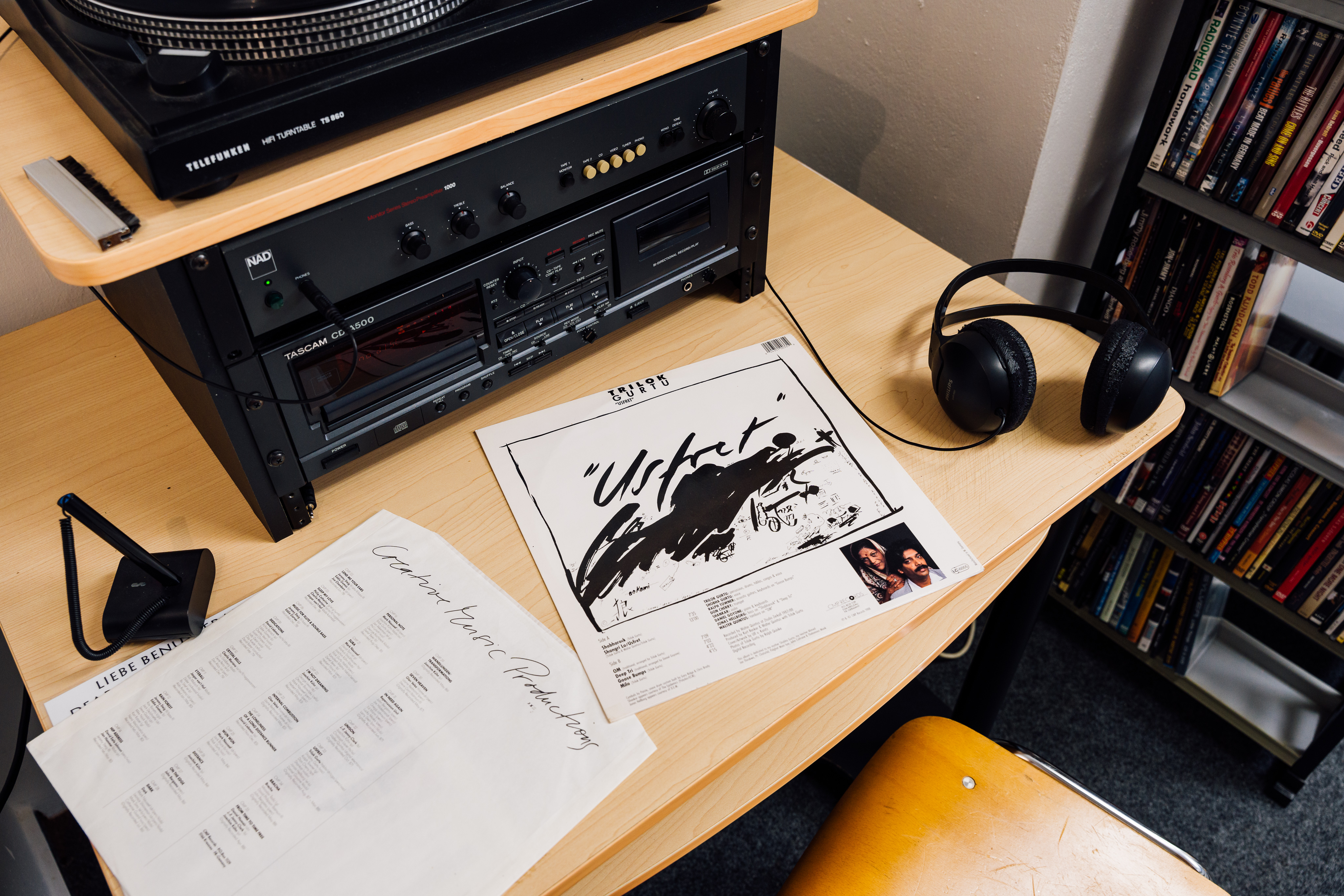
Trilok Gurtu: "Usfret" (vinyl record, CMP Records: 1988)
The Indian-born percussionist, drummer and singer Trilok Gurtu has lived in Hamburg for many years. His musical life, however, has taken him around the globe. Countless collaborations with artists such as Angelique Kidjo, Salif Keita, Neneh Cherry, John McLaughlin, Joe Zawinul, Pat Metheny, Dave Holland and Jan Garbarek are proof of his stylistic openness.
In 1988 he released his debut record "Usfret" on the German label Creative Music Productions (CMP) Records. Here he defined his version of so-called world music for the first time. In addition to his mother Shobha Gurtu, a well-known singer of the classical Indian music tradition, big names from the jazz context who have also dealt with regional varieties of world music: e.g. the trumpeter Don Cherry, the guitarist Ralph Towner or the bassist Jonas Hellborg.
Bremen-based producer Walter Quintus had a strong influence on the record, helping to shape the recordings musically. The striking record cover and artwork was the work of Hamburg graphic designer Ulf von Kanitz, who became the CMP label's in-house graphic designer. Many (international) jazz stars such as Joachim Kühn, Christof Lauer, Dave Liebman, Richie Beirach and Cream bassist Jack Bruce have released with CMP.
The KKI puts on at the "Live Cooking" in the context of the "Open Space Domshof"
(end of June to mid-September, every 14 days, Wednesdays, 6 pm)

At the Live Cooking on the Open Space stage, you can not only look into the pots of excellent chefs and pick up tips, but also taste them right away.
Archive specialities from the Klaus Kuhnke Institute will be served. Its director (Nico Thom) presents thematically bundled rarities from recent music history. The Live Cooking takes place from the end of June to mid-September on Bremen's Domshof, more precisely on every second Wednesday of the month.
The KKI can be experienced there on the following six dates:
29 June, 6 pm - Topic: "Food in Popular Music"
13 July, 6 pm - Topic: "Beat-Club & Musikladen - Two innovative music TV programmes from Radio Bremen"
27 July, 6 pm - Topic: "Visual Arts in the Context of Popular Music"
10 August, 6 pm - Topic: "Soul: Whether black or white soul music - at least with funky grooves!"
24 August, 6 pm - Topic: "Plus que de la chanson - Popular French Music in History and the Present"
14 September, 6 pm - Topic: "Tropical Beats? - World Music, Music of the World and Global Pop on International Tropical Forest Day"
More information: https://osd4.de/?p=88792
We were guests on westendRADIO with Windy Jacob
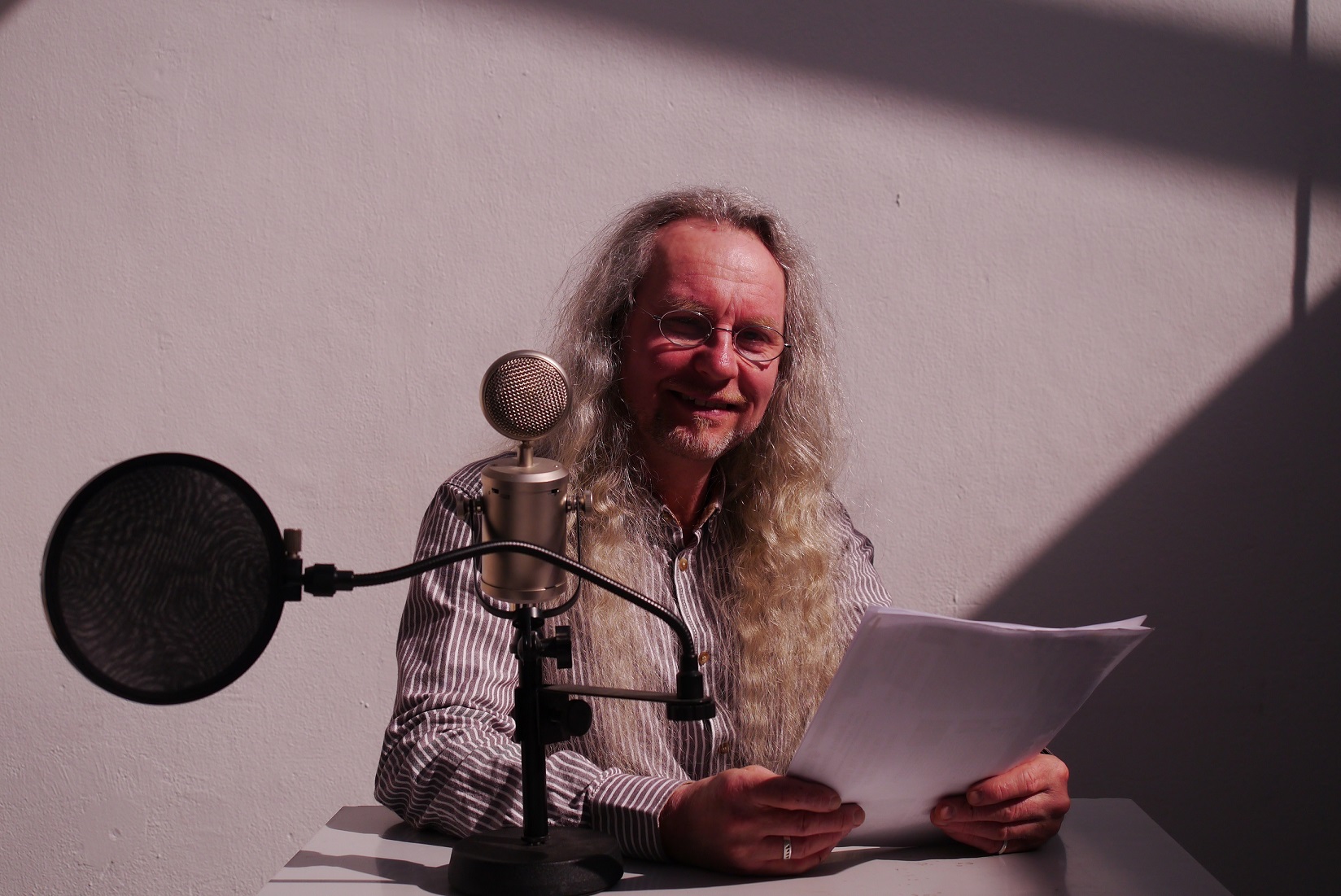
Windy Jacob has been hosting his own shows for Bremen's Citizens' Radio for many years
On June 16, Nico Thom, head of the KKI, was a studio guest on "westendRADIO - Live from the Kulturwerkstatt westend!" in the Bremen-Walle district. The live broadcast, which is aired every 14 days on Thursdays from 8 to 9 p.m., is moderated by Windy Jacob. He works for the Kulturwerkstatt westend and has been creating broadcasts for the Bremen citizens' radio station "Radio Weser.TV" for many years. For an hour, we chatted in a relaxed atmosphere about the Klaus Kuhnke Institute, its history and present, and plans for the future. Nico Thom was allowed to choose the music contributions, all of which he contributed from the KKI archive.
You can listen to the broadcast via this link: westendRADIO_16.06.2022.mp3
Closed on Whit Monday... Lucky!

Blasphemy? Of course not! Our motto: "A little fun is a must". Which brings us directly to one of the biggest German-language hits: the song of the same name by Roberto Blanco. Everybody knows the piece. The original from 1972 has been covered many times, sometimes even with Roberto Blanco as a guest star. The original video clip of the artist, in which he is shown swimming and bare-chested in the shower, already caused a lot of joy. An early "masterpiece" of the German-language music video tradition, long before MTV, VIVA & Co.
(First) Find of the month from the KKI archive _ May 2022

SCHALL. Musikmagazin, No. 17, 3 [summer] / 2019 (magazine from Berlin with 226 pages)
Music-related magazines have always been exciting media formats. Inevitably, they filter the vast number of bands and solo artists, introduce individuals, review their releases and concerts, create visual equivalents, and literally write (preliminary) music history(s). Such magazines always have to master the balancing act between art and commerce, because they are dependent on samples from music companies (primarily major labels) or advertisers, whose products they want to review as neutrally as possible and at the same time show their own artistic style or a specific aesthetic attitude. Hardly feasible, actually.
Since the market for popular music has become so incredibly large and no one can keep track of it, a segmentation has been observed for decades. In the past, music periodicals such as Rolling Stone, New Musical Express or Sounds covered a broad musical spectrum. Nowadays, things are generally different. They are mostly limited to specific musical styles or genres.
A rare exception is the magazine "SCHALL." produced in Berlin, because it appears with the impetus to represent as many areas of popular music as possible. It is no coincidence that the magazine refers to the value-free concept of sound, which describes with physical objectivity the wave-like spreading vibrations that can be perceived by the human ear. The magazine also demonstrates the courage to be non-conformist in terms of its size and the text-image ratio: a lot of text on 226 pages is truly unusual these days. Basically, one could even speak of a book or a book series, were it not for the self-titling as a music magazine.
The driving force behind it is music journalist Christian Hentschel and a team of music editors - all male, by the way. Nonetheless, women are coming into their own, whether as contributors, graphic designers, or featured musicians. So it's not a men's magazine that's primarily about masculine rock attitude - although that can also be found, for example, in articles about the bands Helloween or Michael Schenker's Fest.
Besides this gender fact, it is noticeable that a lot of German-language music is negotiated (e.g. Ulla Meinecke or Die Liga der gewöhnlichen Gentlemen). Austrian (e.g. Rainhard Fendrich or the duo Seiler und Speer) and Swiss acts (e.g. Selbstbedienung) are also highlighted. Even well-known GDR formations like the Puhdys or Stern-Combo Meisen find appreciation - and that in 2019!
Stylistically, the focus is on current rock and pop music - the seven-page cover story is devoted to the German stoner/psychedelic rock band Kadavar - but electronic dance music, punk, metal, soul, blues, jazz and even new music are also discussed. Such diversity is invigorating and allows readers to think outside the box.
The magazine was founded in 2015. In the meantime (as of June 2022), it has reached issue 26 and it is to be hoped that "SCHALL." can continue to exist for many more years in the highly competitive print media market. The website of the quarterly music magazine can be found here: https://www.schallmagazin.de
Ascension Day or Father's Day and Bridge Day
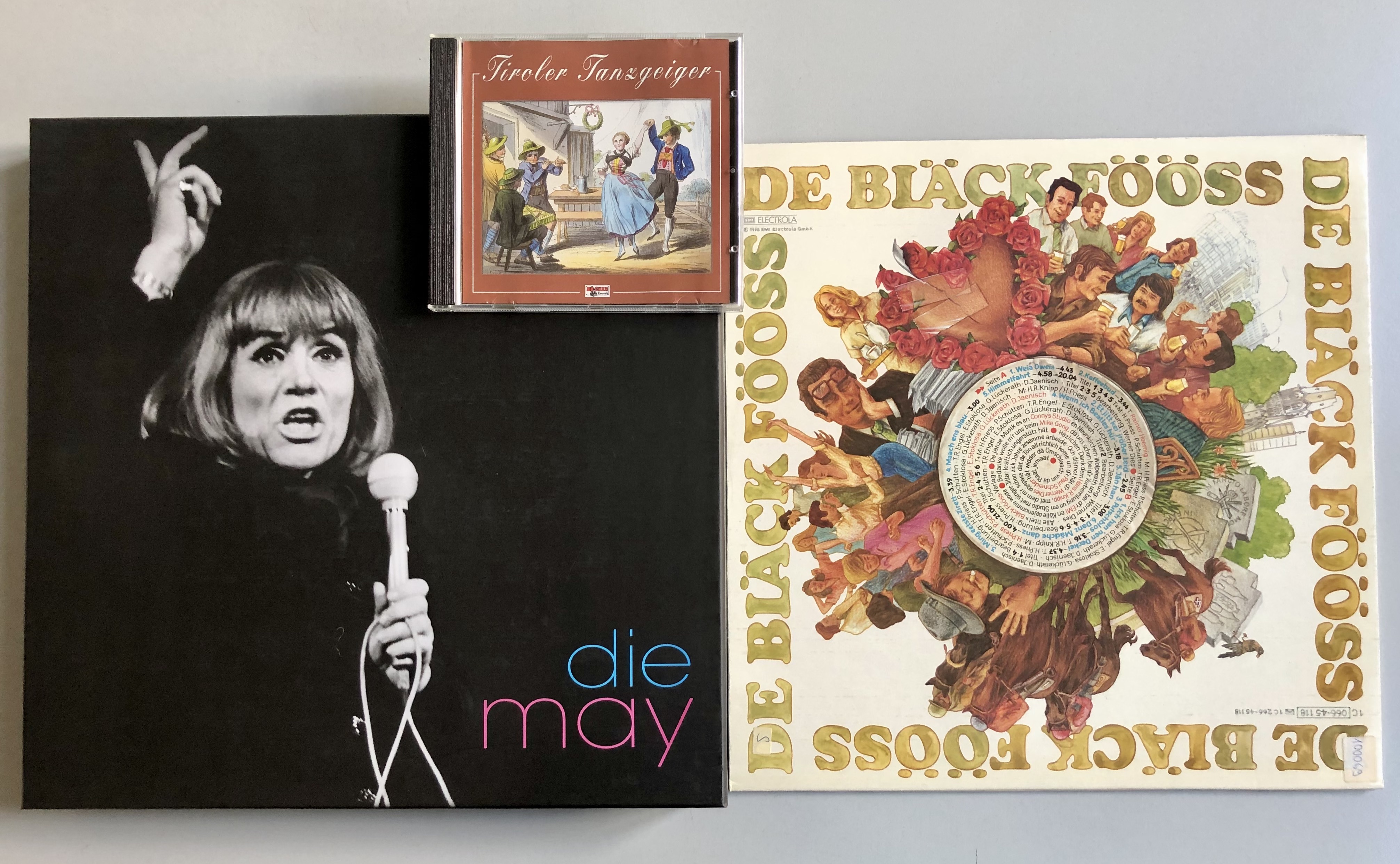
On Thursday, May 26, we are closed for the (public) holiday. What for some is a heavenly holiday, so to speak, is for others an occasion to celebrate the earthly fathers. Since the employees of KKI are fathers and have fathers, we also celebrate the "lords of creation" - moderately, of course. A quick look through our archive database unearths some Ascension Day gems. Here is a small selection:
1) On the one hand there is "Die Himmelfahrt der Galgentoni" - a sad-comic story about a whore who pays her last respects to a man sentenced to the gallows, touchingly performed by the diseuse Gisela May. The piece can be found in the detailed book-/CD-/DVD-box "die may", which was published in 2006 by Bear Family Records in cooperation with the Günter Neumann - Foundation and the Berlin Academy of Arts.
2) On a self-titled CD of the Tiroler Tanzgeiger the "Himmelfahrts Polka" (sic!) is immortalized. The short instrumental piece presents finest folk or dance music from the Zillertal in the instrumentation for first and second violin, harp, diatonic harmonica, double bass and diatonic (East Tyrolean) dulcimer. The CD was released in 1995 by Bogner Records in Austria.
3) The Cologne band (De) Bläck Fööss also dedicates the song "Himmelfahrt" to the holiday of the same name. In it, they celebrate the fact that you don't have to work and can comfortably "make blue" in the Westerwald. The meaningful title of the vinyl album from 1978 is "Mer han 'nen Deckel" (EMI/Electrola).
By the way, we are also closed on Friday, May 27 - and take a bridge day off. Various song titles would also lend themselves to this... "Über sieben Brücken musst Du gehn" (Karat/Peter Maffay)... "Bridge over Troubled Water" (Simon & Garfunkel)... also to be found in our archives.
A showcase... thanks to the State Archives!
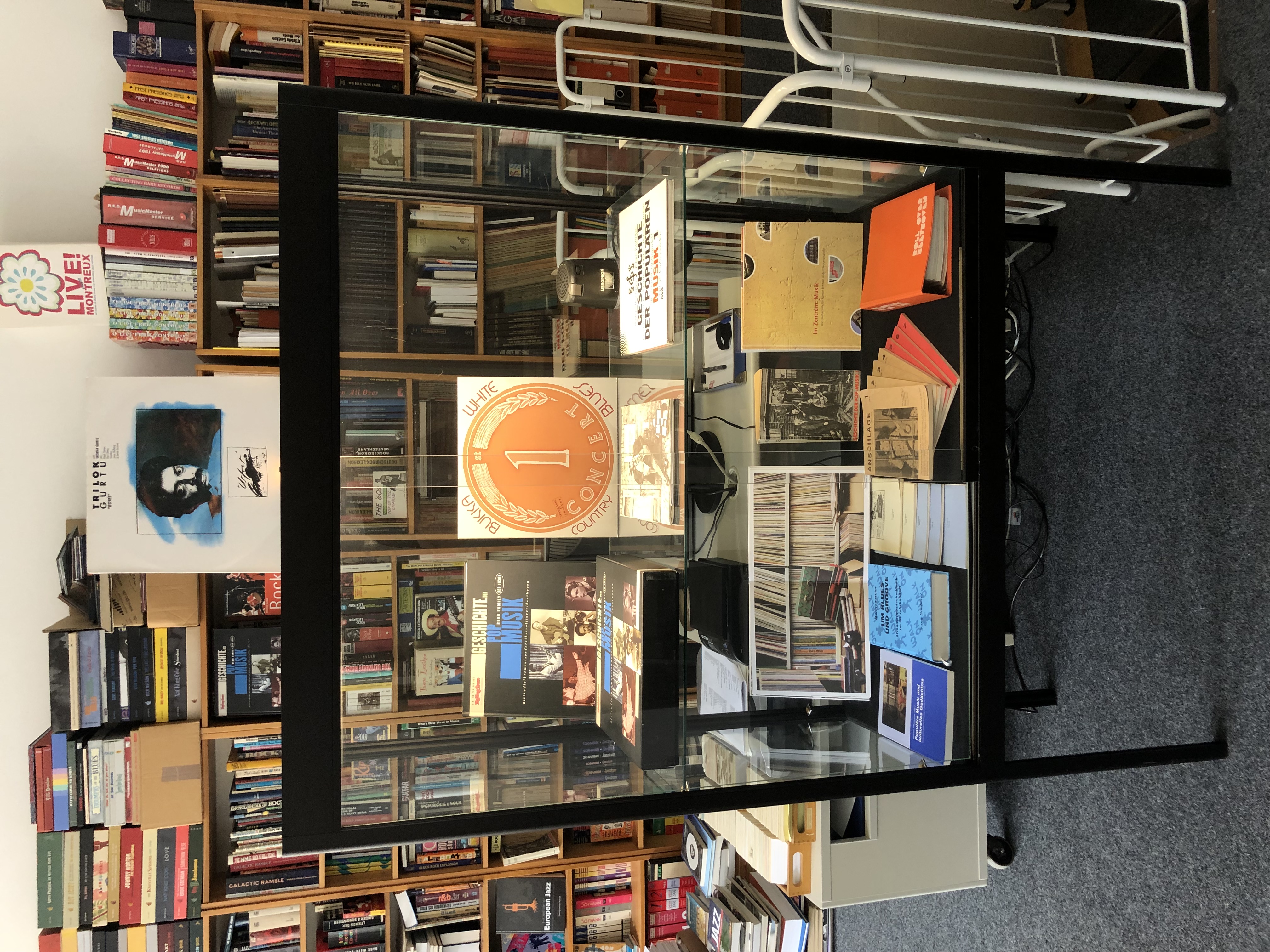
From now on, our interior will be adorned by a display case. We owe it to the Bremen State Archive, which has bequeathed us the massive and illuminated glass case. An enchanting piece, we think! It offers us the possibility to welcome our guests with changing exhibits, e.g. the "find of the month".
"Alles neu macht der Mai (Everything is new in May)"
(at least some things)
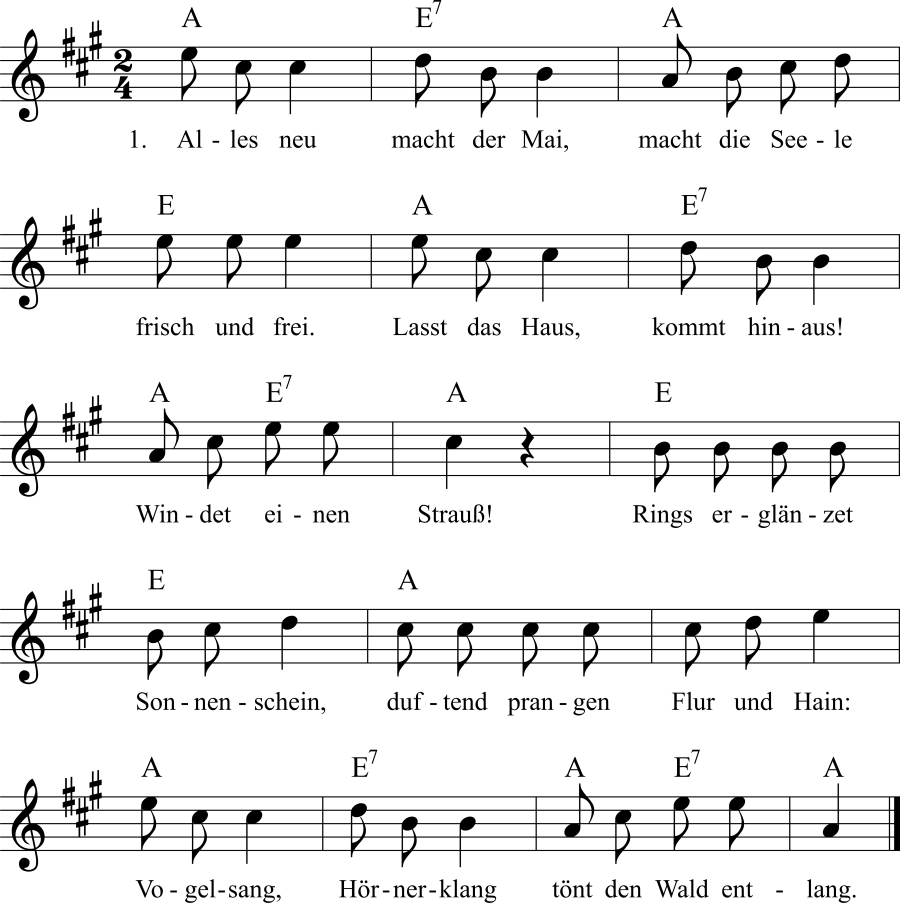
A traditional spring or children's song - with the same melody as "Hänschen klein" by the way - provides us with the appropriate headline: "Alles neu macht der Mai (Everything is new in May)". (Well, not everything, of course, but some things.) At least that could be the motto for us, because today, Friday, May 13 (if that is not a bad omen ;-) we change our name. Until now we were the "Klaus Kuhnke Archive for Popular Music", from today on we are the "Klaus Kuhnke Institute for Popular Music". Our subtitle is "Archive and Research Center at the University of the Arts Bremen". Strictly speaking, we have been an institute at the HfK Bremen since 1992, i.e. for 30 years, only few people knew that. Hence the renaming. And also to make it clear that from now on we want to be more active with our own research projects. With a new name comes a completely new website, namely this one. Have fun browsing!
5,000 CD duplicates go to the Freiburg ZPKM
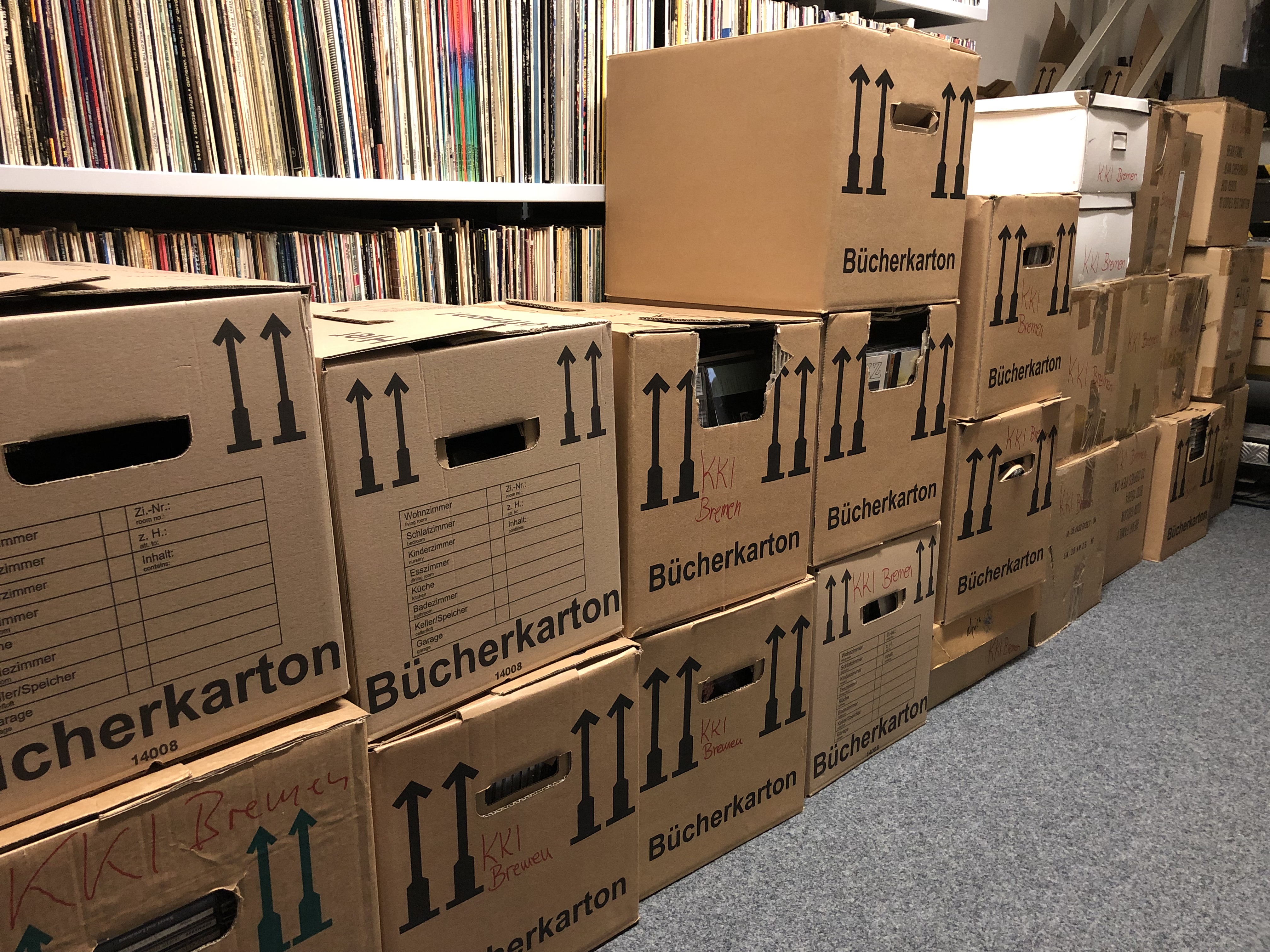
On May 6, 38 boxes containing approximately 5,000 CD duplicates from our archive holdings were shipped to the Center for Popular Culture and Music (ZPKM) at the University of Freiburg. The colleagues in Freiburg are happy about the increase in their holdings and we are happy about the freed up space in our archive (and the financial compensation). A classic win-win situation.
FaMI intern in May

In May, Ann-Katrin Verzagt joins the KKI team and completes a three-week internship. She is currently training to become a specialist for media and information services (FaMI) at the Bremen State and University Library and is in her second year of training. We are grateful for her participation and are happy to give her an insight into our daily work. FaMI trainees regularly honor us and are always welcome.
We were (of course) at the Bremen jazzahead!
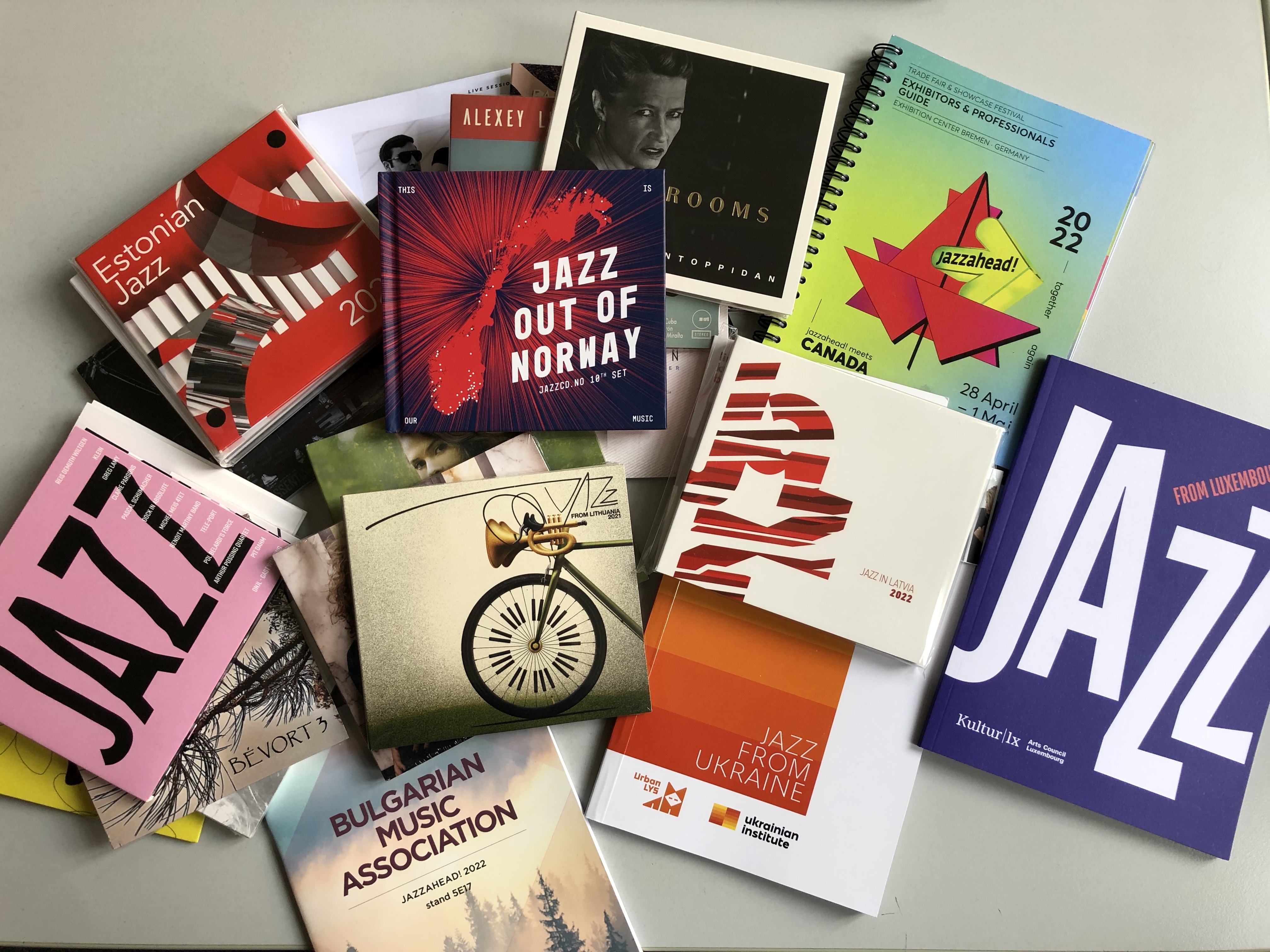
A selection of the "captured" recordings and info-materials on contemporary jazz
As every year since the founding of the Bremen trade fair jazzahead! in 2006, we were again present in 2022. The trade fair with integrated festival, which always takes place at the end of April, has become the largest international industry gathering, bringing together jazz experts (musicians, bands, labels, agencies, country representatives, associations, journalists and academics) from all over the world. In addition to networking with the peer group and discovering new jazz music, collecting records and info materials is a pleasant side effect for the KKI archive. Current jazz from Ukraine, Luxembourg or Bulgaria? We now have the relevant artifacts - which we are very happy about. Oh yes: It should be mentioned, of course, that the spiritus rector of the KKI, Peter Schulze, is the artistic director of jazzahead! and thus we feel connected to this important event in more ways than one. More information about jazzahead! can be found here: https://jazzahead.de
Large punk/hardcore/independent collection taken over
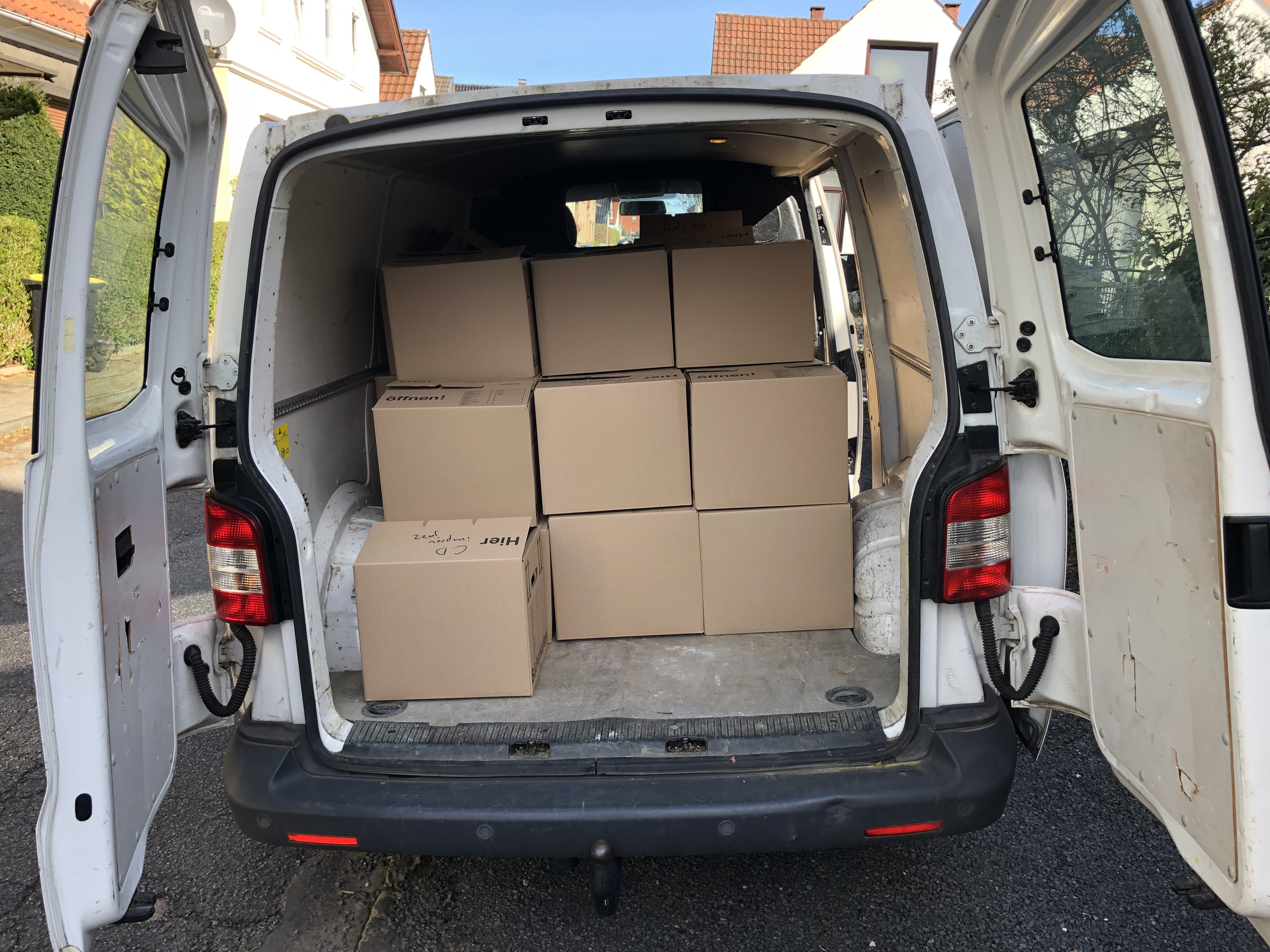
Parts of the collection of Tobias Stalling
In April, we received the impressive collection of the Bremen media educator Tobias Stalling and transferred it to our holdings. It contains about 5,000 CDs, DVDs and VHS tapes as well as several hundred fanzines, magazines and books. The collection mainly covers the period from 1990 to 2020 and documents the local, national and international punk tradition in great detail. In addition, there is also a lot of sound, image and video material on various styles of popular music, e.g. jazz, hip hop, EDM as well as classic and progressive rock. For example, the complete oeuvre of the British band King Crimson is part of the collection. It is a valuable addition to our archive.
Very large country music collection left to us
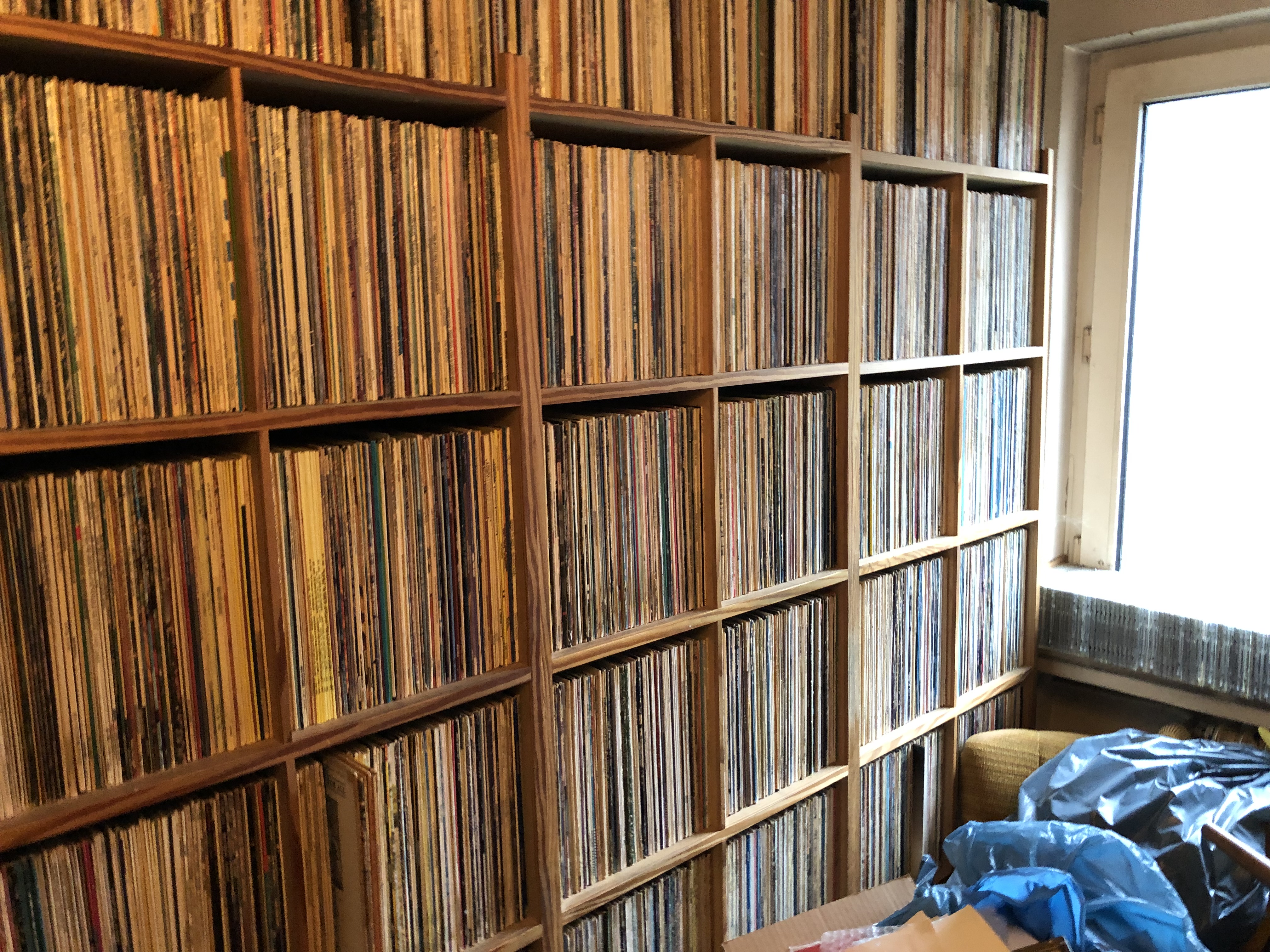
Parts of the collection of Mohns Mohnssen
In the course of his life, Mohns Mohnssen from Bremen has amassed an enormous amount of recordings (as well as magazines and books) on the subject of country music. In professional circles, his collection is considered one of the largest of its kind in Europe. In 2020 Mohns Mohnssen passed away due to old age. In his will, he had stipulated that his estate should be passed on to the Klaus Kuhnke Archive. In January/February 2022 the collection of the materials took place. Essentially, it is about 8,000 vinyl records and about 3,000 CDs, mainly with U.S. country music in all its varieties. European variants were also collected by Mohns Mohnssen, as well as associated contextual descriptions, for example a trade journal called "Bluegrass Europe Magazine".
New head of the Klaus Kuhnke Archive/Institute
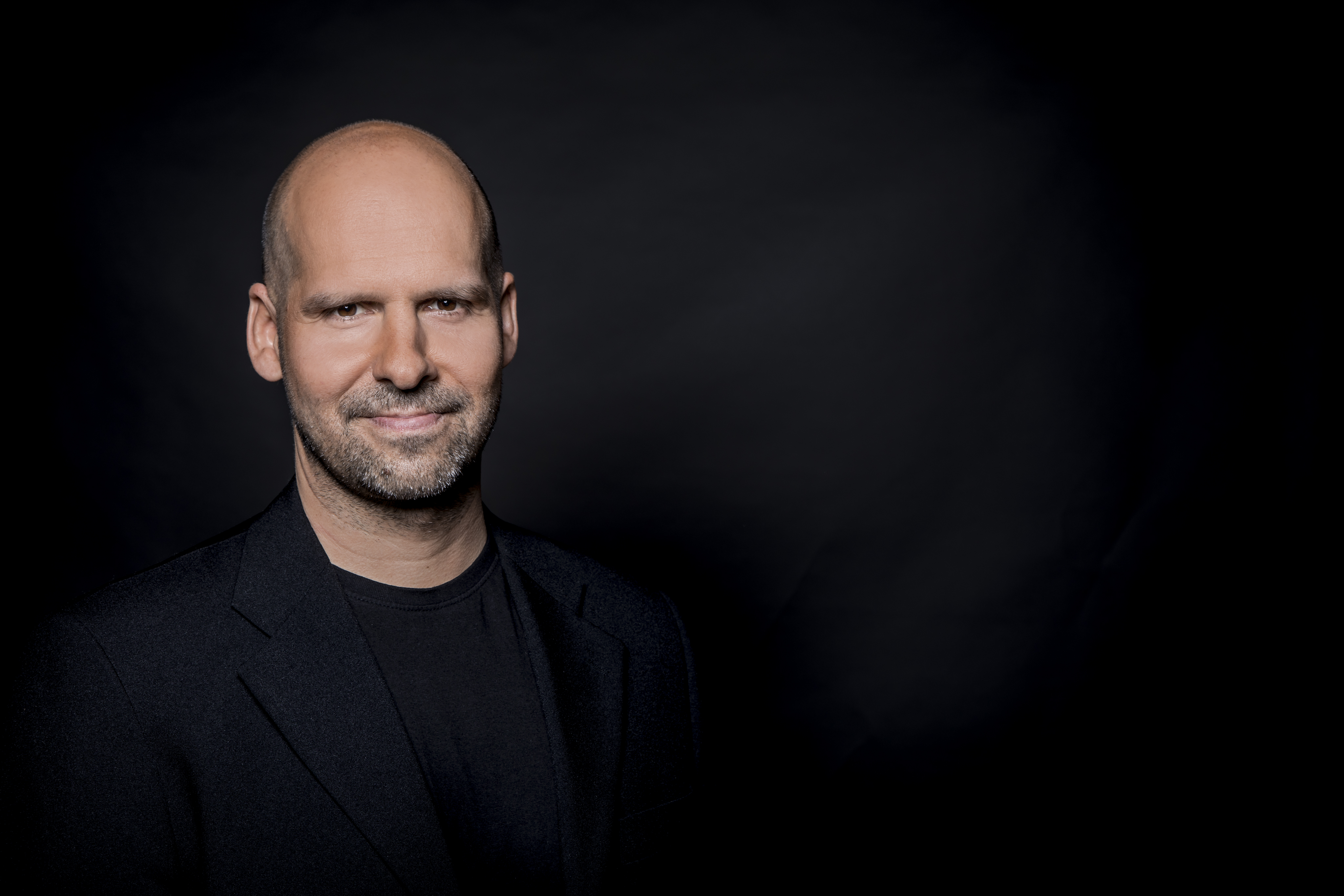
Ulrich Duve has passed the baton to Nico Thom
Ulrich Duve, the long-time director of the Klaus Kuhnke Archive, took his well-deserved retirement at the end of 2021. Nico Thom has been his successor in office since January 1, 2022.
Ulrich Duve has guided the fortunes of the archive for 30 years and contributed significantly to the current shape of KKA. Prior to that, he had already been an employee of the archive founded by Klaus Kuhnke, Manfred Miller and Peter Schulze for 5 years. He has thus dedicated almost his entire professional life to KKA, for which he deserves great thanks and recognition. Fortunately, he remains connected to the archive on an honorary basis, so that he will continue to be available with his expertise.
Nico Thom, the new head of the archive and institute, is a musicologist specializing in jazz and popular music. He has more than 15 years of professional experience in research, teaching as well as archive administration and is looking forward to the tasks that now lie ahead of him. "My goal is to work with my three part-time staff members to develop a center for the research and communication of popular music that will make the many treasures from the archive holdings even more visible and audible and secure them for the future - especially through digitization. I would also like to actively research the holdings myself. In addition, I am interested in an intensive exchange with the scientific and artistic community and would like to make the archive materials accessible to a broad public - at the University of the Arts, in Bremen and, of course, far beyond."
Previous Publication Projects (Selection)
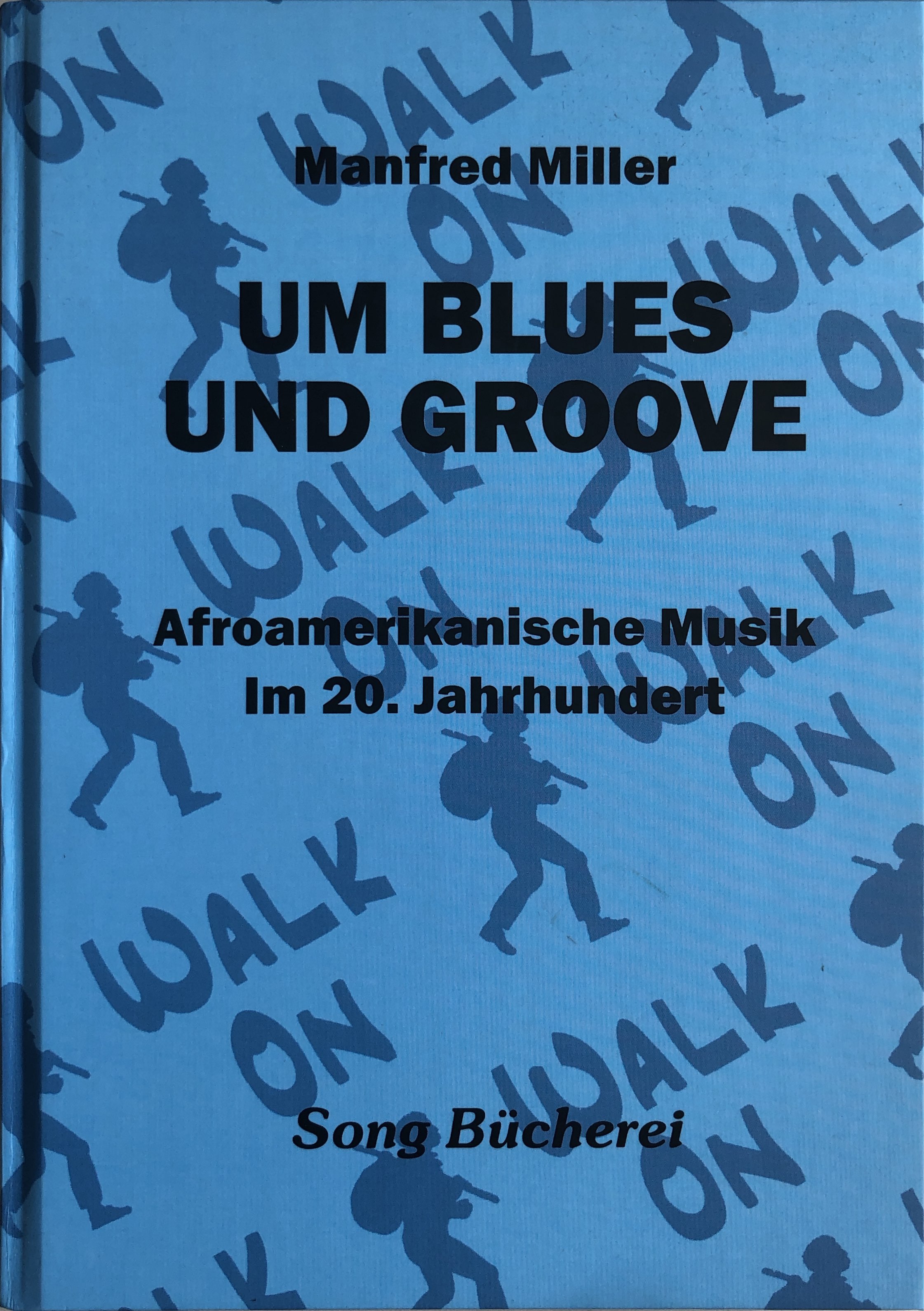
Manfred Miller: Um Blues und Groove. Afroamerikanische Musik im 20. Jahrhundert, Dreieich: Heupferd Musik 2017.
The opus magnum of our institution's co-founder, who died in 2021. A large-scale narrative of the origins and developments of popular music of the past century, in which African-American protagonists and the blues are at the center. Social historiography, musical and, above all, textual analysis are intimately linked in this publication.
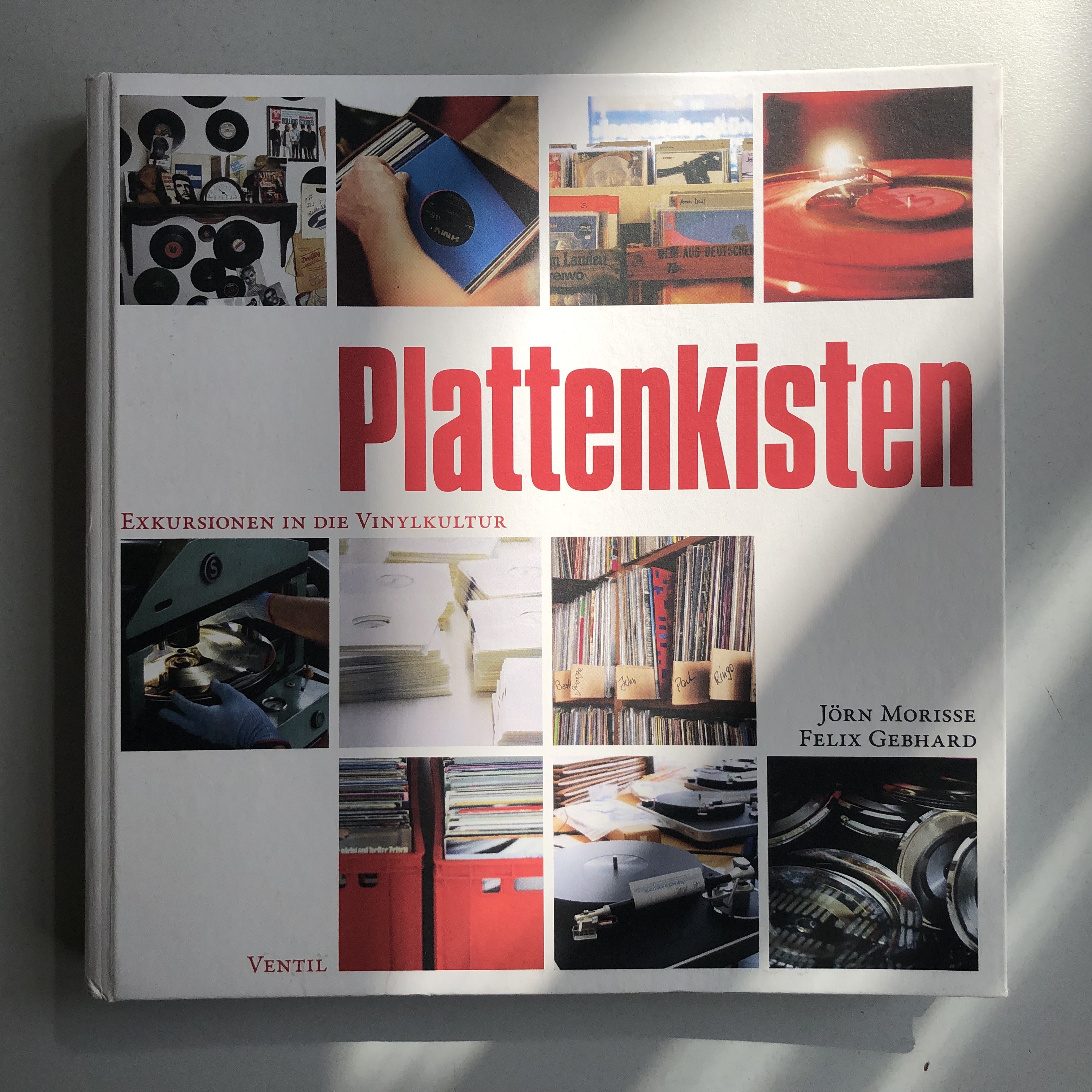
Ulrich Duve: "Das war eine richtige Umwälzung. Ulrich Duve, Geschäftsführer Klaus-Kuhnke-Archiv, Bremen", in: Plattenkisten. Exkursionen in die Vinylkultur", hrsg. von Jörn Morisse & Felix Gebhard, Mainz: Ventil 2015, S. 153-161.
The former and long-time director of our archive reports on the context of our institution and tells from the sewing box, especially with reference to the large record collection. The upheaval mentioned in the title of his interview contribution was the program "Roll over Beethoven" by the three archive founders, which was "one of the first radio formats in Germany that not only played pop music, but mixed it with politics and did not exclude the socio-historical background of the music". Tasteful photos from the archive are also included.
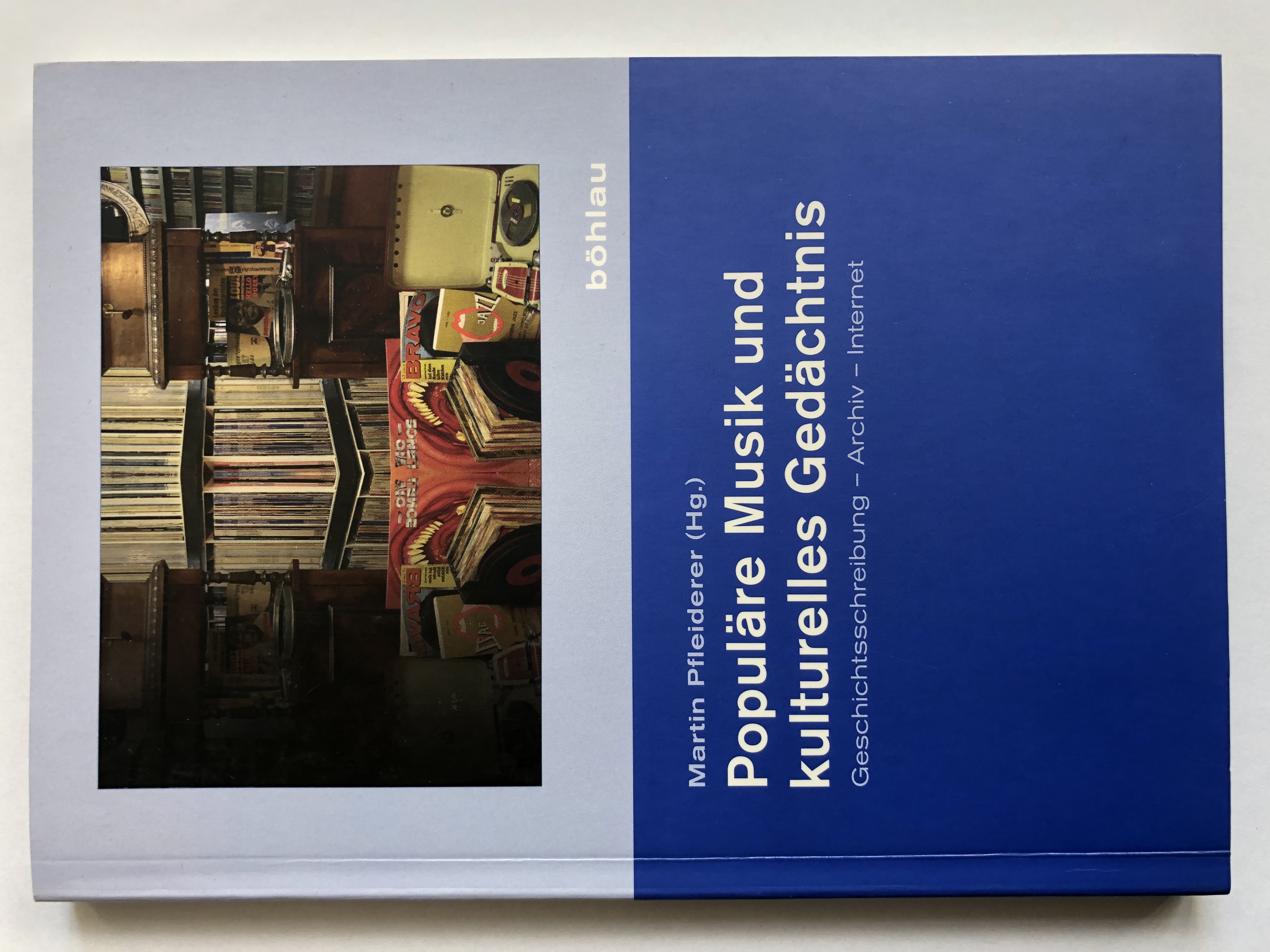
1) Ulrich Duve: "Die Datenbank des Klaus-Kuhnke-Archivs - mehr als nur ein Bestandskatalog" (S. 107-114),
2) Peter Schulze: "Die Musik kommt aus der Steckdose, aber wie kommt sie da hinein? Physische Archive in Zeiten der Entmaterialisierung von Tonträgern und öffentlichen Budgets. Fragen über Fragen" (S. 115-122),
3) Nico Thom: "Aktuelle Prozesse der Kanonbildung in multimedialen Magazinen Populärer Musik" (S. 65-82),
alle drei Beiträge in: Populäre Musik und kulturelles Gedächtnis. Geschichtsschreibung - Archiv - Internet, hrsg. von Martin Pfleiderer, Köln/Weimar/Wien: Böhlau 2011.
In his article, archive founder Peter Schulze declares physical music archives to be an indispensable back-up for the Internet and the digital age. Ulrich Duve introduces the online catalog of our archive and makes clear that it can do more than just spit out individual titles; it can also be used to create discographies. Nico Thom describes the multi-layered, multimedia canonization processes of music magazines. In this way, the first historical meeting of the three KKI members is documented, who met in 2010 at a conference in Eisenach, from which this conference volume emerged.
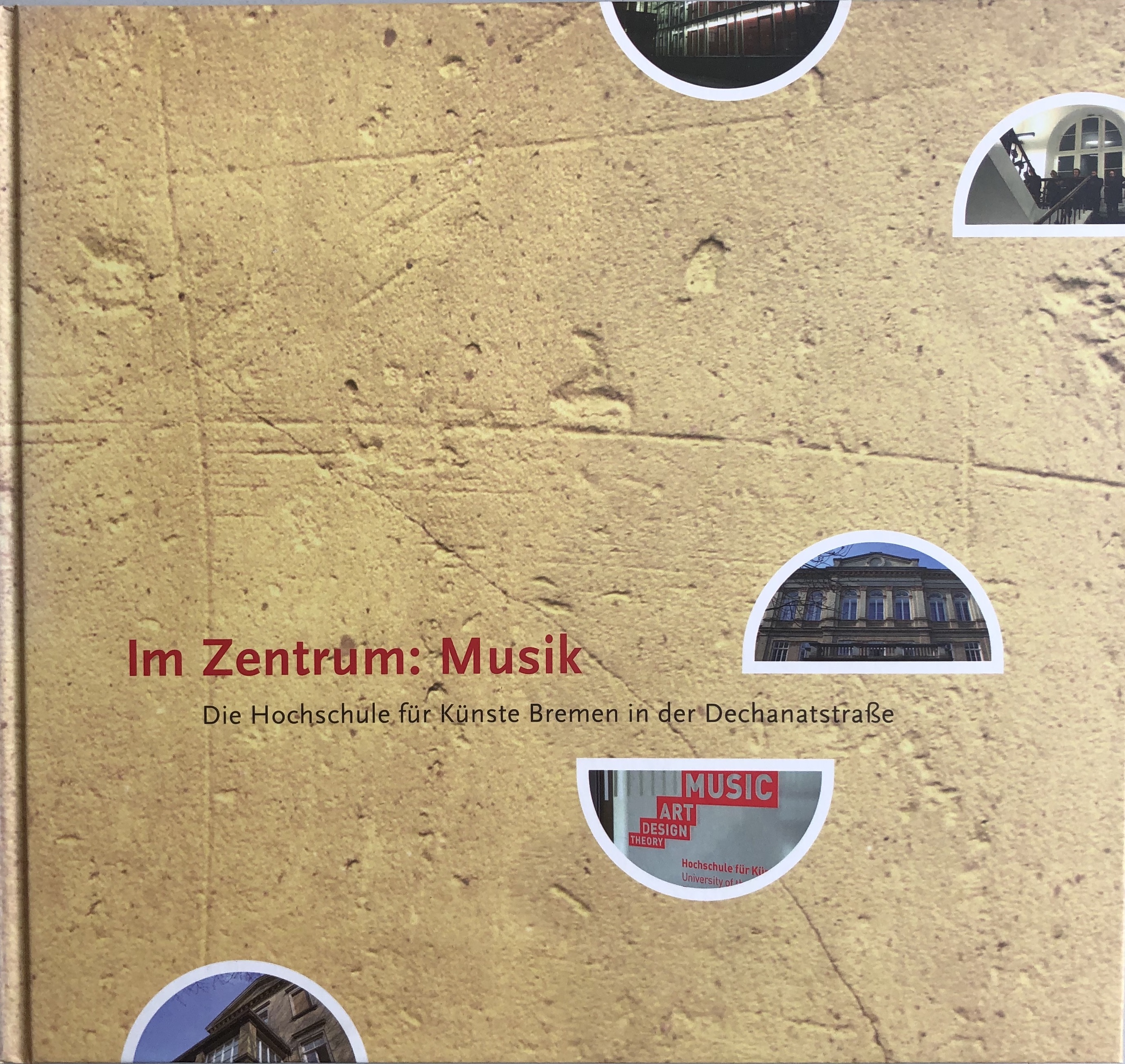
Ulrich Duve: "Von Johann Strauß bis zu den Sex Pistols. Das Klaus-Kuhnke-Archiv für Populäre Musik", in: Im Zentrum: Musik. Die Hochschule für Künste Bremen in der Dechanatstraße, hrsg. von der Hochschule für Künste Bremen, Bremen: Verlag H.M. Hauschild 2006, S. 122-123.
Ulrich Duve provides a compact account of our archive. The occasion for the anthology of the UA Bremen was the new building for the Department of Music in the center of the city.
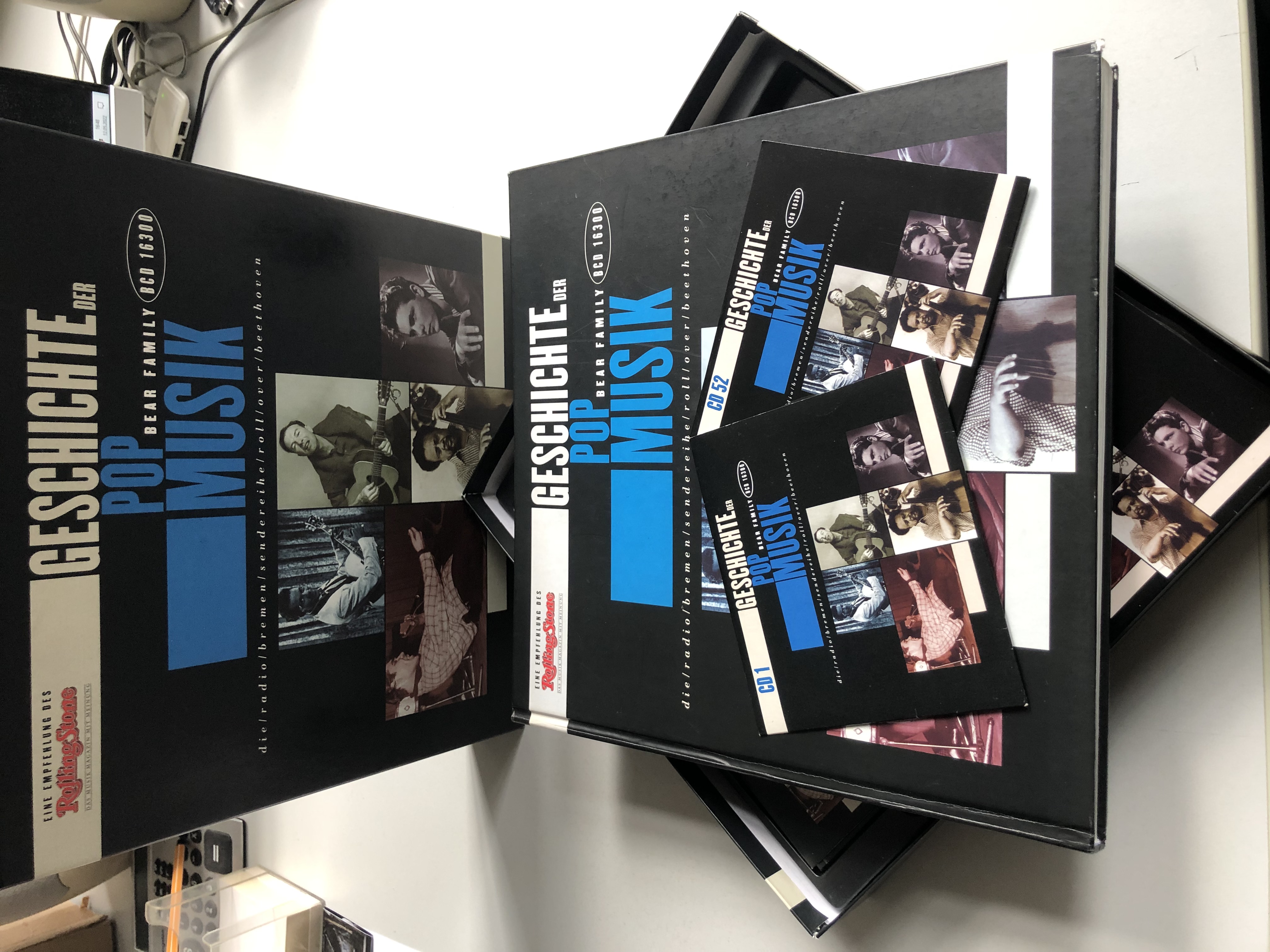
Manfred Miller & Peter Schulze (Hg.): Geschichte der Popmusik (Band 2). Die Radio Bremen Sendereihe roll over beethoven, Hambergen: Bear Family Records 1998.
Perhaps the centerpiece of our publication history to date. In 1998, the two remaining authors - Klaus Kuhnke had died in the meantime - published the broadcast manuscripts of the second part of the legendary broadcast series "Roll over Beethoven", which was produced and broadcast in the eighties. The cooperation with Richard Weize or Bear Family Records resulted in a lavishly designed box with 52 CDs, which was offered for sale at the end of the nineties for a fabulous 1,000 Marks. The demand was there, anyway. To this day, it is a coveted collector's item that has made history - in both senses of the word.
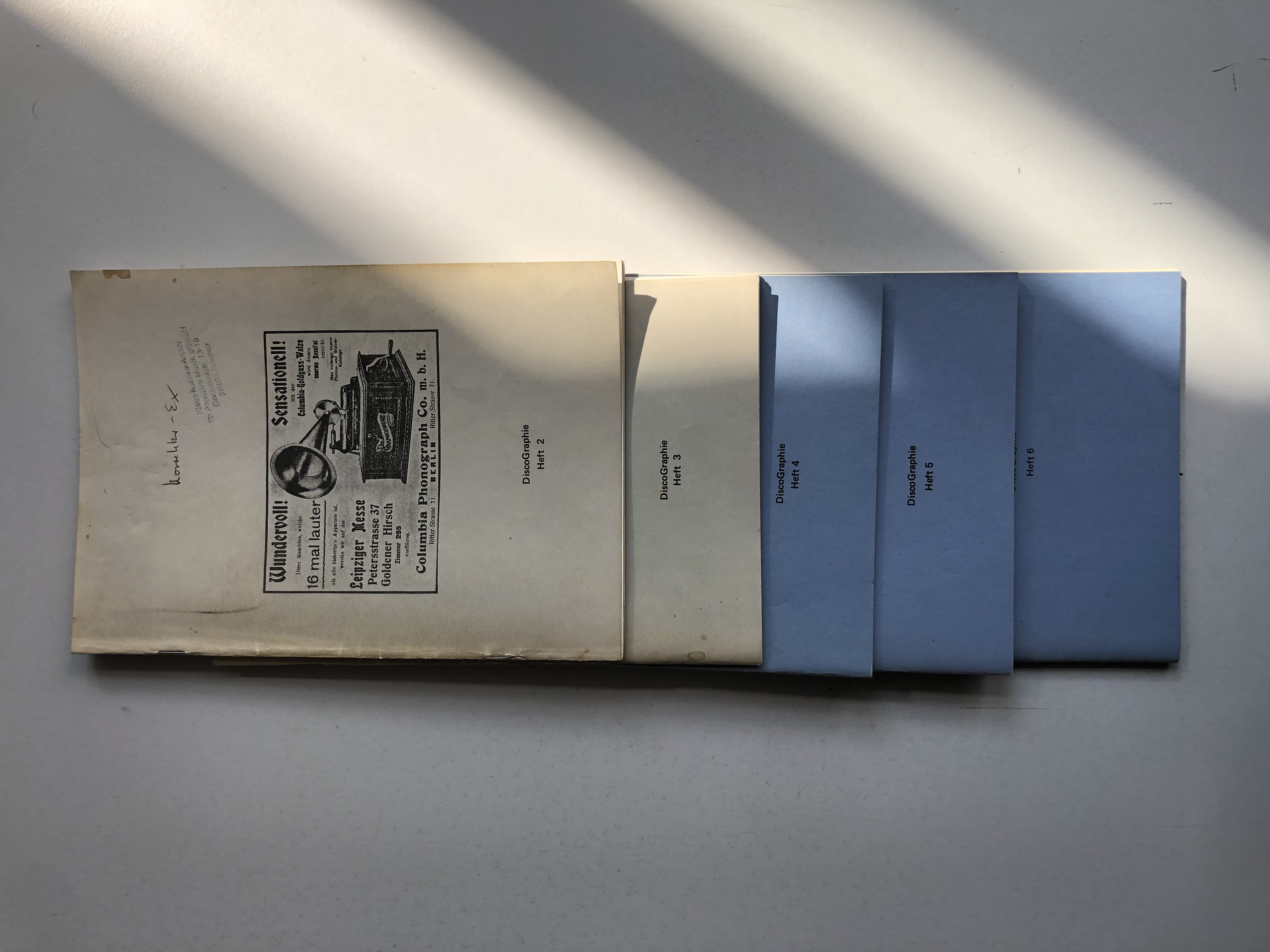
DiscoGraphie, Heft 1-6 (1982-1985), hrsg. von Klaus Kuhnke & dem Archiv für Populäre Musik in Bremen.
Quasi on his own Klaus Kuhnke has published a small collection of discographies over three years. Each booklet (or each monograph, since it has an ISBN number) is 48 pages long. Kuhnke lists sound carriers, as is customary for discographies, and provides important information on record labels, release dates, matrix numbers, etc. He also provides some contextual information on individual artists or bands. Even photos and graphics can be found in the booklets. Here and there there is talk of a so-called "German National Discography"... an idea that the founders of the archive had in mind for some time, but which could only be put into practice in the end - among other things because of the death of Klaus Kuhnke a few years later.
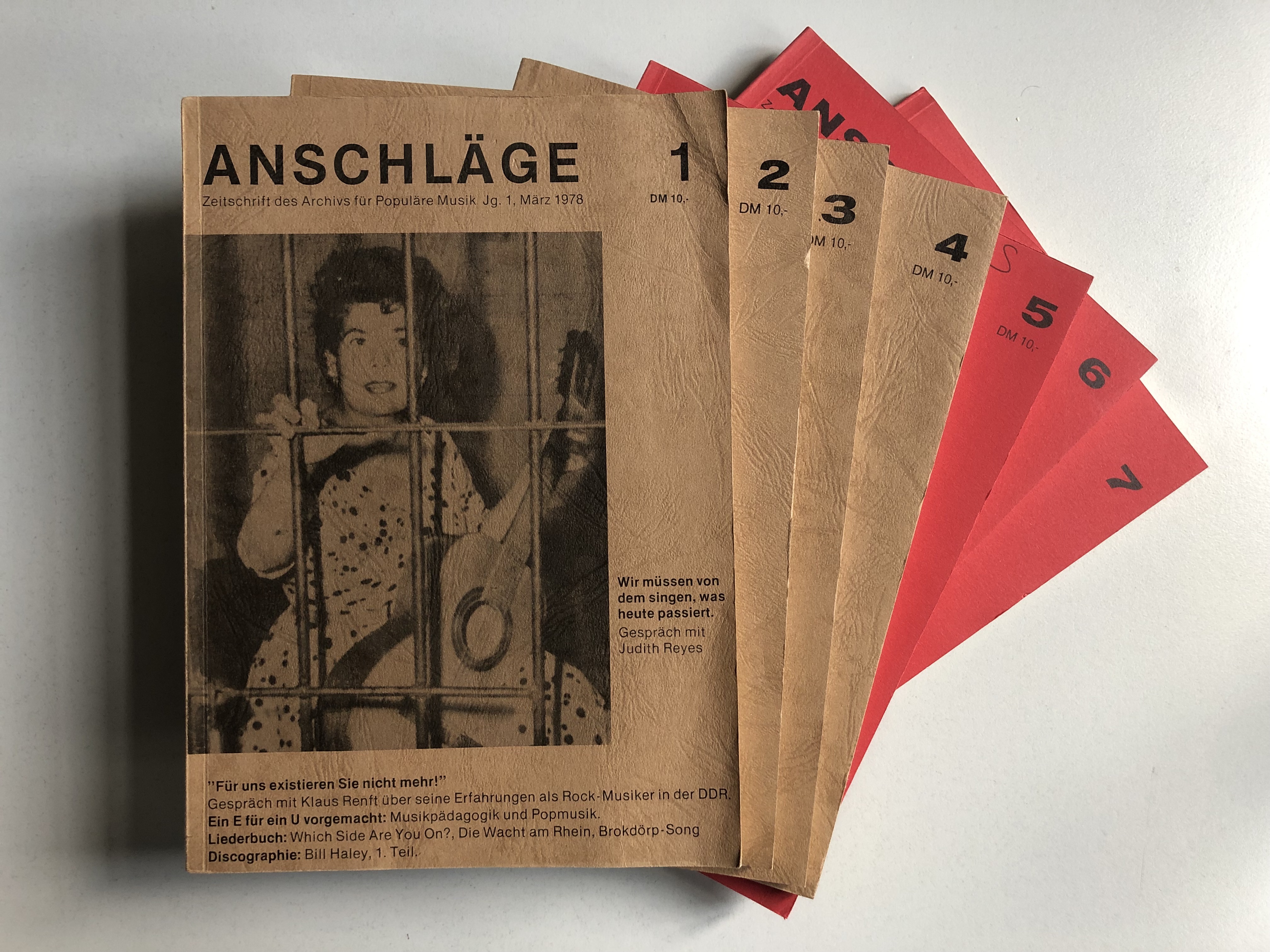
Anschläge. Zeitschrift des Archivs für Populäre Musik in Bremen, 7 Hefte (1978-1981).
The three founders of the archive realized an ambitious publication project with their own journal, which produced seven issues in four years (four of them in the first year!). They themselves acted as editors and authors, along with other contributors. Larger and smaller contributions, interviews, text analyses, record and book reviews as well as discographies and bibliographies were published, some of them illustrated. A historical testimony for politically-moved and in the cause engaged music journalism on the border of journalism and science.

Klaus Kuhnke, Manfred Miller & Peter Schulze: Geschichte der Pop-Musik, Band 1 (bis 1947), Lilienthal/Bremen: Eres Edition & Archiv für Populäre Musik 1976.
This is a revised new edition of the already published first part of the radio series "Roll over Beethoven", which dealt with popular music up to 1947. The first edition was published by the same publisher as a loose-leaf collection. Here, the book format was chosen.
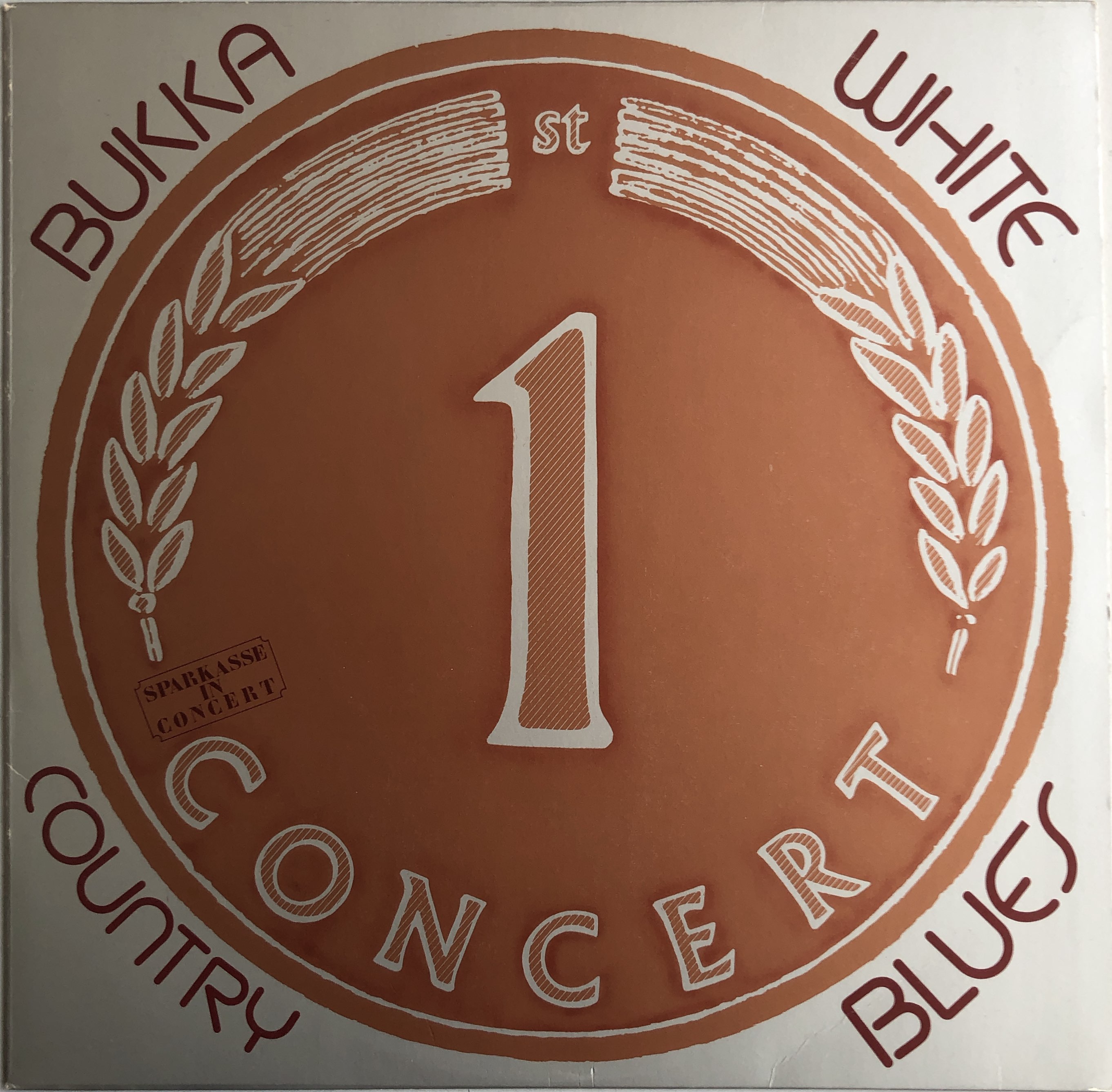
Bukka White: "Country Blues. Sparkasse in Concert", Bremen: Archiv für Populäre Musik 1975.
The three founders of the archive, in addition to magazines and books, also released records; two to be exact. This is the first record from the founding year of the archive. It features US singer/guitarist Bukka White and his traditional Mississippi blues. The musician is very elderly at this point and has been pronounced dead several times (literally!). This recording is the recording of a concert in Bremen, which was financed by the Bremer Sparkasse and recorded in cooperation with Radio Bremen. Peter Schulze acted as recording supervisor.
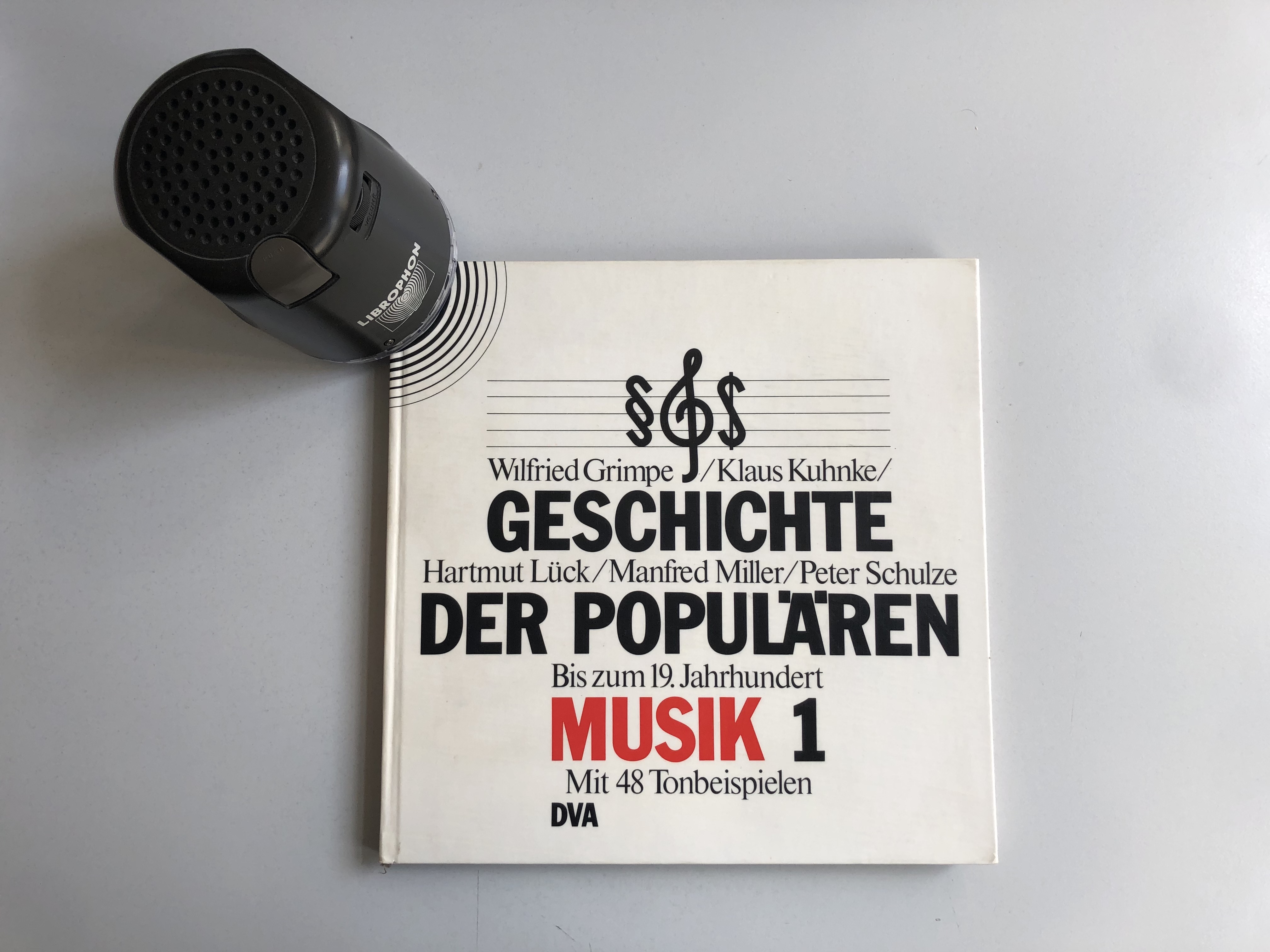
Wilfried Grimpe, Klaus Kuhnke, Hartmut Lück, Manfred Miller & Peter Schulze: Geschichte der Populären Musik. Band 1: Bis zum 19. Jahrhundert, Mit 48 Tonbeispielen, Stuttgart: Deutsche Verlags-Anstalt 1974.
A curiosity, this publication. With an enormous development effort, this volume was to be a six-volume book series based on a new format, the so-called "phonobook. In addition to text and pictures, a "third dimension" was to be added, namely the tones or sound. For this purpose, a small device was specially developed in Japan that made it possible to play the sound foils integrated into the book. One could simply place the device on the respective sound foil and start listening. Actually a great idea, but unfortunately much too expensive to produce. That's why the publisher stopped production shortly after the first copies were printed, even though they had presented it with a lot of pomp at the Frankfurt Book Fair. Basically, this (phono) book never reached the book market, so that the few copies that exist have become rarities.
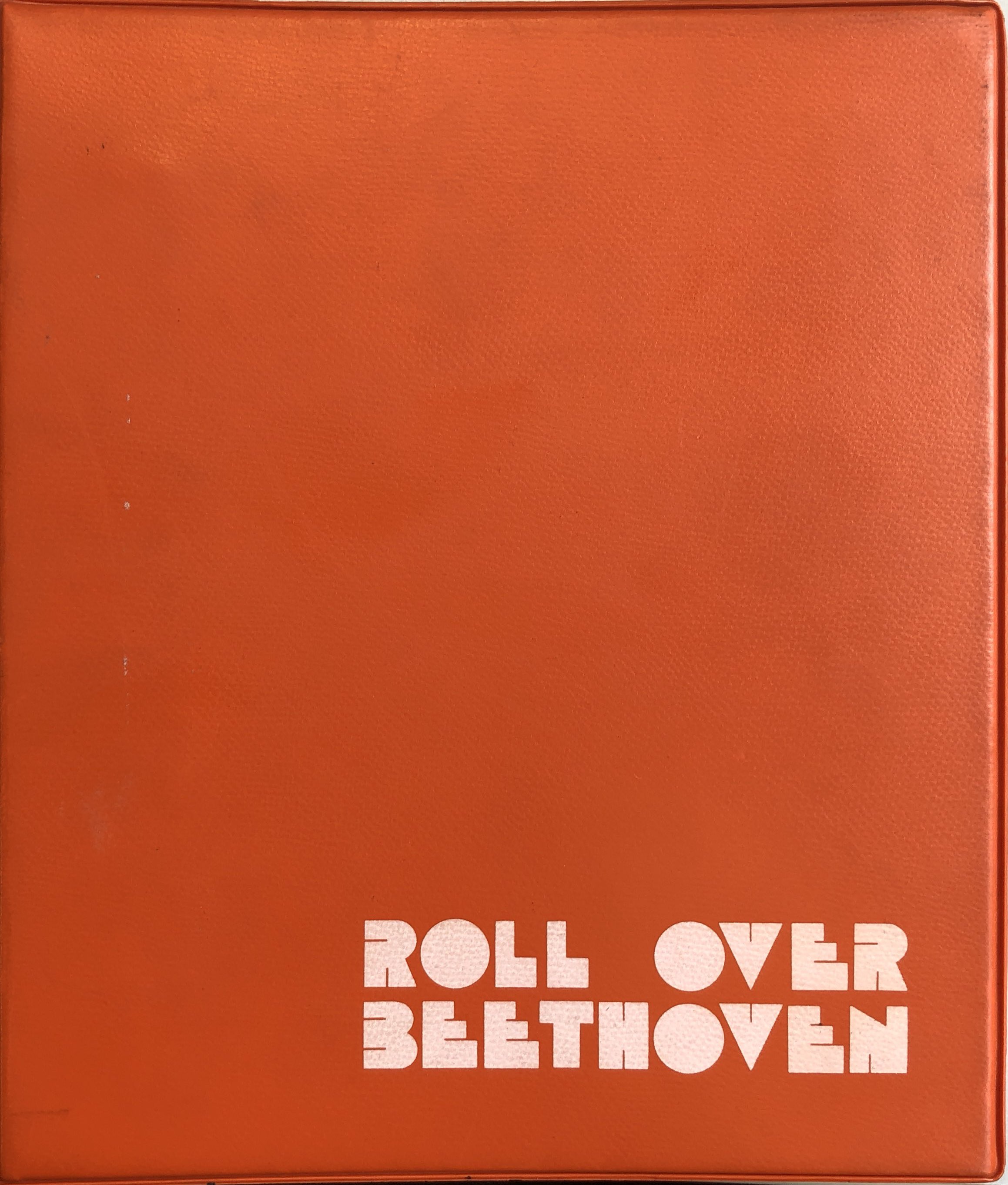
Klaus Kuhnke, Hartmut Lück, Manfred Miller, Tom Schroeder & Peter Schulze: Roll over Beethoven. Zur Geschichte der Populären Musik, Teil 1, Lilienthal/Bremen: Edition Eres 1973.
The first publication in which - among others - all three archive founders (Kuhnke, Miller & Schulze) participated. It was based on the radio series "Roll over Beethoven" on Radio Bremen (later also on NDR and WDR). Due to the success of the radio program, which was broadcast from 1973, a loose collection of sheets with broadcast manuscripts was produced in the same year, which listeners could order from the broadcasting station.